NOTE: For prior parts in the Hizballah Cavalcade series you can view an archive of it all here.
—
Al-Quwat al-Ja’afariyah & Liwa al-Sayyida Ruqayya: The Building of an “Islamic Resistance” in Syria
By Phillip Smyth
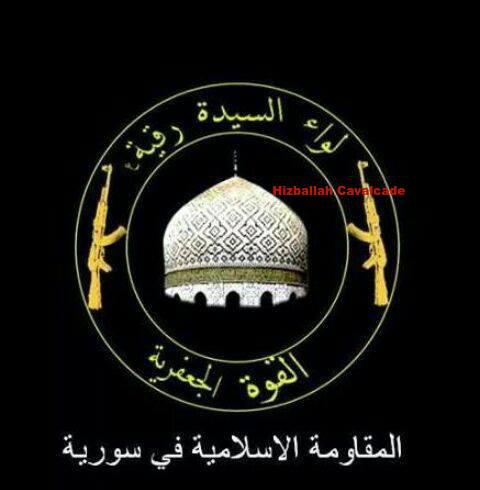
Figure 1: The logo belonging to Al-Quwat al-Ja’afariyah’s Liwa al-Sayyida Ruqayyah. The symbol features two golden Kalashnikov-type rifles flanking the white dome of the Sayyida Ruqayyah shrine. The group’s logo bears many similarities to Kata’ib Sayyid al-Shuahda’s. Both feature a shrine dome in the center of a roundel flanked by Kalashnikov-type rifles.
Since the creation of Syria’s pro-Assad National Defense Forces (NDF), there has been a rise in Syria-based sectarian militia groups with Iranian training and advisors. Al-Quwat al-Ja’afariyah (The Ja’afari Force) has attempted to market itself as one of these types of organizations. The group has also described itself as “al-muqawama al-islamiyah fi suriya” (“The Islamic Resistance in Syria”) and has pushed its own Shia identity mixed with pro-Assad Syrian nationalist and pro-Iranian proxy material. These elements of group identity suggest the militia pulls members from Syria’s small Shia community while still being influenced by external allied actors.
A process where local pro-Assad militias have been modeled off of Lebanese Hizballah has been a continuing development. This has especially been the case with Alawite-manned and Shia-manned militias. Syria’s first major Shia militia, Liwa Abu Fadl al-Abbas (LAFA) maintained close links to the Assad regime and Lebanese Hizballah. Even with Lebanese Hizballah’s aid, local actors such as LAFA’s secretary general, Abu Ajeeb, generally led LAFA’s command and control functions.
Unlike many of the other groups which have also worked closely with Lebanese Hizballah, Al-Quwat al-Ja’afariyah has also claimed to be a Syria-based subdivision belonging to the Iraqi Shia Iran-proxy, Kata’ib Sayyid al-Shuhada (KSS).
A number of Syria-based Shia militias have their own Iraqi wings and some Iraqi Shia political parties have external branches. Nonetheless, Al-Quwat al-Ja’afariyah is the only Syrian Shia militia which has declared itself as a sub-division of an Iraq-based Iraqi Shia Islamist group, yet began life as a component of an established Assad element (the NDF).
The first prominent mentions of Al-Quwat al-Ja’afariyah or its professed sub-militia Liwa al-Sayyida Ruqayya came with the April 6, 2013 death of NDF leader Shaker Rashid Darwish (A.K.A. Al-Ja’afari). Despite the group being around for a number of years, it lacked a formal announcement or acknowledgement outside of a small number of accounts on social media. At different times throughout 2014, the group’s members would often pose for photos in their battle dress uniforms. These photos regularly found their way onto mediums such as Facebook and could only be accessed via private Facebook profiles.
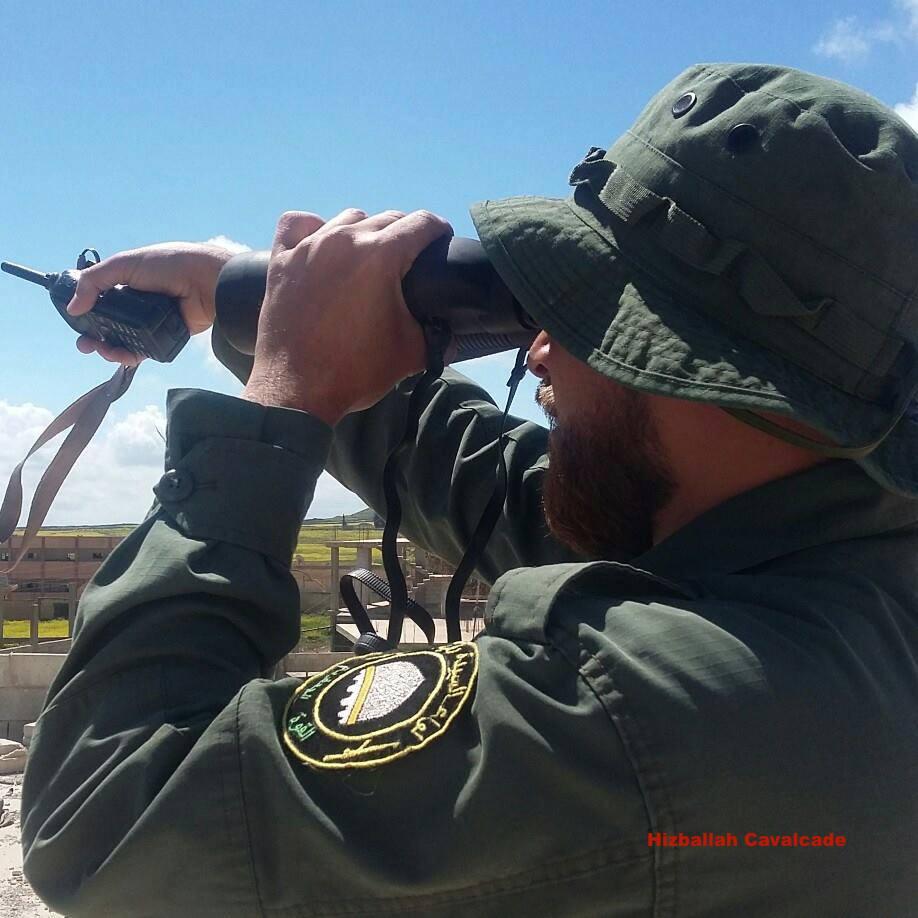
Figure 2: A militiaman belonging to Liwa al-Saqiyah Ruqayya wearing the group’s distinctive patch.
What set these photos aside from other uploaded images of Syrian and Iraqi Shia militiamen in Syria was that these fighters’ uniforms would feature unique patches. This patch included the group’s name along with a stylized version of the white dome of the Sayyida Ruqayya shrine in Damascus, Syria.
By late August 2015, due to an increased public presence by Al-Quwat al-Ja’afariyah on social media (via KSS’s own media apparatuses), and due to the death of Quwat al-Ja’afariyah commander Hasan Kana’an, more attention was granted by Arabic-language (primarily pro-Syrian rebel) media sources. In early July, Liwa al-Sayyida Ruqayya established a number of public Facebook pages and was also mentioned in a September 2015 piece by The Guardian (albeit, the group was incorrectly recognized as the “Sayyida Ruqayya Martyrs Brigade”).
What’s In A Name?
The term, “Ja’afari”, helps highlight Al-Quwat al-Ja’afariyah’s denominational membership. “Ja’afari” is often used as a synonym for “Shia Muslim”. Moreover, in the Twelver Shia tradition, Ja’afar al-Sadiq is considered the sixth and longest serving Imam. The majority of Shia Muslims also adhere to the Ja’afari school of jurisprudence.
Liwa Sayyida Ruqayya gets its name from the Sayyida Ruqayya mosque and shrine. Located in Old Damascus, the Sayyida Ruqayya mosque and shrine houses the remains of Sukayna (a.k.a. Ruqayya), the baby daughter of Twelver Shia Islam’s third Imam, Husayn ibn Ali.
Built in 1985 with Iranian funds, the design of the mosque was described by Iran analyst Nigel Coulthard as, “a pure example of post-revolutionary Iranian architecture that would have been more at home in Tehran than Damascus”. Sociology professor Marnia Lazreg claimed a Syrian policeman told her that the mosque, “was controlled by the Iranian government, which claimed its spiritual ownership.” Design and theological/political control aside, the shrine is one of Syria’s major Shia shrines.
Liwa al-Sayyida Ruqayya & The Militia’s Stages of Development
The main militia falling under the header of Al-Quwat al-Ja’afariyah is Liwa al-Sayyida Ruqayya (The Brigade of Sayyida Ruqayya). At the time of this writing, no other groups have yet been listed as under Quwat al-Ja’afariyah’s umbrella. The continual grouping of these two elements suggests that the groups may be one in the same, as opposed to it being a legitimate sub-militia which reports to a larger umbrella-style grouping or a parent organization.
Liwa al-Sayyida Ruqayya has claimed to be active in the Midan section of southern Damascus and to have fought in Jobar, Otaiba, Dekhania, and other sections to the north and east of Damascus. The group was also deployed to Shaykh Miskin in southern Syria.
Family connections between the group’s members is another noticeable trend. This speaks to how recruitment seeks new members and also shows the limited numbers from which it can recruit. During the militia’s participation in the November 2013 battles around Otaiba, Ali Mahmoud Darwish (A.K.A. Karar) and the 16 year-old fighter, Jawad Abbas Darwish (A.K.A. Abu Turab), were both killed. Reportedly, these fighters were cousins and were likely related to Shaker Rashid Darwish.

Figure 3: The Liwa al-Sayyida Ruqayya martyrdom poster for Hasan Ahmed Kana’an. He is listed as a “martyr commander”. Additionally, Liwa al-Sayyida al-Ruqayya is described as, “The Islamic Resistance in Syria”. Interestingly, despite the group’s links to Irqi KSS, on this poster the “Islamic Resistance in Syria and Lebanon” is mentioned and not the“Islamic Resistance in Iraq”.
There were number of developmental stages for the current Quwat al-Ja’afariyah and Liwa al-Sayyida Ruqayya. The first began with its inception as an NDF sub-militia in 2013. Then, the group’s fighters appeared under a number of different monikers. These names included, Huras al-Sayyida Ruqayya (The Guardians of Sayyida Ruqayya) and Liwa Ansar al-Husayn (The Brigade of the Supporters of Husayn). Whether these groups are still in existence, were little more than temporary fronts, or are elements of other units is unknown.
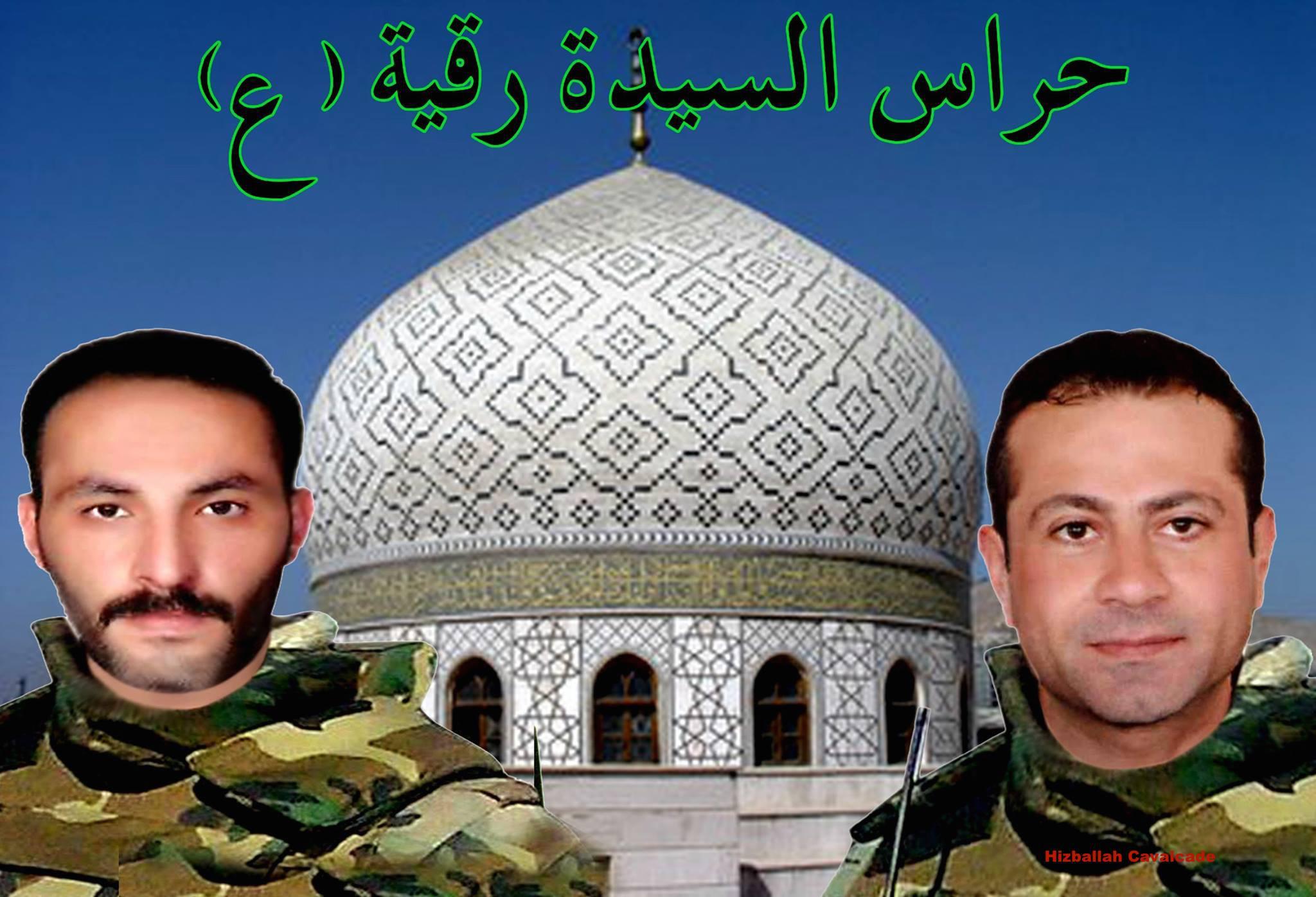
Figure 4: A “martyrdom” poster featuring killed Liwa al-Sayyida Ruqayya members under the header, “Huras al-Sayyida Ruqayya”.
Still, during this initial stage, there was more direct linkages to the NDF and the Assad regime. Images promoting pro-Assad Syrian nationalism were a regular feature. The second stage of development, which immediately followed (if not coincided with the first), was the addition of links to Lebanese Hizballah. “Martyrdom”
Category: Kata’ib Sayyid al-Shuhada
Hizballah Cavalcade: Quwat Sahl Nīnawā: Iraq’s Shia Shabak Get Their Own Militia
NOTE: For prior parts in the Hizballah Cavalcade series you can view an archive of it all here.
—
Quwat Sahl Nīnawā: Iraq’s Shia Shabak Get Their Own Militia
By Phillip Smyth
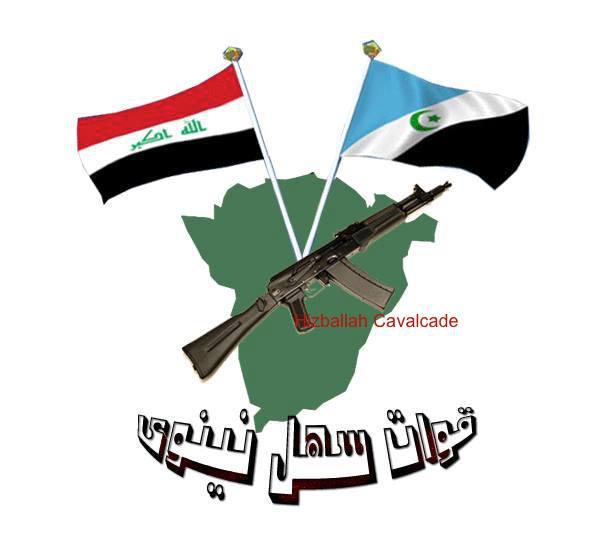
Figure 1: Quwat Sahl Nīnawā’s logo. The Iraqi (left) and Shabak (right) flags emerge out of a map of the Hamdaniya region of the Nineveh Plain. The symbol also features an AK-102 rifle.
Quwat Sahl Nīnawā (A.K.A. Liwa Sahl Nineveh or QSN) purports to be a Shia Shabak militia associated with the Democratic Assembly of Shabaks (Tajema’ al-Shabak al-Dimokrati or DAS).1 QSN announced itself via a November 23, 2014 official statement posted on the website and social media apparatus belonging to the DAS. The group has also already claimed to take casualties in the fight against the Sunni jihadist “Islamic State” (A.K.A. IS, ISIS, or ISIL).2
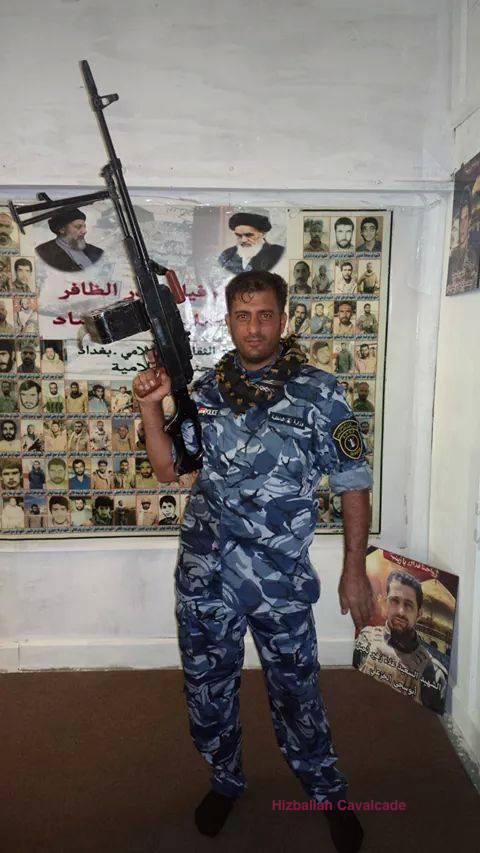
Figure 2: A QSN fighter poses with martyrdom posters (one featuring the dome of Sayyida Zaynab in Syria – bottom right) and other posters featuring Badr Organization founder Ayatollah Muhammad Baqir Sadr and the first Iranian Supreme Leader Ayatollah Khomeini.
Present in the symbols and photos, QSN mixes a limited quantity of Shabak particularism and an added emphasis on Shia identity. On some pages the group has simultaneously promoted links to Iran’s proxy forces. While the group may have relations with Iran’s proxies, its official statements have announced a commitment to “gladly serve the supreme religious authority in Najaf [Grand Ayatollah Sistani].”3 This would likely indicate the group is not an equivalent (in terms of ideology and/or levels of control) to newer Iraqi Shia Iran-proxy militias such as Hizballah al-Abrar.
Photos claiming to show the group training also indicate that they may be assembled along the lines of a “Popular Assembly/Mobilization” or “al-Hashd al-Sha’abi” type group. Photographs of claimed QSN fighters holding flags promoting al-Hashd al-Sha’abi add further credence to this likelihood. Organization along those lines would mean many of the fighters are possibly newer recruits trained and likely led by more experienced personnel and advisors.
In photos of QSN, around 100 fighters were shown posing in ranks. This suggests the numbers for the group are likely in the range of 100-500 combatants.
The creation and promotion of the group may exemplify another method Iran and its proxies are using to place pressure on Kurdish organizations. QSN, as organized along lines of the more dominant Iraqi Arab Shia militias in the south of the country, also demonstrates the direction in which other new militias may be organized. QSN further exemplifies how some of Iraq’s minority groups are mobilizing against ISIS.
The Name & Symbols
QSN’s name directly refers to an area of heavy Shabak habitation, Iraq’s Ninewa (or Nineveh) Plain. Their logo and a post by the Shabak Democratic Assembly describes the group as “Quwat Sahl Nīnawā” or the “Nineveh Plain’s Forces.”4 Albeit, via social media, one page purporting to belong to the group claimed it also went by the name of “Liwa Sahl Nīnawā” or the “Nineveh Plains Brigade”. However, such minor alterations in name are common during the early stages of many new militias.5
The group’s logo also demonstrates a rather rudimentary approach to create symbolism for the new group. Readily available images (including the pictures of an AK-102 rifle, the Shabak and Iraqi flags, and a map of the Hamdaniya area of the Nineveh Plains) were likely pasted together following a simple image search online.6

Figure 3: A QSN fighter poses with a flag associated with the Popular Mobilization type militias.
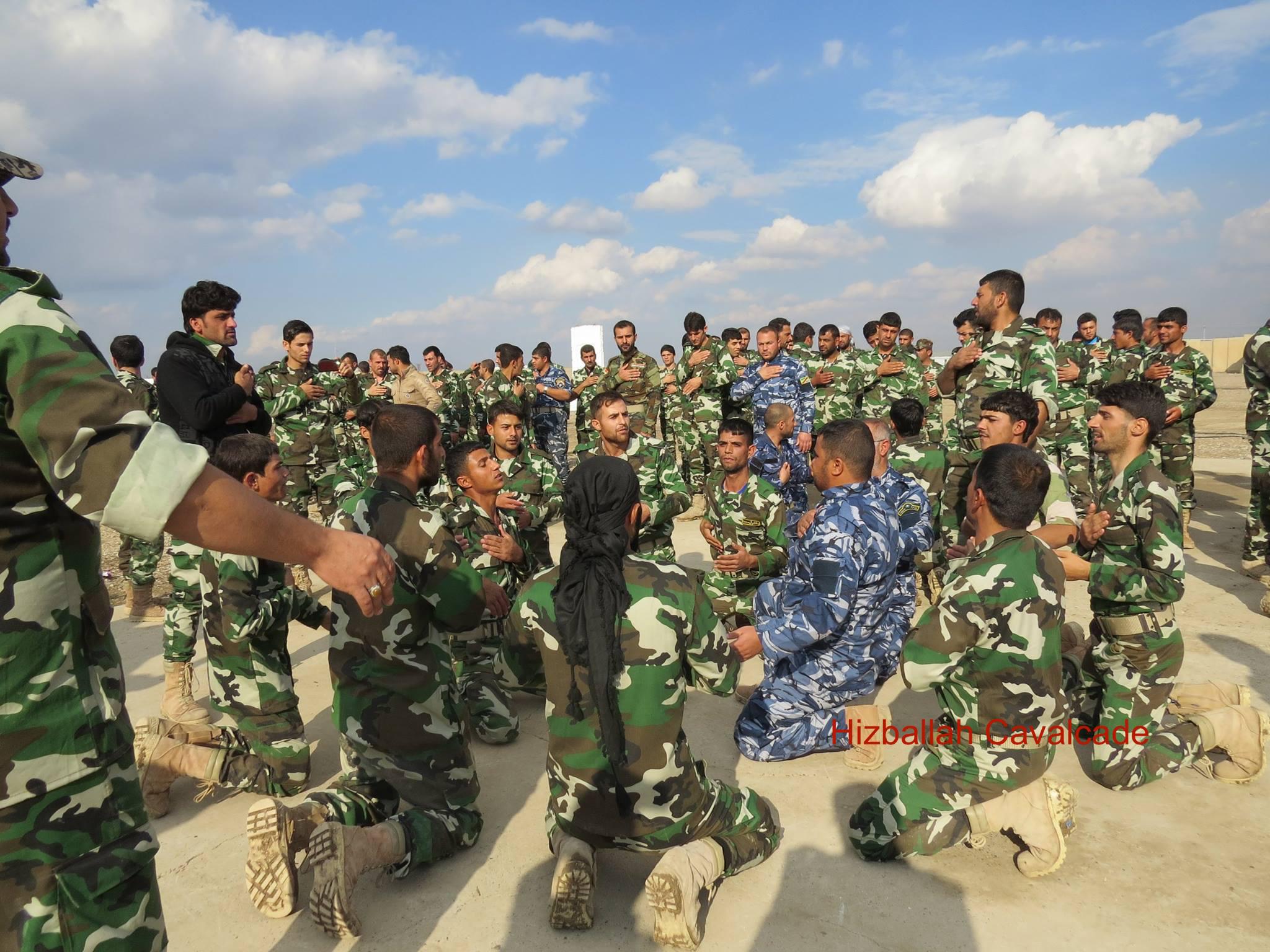
Figure 4: QSN fighters congregate.
Who Are the Shabak & What is the Nineveh Plain?
The Nineveh Plain is a minority rich area; home to the Shabak, numerous Christian sects (including the Assyrians, Chaldeans, and Syriac Orthodox and Syriac Catholics), Turkmen, Yezidis, and Kurds.7 Considered a heartland for Iraq’s Christians, Assyrian Christian and other Syriac (Aramean, Syriac, and Chaldean) Christian nationalist organizations and political parties have pushed for autonomy in the area.8 There has also been a campaign to make the Nineveh Plain its own province (under primarily Christian leadership) within the Iraqi federal framework.9 Nevertheless, the Plain has not been granted a truly autonomous standing.
Many Shabak insist they have a unique ethnic identity, which is neither Arab nor Kurd (albeit, primarily non-Kurdish).10 The group also speaks its own language, Shabaki.11 Most Shabak are also religiously (Twelver) Shia.12
Within the Nineveh Plain, the Shabak primarily live in villages to the east of the city of Mosul, in the Hamdaniya area, and a few thousand also lived in the city of Mosul (before the invasion). Due to ISIS advances, many Shabak hamlets have been overrun.
The Democratic Assembly of Shabak & Issues With the Kurds
While QSN was ostensibly created as a Shabak arm to fight back ISIS threats and offensives targeting the Shabak, there are other underlying trends present with the creation of the militia associated with Shabak-Kurdish relations.
Kurdish groups have shown interest in further incorporating areas of Shabak habitation into Kurdistan.13 As early as 2008, minority groups including the Shabak claimed there was an effort to “Kurdify” areas they inhabited.14
Along with the promotion of a separate non-Kurdish identity, the DAS’s leader and parliamentarian Hanin Qaddo has specifically called out Kurdish parties for claimed abuses against the Shabak. In 2008 Qaddo opposed the incorporation of Shabak inhabited areas into Iraqi Kurdistan.15 Two years later, Qaddo denounced the Kurdish Democratic Party (KDP) for “intimidating” Shabak voters.16 In 2012 the Shabak leader demanded the expulsion of Kurdish and Christian armed forces from the Nineveh Plain.17
With this in mind, QSN’s establishment also recalls the 2012 decision by then Iraqi Prime Minister Nouri al-Maliki to allow for the creation of a 500-man Shabak militia force referred to as, “The Shabak Regiment of Doom.”18
For their part, many Kurdish political leaders have not been supportive of independent Shabak efforts to create their own militias. Nevertheless, some of those Kurdish apprehensions were downgraded following the ISIS advance. Thus, QSN has not been the only Shabak armed group to come into existence. However, its other counterpart is under the control of Kurdish military commanders.19 Whereas QSN is organized along lines set by Baghdad-supported Shia militias and Iran’s proxy groups and does not appear to be taking order from Kurdish commanders.
Tensions between QSN’s DAS parent party and Kurdish parties may explain for QSN’s retention of its independence. The DAS, the largest Shabak Party, is also part of the ruling Iraqi State of Law Coalition. This is the same coalition which included former Iraqi Prime Minister Nouri al-Maliki, the current Iraqi Prime Minister, the Badr Organization and Kata’ib Sayyid al-Shuhada, among other Iranian proxy groups. Nevertheless, Qaddo has “wavered between the Hakim and Maliki factions,” and then ran on the Badr Organization’s electoral list.20
The increase in Iranian proxy cooperation via training, equipping, and other support also speaks to other issues related to Iran’s and their proxies’ policies in Iraq. The policies in question are particularly focused on Kurdistan. From the summer of 2014 until the present, there has been increased tension between Iran’s Iraqi Shia proxies and Kurdish Peshmerga forces.21 Additionally, Iran’s proxies have also threatened Kurdish leaders such as Masoud Barzani.22
A push for support for a group which has already had problems with Kurdish leadership seems to be another avenue for Tehran to exert pressure on the Kurds. Nevertheless, QSN’s main goals and activities have and will likely remain oriented against the existential threat that is ISIS.
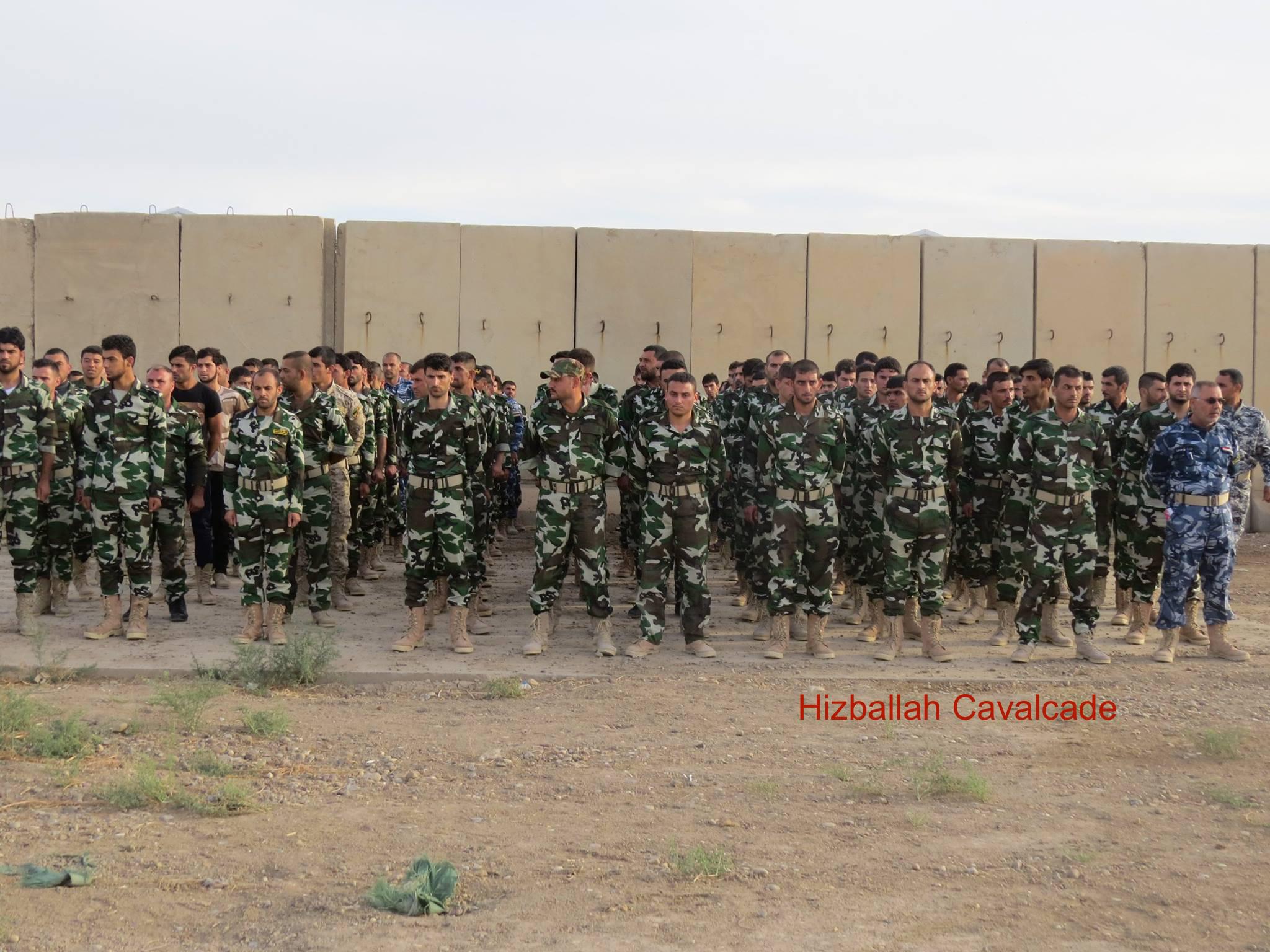
Figure 5: Around 100 QSN are shown in this photo.

Figure 6: QSN Martyrs are shown on a poster featuring the dome of Syria’s Sayyida Zaynab. It is possible the dome was included by graphics designers to demonstrate that the fight in Syria and Iraq, marketed as “protection for shrines”, are one in the same.
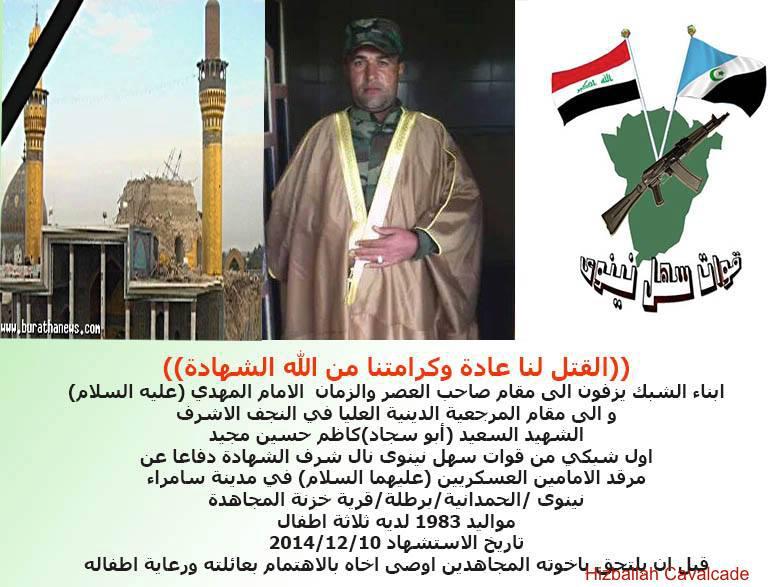
Figure 7: The martyrdom poster for Kazem Husayn al-Asharaf (Abu Sajad).
Videos
Notes:
_____________
Hizballah Cavalcade: The Shia Militant Response to Ayatollah Nimr al-Nimr’s Death Sentence
NOTE: For prior parts in the Hizballah Cavalcade series you can view an archive of it all here.
—
The Shia Militant Response to Ayatollah Nimr al-Nimr’s Death Sentence
By Phillip Smyth
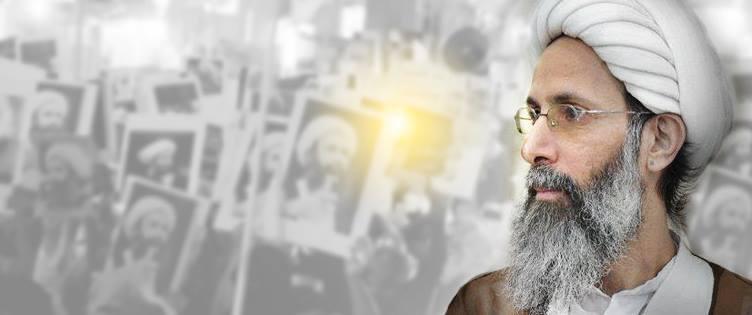
Ayatollah Sheikh Nimr Baqr al-Nimr, an outspoken radical Saudi Arabian Shia cleric, has been the center of controversy and brewing conflict between Shia protesters, militant Shia groups of Saudi Arabia and Bahrain, and their respective Sunni governments. According to a 2012 article by Toby Matthiesen, al-Nimr was, “long a peripheral figure in the local Shia power struggle but now seems to have become the most popular Saudi Shia cleric among local youth.”1 His cause and image is spreading across the Middle East as the latest example of Sunni oppression of Shia in the region and his recent death sentence has become a potent rallying cry for regional Shia militant organizations, particularly those with links to Iran.
Arrested in 2012, Nimr was accused by the Saudi government’s Special Criminal Court of making sectarian statements to cause strife, inviting foreign intervention (shorthand for Iranian influence), and disobeying the king. Following his 2012 arrest, thousands took to the streets and Saudi police shot and killed two protesters.2 In mid-October 2014, Nimr was sentenced to be “crucified”, a process where the sheikh will be beheaded and his body displayed.3
Protests in Saudi began in early 2011 and in part addressed anti-Shia discrimination suffered by the group in the Shia majority area in Saudi Arabia’s oil-rich Eastern Province; primarily zones around the Shia-majority towns and villages near the city of Qatif.4 Following the 2011 Saudi intervention in Bahrain, protests against the Saudi government increased in Bahrain and Saudi Arabia among Shia protesters.5 Following the 2011-2012 protests, links between Bahrain’s and Saudi Arabia’s protest movement spilled over into the more militant circles which actively promoted Nimr’s defiant stance and a hope to combine their fronts against common foes.
Of further interest are Nimr’s own ideological leanings and how they may relate to Shia militant responses. In Frederic Wehrey’s Sectarian Politics in the Gulf, the sheikh is described as a follower of the late Ayatollah Muhammad al-Shirazi.6 Shirazi was one of the founders of a radical Shia political school of thought referred to as the “Shiraziyya.” Shiraziyya clerics have been some of the most influential in the Arab Shia world. Initially al-Shirazi agreed with the Islamic revolutionary ideology of Ayatollah Khomeini, only to split from Khomeini over issues regarding how the new Islamic state (in Iran post 1979 revolution) should be led.7 In one BBC Arabic report, Nimr had been accused by Riyadh of attempting to spread Wilayat al-Faqih.8 Absolute Wilayat al-Faqih is the Khomeinist concept that serves as the basis for the Islamic Republic of Iran. Nevertheless, it was not clarified whether this was the type of Wilayat al-Faqih Nimr was accused of propagating.
Despite the history of strife between Shirazi’s school of thought and that of Ayatollahs Khomeini and Khamenei, al-Nimr appeared to increase public support for Tehran and send other more mixed messages. In 2008, he had also reportedly stated he supported Iran’s nuclear program by saying any attack against it should be met by a response from the Islamic world. That same year, he also said that Saudi Shia may need to call on foreign support (implying Iran) to help press their issues in Saudi Arabia.9 Later in 2009, Nimr reportedly called for secession, stating during a sermon, “Our dignity is more precious than the unity of this land.”10 His statement came as a response to discrimination against Shia in the kingdom and reflected possible repercussions if certain demands made by Shia protesters were not addressed.
Since 2013, in a piecemeal fashion, social media accounts associated with Iranian proxy groups in Iraq have promoted the images and other supportive statements for Ayatollah Nimr al-Nimr.11 While this does not necessitate that Nimr is a true ally or proxy of Tehran, his message and influence is likely seen by Iran as a cause to be promoted in that country’s wider struggle for the leadership of Shia Islam and as a counter to Saudi Arabia.
Nimr’s deep links and strong voice within the Saudi Shia community, particularly among youthful radicals and other more non-violent protestors, has led to Shia militant groups championing his cause from Bahrain and Iraq. Even in Yemen, Shia supporters of Ansar Allah, more commonly known as the Houthis, even launched demonstrations for the jailed cleric.12 Some Bahraini militant groups, which view the struggle of their coreligionists in a geographically close region of Saudi Arabia, as part and parcel to their conflict with the Khalifa monarchy and their Saudi government supporters. Additionally, powerful Iranian proxy groups based in Iraq—which have also maintained anti-Saudi and anti-Bahraini government narratives—have taken to issuing stern threats against Riyadh for his sentence.
The Violent Replies From Saudi Arabia’s and Bahrain’s Militants
Bahraini militant groups demonstrated the most concerted effort in terms of orchestrating violent retorts to Nimr’s jailing and sentence. While other threats and attacks were conducted since the start of 2014, this piece will focus on more recent threats and attacks beginning in the summer of 2014.
Bahrain’s Saraya al-Mukhtar (SaM), a group which once said the Saudi Shia of the Qatif and the Shia of Bahrain constituted one people with common foes, launched the most attacks over the longest period specifically addressing Ayatollah Nimr al-Nimr’s arrest, trial, and death sentence.
Starting in August, SaM attacked an electricity tower in Ar-Rifā near a Bahraini military base. The group filmed the attack and stated it had been a warning related to the imprisonment and trial of Ayatollah Nimr al-Nimr. Around the same time, SaM also began an online countdown for the Nimr verdict and increased their threats against Saudi Arabia. The group also ratcheted up it’s pro-Nimr messaging with the release of numerous images.
This messaging coincided with Saraya al-Mukhtar making its first direct threat against U.S. military personnel in Bahrain on August 11. Through an image posted to Facebook, SaM stated that, “The American cover on al-Saud and Al_Khalifa crimes,,Marines in bahrain will pay the price. [sic]” The message essentially claimed that the U.S. was the real backer for the Khalifa and Saud monarchies. As a result, they bore equal responsibility and could be targeted.
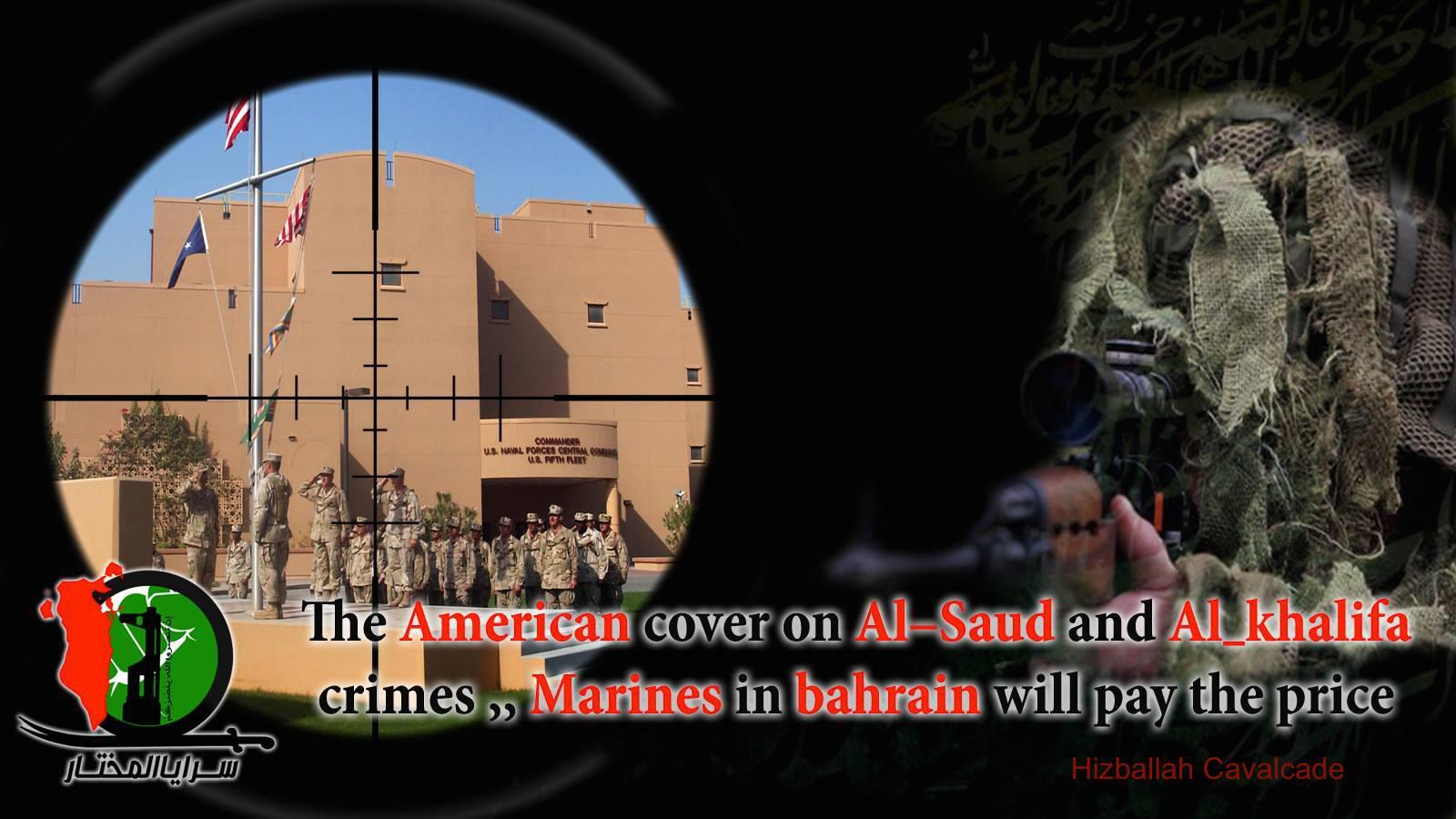
Figure 1: Saraya al-Mukhtar’s anti-American message posted on August 11, 2014.
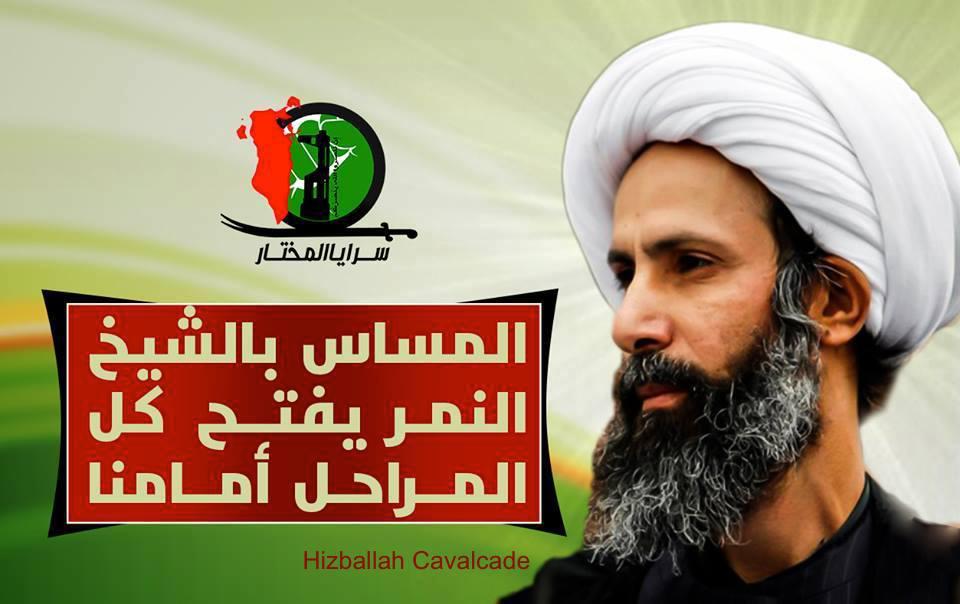
Figure 2: A Saraya al-Mukhtar photo for Ayatollah Nimr al-Nimr posted on August 8, 2014. The poster reads: “Sheikh Nimr[‘s trial and poor treatment] will make us put all options on the table.”
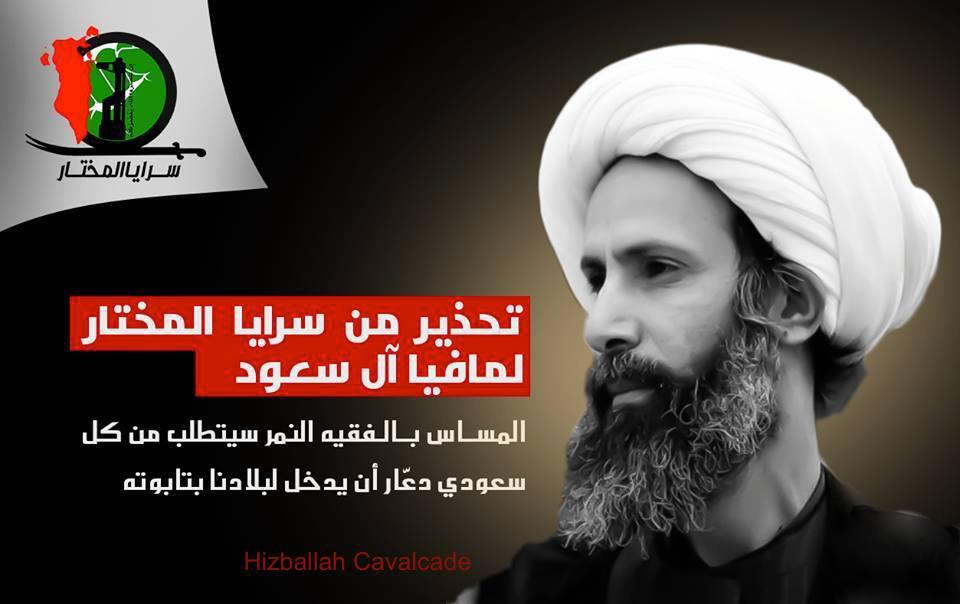
Figure 3: A Saraya al-Mukhtar photo posted on August 10, 2014. This poster reads: [in the red box] “A warning from Saraya al-Mukhtar to the mafia of the Sauds [in white text] Harming Sheikh Nimr will make us put all options [on the table]. Harming the Faqih Nimr means every single Saudi national will enter our country in a coffin.”
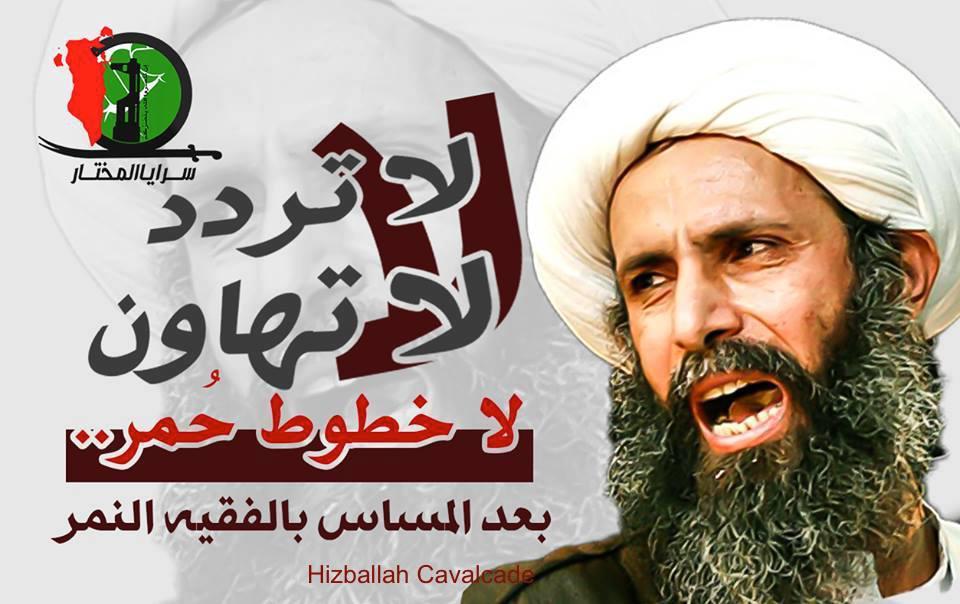
Figure 4: A Saraya al-Mukhtar photo for Ayatollah Nimr al-Nimr posted on August 11, 2014. The poster reads: “Do not hesitate, Do not underestimate, No red lines.. after [the] discrimination [against] the Faqih al-Nimr.”
On September 16, SaM announced it had planted 6 explosive devices in retaliation for al-Nimr’s incarceration. Albeit, these bombs did not target U.S. interests and there was little confirmation as to whether any devices were actually planted.

Figure 5: Saraya al-Mukhtar’s September 16 claim to have planted 6 bombs.
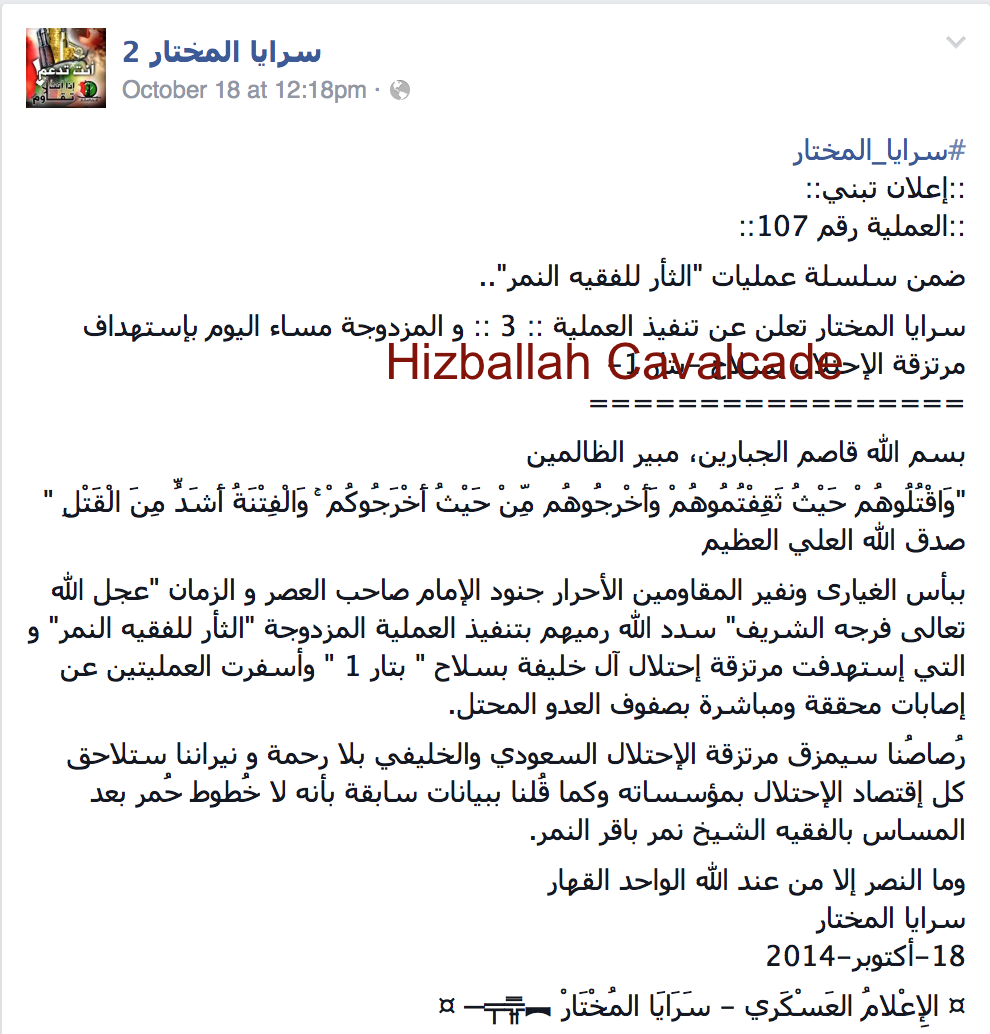
Figure 6: Saraya al-Mukhtar’s claim of 2 attacks on October 18, 2014.
Then on October 9, SaM claimed to conduct an attack in the town of Karana, Bahrain utilizing an improvised firearm. SaM’s claim of responsibility stated they attacked, “herds of mercenaries” (shorthand for Bahraini police and other security entities). On October 15, SaM claimed to have launched attacks in Sanabis and Aker, Bahrain targeting “mercenaries”. In another statement from that day, the group threatened, “The occupying mafia of al-Saud and al-Khalifa [would face]…consequences for the death sentence.” Later, on October 18, SaM claimed two attacks, referring to them as “Revenge of the Faqih [an expert in Islamic jurisprudence] Nimr.” SaM’s statement declared that it had injured “ranks of the enemy occupier.”

Figure 7: SMS’s claim of attack in honor of Sheikh Nimr.
Bahraini militant group, Saraya
Hizballah Cavalcade: Selling Sectarianism: Shia Islamist Groups & Maliki’s Anbar Offensive
NOTE: For prior parts in the Hizballah Cavalcade series you can view an archive of it all here.
–
Selling Sectarianism: Shia Islamist Groups & Maliki’s Anbar Offensive
By Phillip Smyth
As the Iraqi government offensive in Anbar continues to engage Sunni groups which are protesting the government (some have now taken up arms against the government) and the Islamic State of Iraq and al-Sham (ISIS), sectarian messaging by Shia Islamist groups which support the government and its offensive has also increased.
Coming after the operation against jihadi militants on December 23, 2013 and following protests by Sunni groups (including a number of tribes), on December 25 Iraqi Prime Minister Nouri al-Maliki announced an offensive against ISIS and “armed groups” in Iraq’s Anbar province. The offensive has been controversial regionally and within Iraq, with some accusing Maliki of engaging in sectarian politics.[1] Analyst Charles Lister even called the coordinated offensive, “one move too far”.[2]
Sectarian language explaining the Iraqi government onslaught has been utilized by all sides. Even Nouri al-Maliki called the operations, “a fierce confrontation between the supporters of Hussain and the supporters of Yazid”.[3] Shia Islamist groups, including Iranian-backed and possibly those claiming to back Iraqi Shia cleric and political leader Muqtada al-Sadr, have taken the opportunity to issue statements, upload photos, and produce music in support for the Iraqi government’s operations.[4] For these groups, the offensive was viewed as a golden opportunity to demonstrate their importance to the Iraqi Shia community and to demonstrate they were assisting the fight against jihadi-type organizations. These groups also played upon sectarian sentiments to promote the Iraqi government’s operations and suggest that the Iraqi Army is a pro-Shia sectarian entity. There were also claims that some Iraqi Shia Islamist forces which had fought in Syria, returned to fight ISIS and other Sunni groups in Iraq.
Statements of Support
On December 28, Ahmed al-Alwani, a Sunni parliamentarian and protest leader, was arrested by Iraqi security forces. The raid against him resulted in the death of Alwani’s brother and a number of guards from his security profile.[5] Alwani was well-known for vitriolic anti-Shi’ite statements.[6] His arrest by Iraqi security forces was immediately praised by some Shia Islamist groups, particularly Asa’ib Ahl al-Haq, which praised the raid (see photos below). The day also saw a near simultaneous release of statements by Iranian-backed Shia Islamist organizations which are also fielding armed units in Syria.
Liwa’a Zulfiqar, a Syria-based Shia Islamist armed group, also announced its support for the Iraqi Army in its operations against ISIS and announced they would stand by them against, “racist Zionist terrorism”. This represents a continuance of the narrative that armed Shia Islamist groups (primarily backed by Iran) consider al-Qa’ida and its allied organizations as merely agents of Israel. On the same day, Kata’ib Sayyid al-Shuhada, released its second publicly available official communique. The statement stressed their support for the Iraqi Army’s fight in Anbar. Asa’ib Ahl al-Haq also issued their own messages of support for the offensive against ISIS.

Figure 1: An announcement of support for the Iraqi Army’s efforts in Anbar from the official Liwa’a al-Zulfiqar Facebook page.
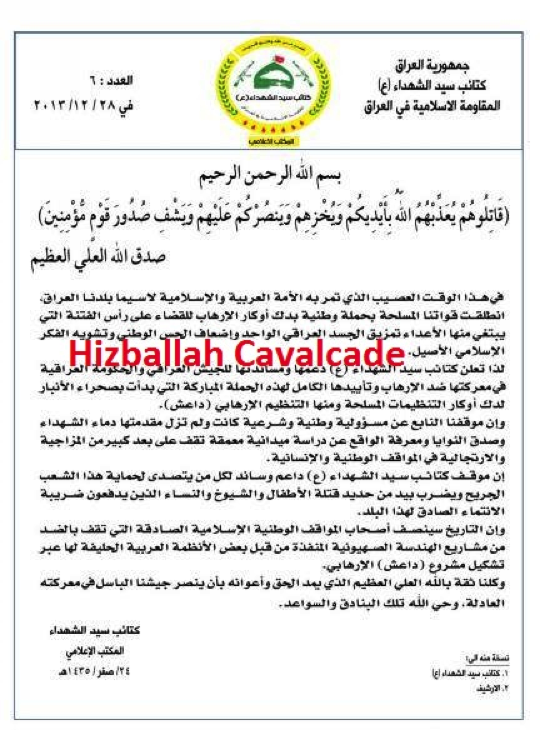
Figure 2: Kata’ib Sayyid al-Shuhada’s release in support of the Iraqi government’s offensive into Anbar.
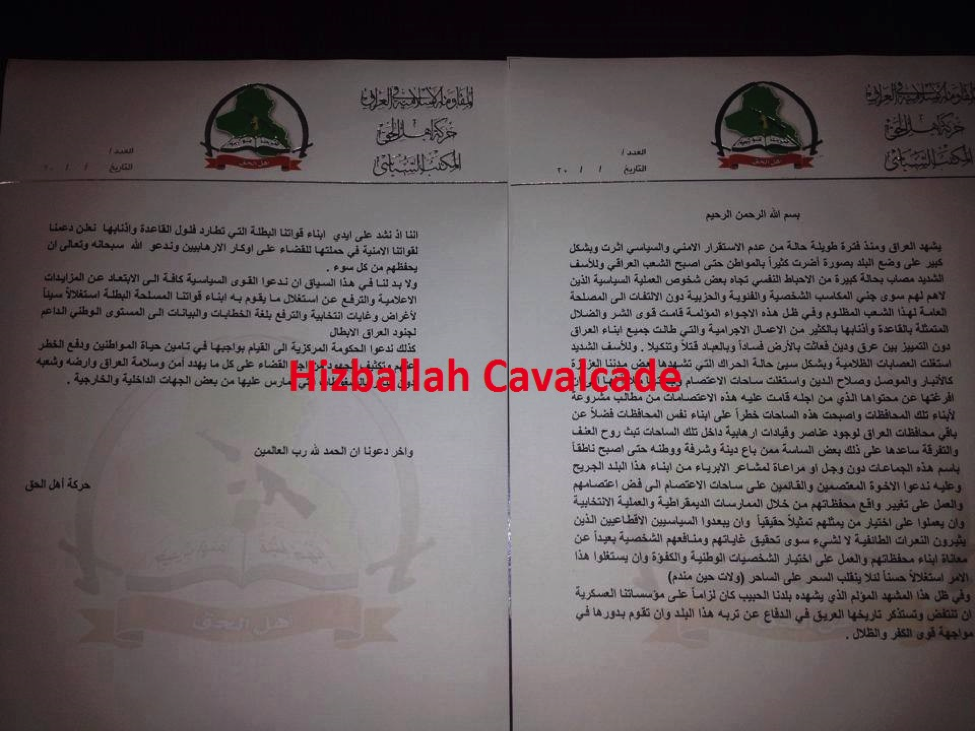
Figure 3: Asa’ib Ahl al-Haq’s statement about their support for the Iraqi government and military against ISIS and armed groups in the country.
Main Messaging Themes:
- National Institutions: Shia Islamist groups have claimed to fully support the Iraqi Army and present themselves as integral elements to the Iraqi military and police operations in Anbar. This theme coincides with other Iranian-backed organizations messaging, namely the narrative presented by Lebanese Hizballah and their claims of fully backing the Lebanese Armed Forces.[7]
- One Army, One Sect: Photos and statements implying the Iraqi military and police are engaging in the fight against ISIS to defend Shi’ism. These themes are also combined with photos claiming to show members of the military and/or police showing support for certain Shia political leaders and clerics. This sort of rhetoric had gone on since the spring of 2013 during the initial announcements of foreign Shia fighter involvement in Syria. In one May 2013 photo, a soldier reportedly from the Iraqi Army is shown holding a Shia religious banner on top of what is claimed to be an Iraqi military armored vehicle (see below).
- Two Fronts, One War: Tying the war in Syria to the fighting in Iraq involves extending the “Defense of the Sayyida Zaynab” (the defense of the Sayyida Zaynab shrine in southern Damascus is held as the reason for Shia Islamist fighters are in Syria) narrative which claims Shia Islamist armed groups are present in Syria to protect holy shrines/Shi’ism and stop jihadi-linked fighters. As a result, the engagements within Iraq which claim to also target ISIS and other organizations are grouped together as part of a unified effort to protect Shi’ism.
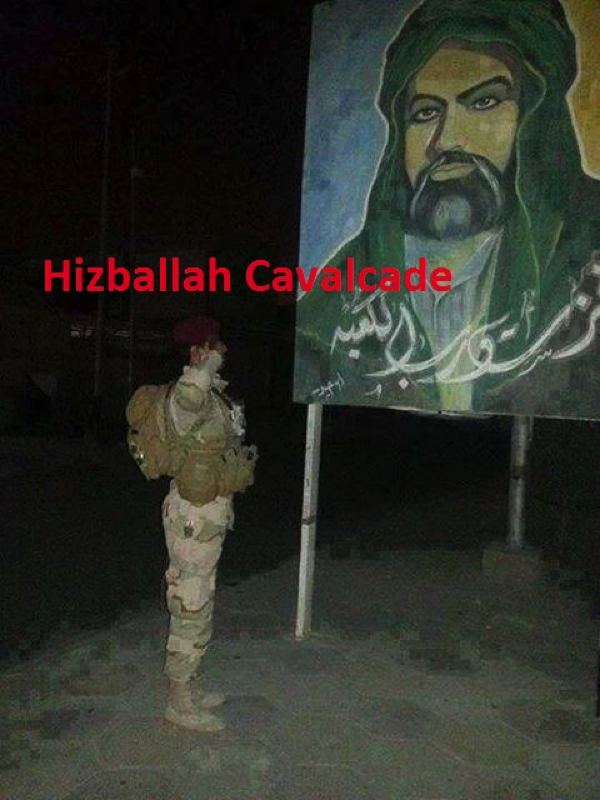
Figure 4: A photo uploaded in mid-January with the caption, “We will not be defeated”. The photo reportedly shows an Iraqi Army soldier saluting a Shia religious poster.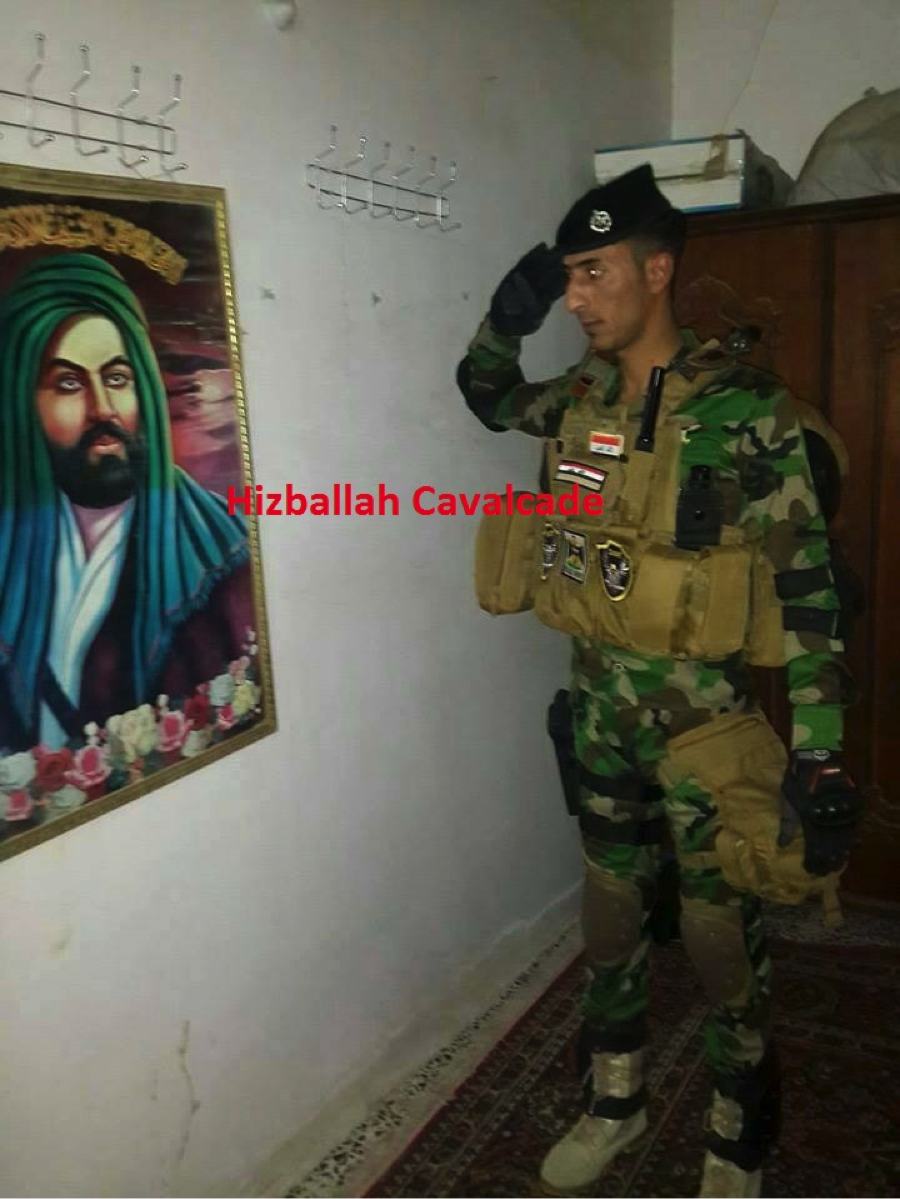
Figure 5: Photo claims to show an Iraqi soldier saluting a picture of martyred Shia leader, Imam Husayn. The photo was posted onto numerous social media pages catering to Shia Islamist fighters in Syria.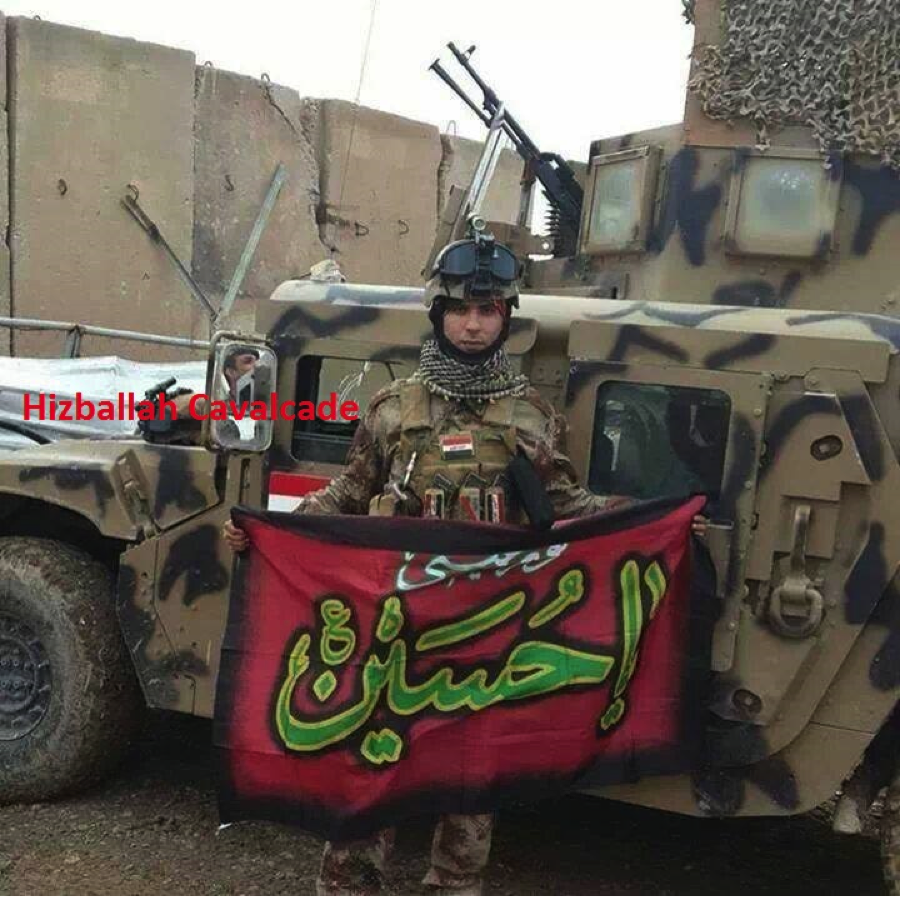
Figure 6: This photo claims to show an Iraqi soldier holding an Imam Husayn flag in front of an armored vehicle. The photo was widely circulated on Shia Islamist social media pages.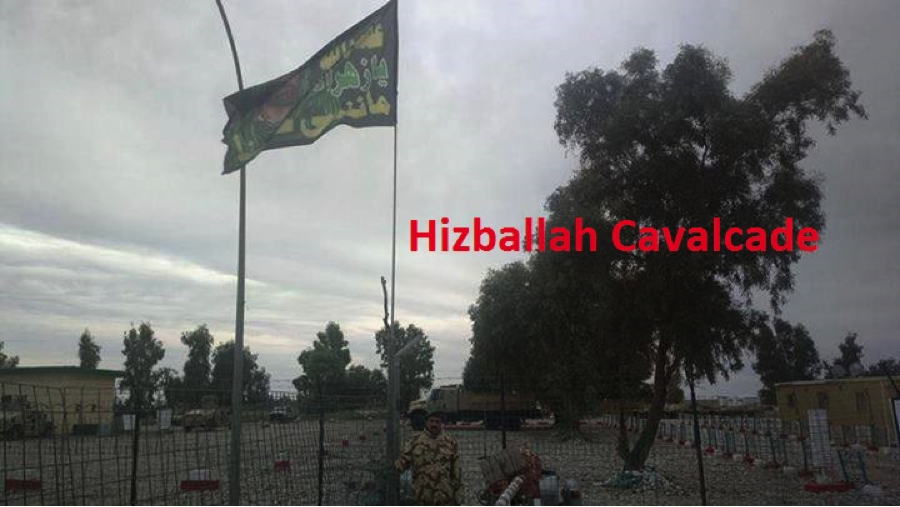
Figure 7: Photo purports to show an Iraqi soldier under a Shia banner following the, “Capture of Ramadi”. The photo was posted on Badr Organization and Asa’ib Ahl al-Haq social media pages.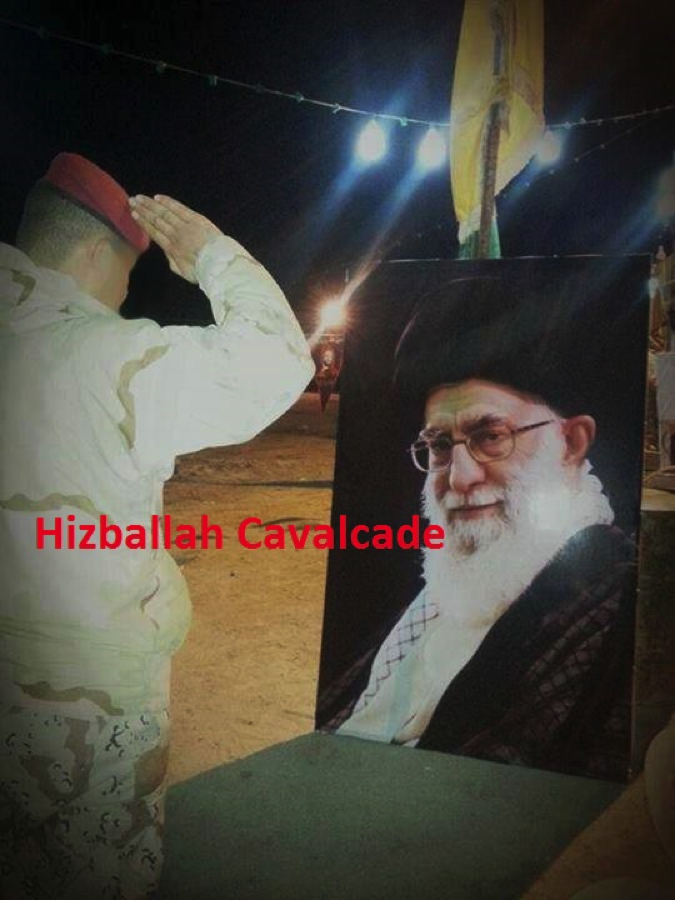
Figure 8: This photo claimed to show an Iraqi soldier saluting Iranian Supreme Leader Ayatollah Khamenei.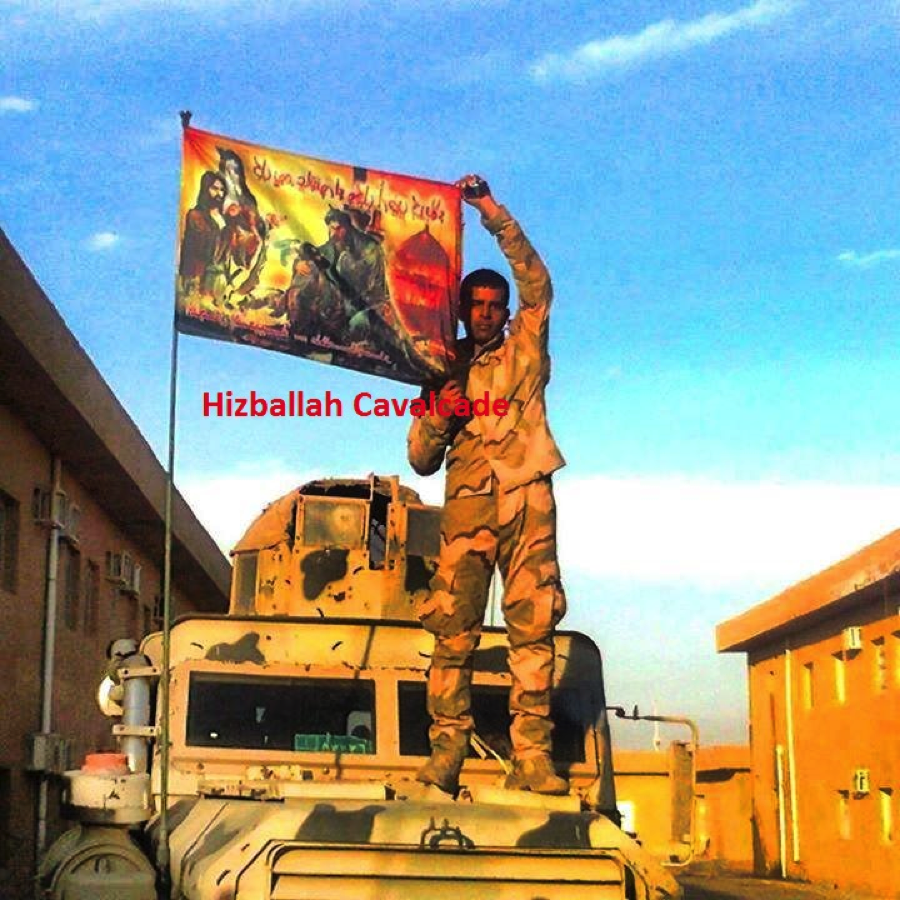
Figure 9: First uploaded to Shi’a Islamist social media in May 2013, this photo claims to show an Iraqi soldier atop an armored vehicle holding a Shi’a religious banner.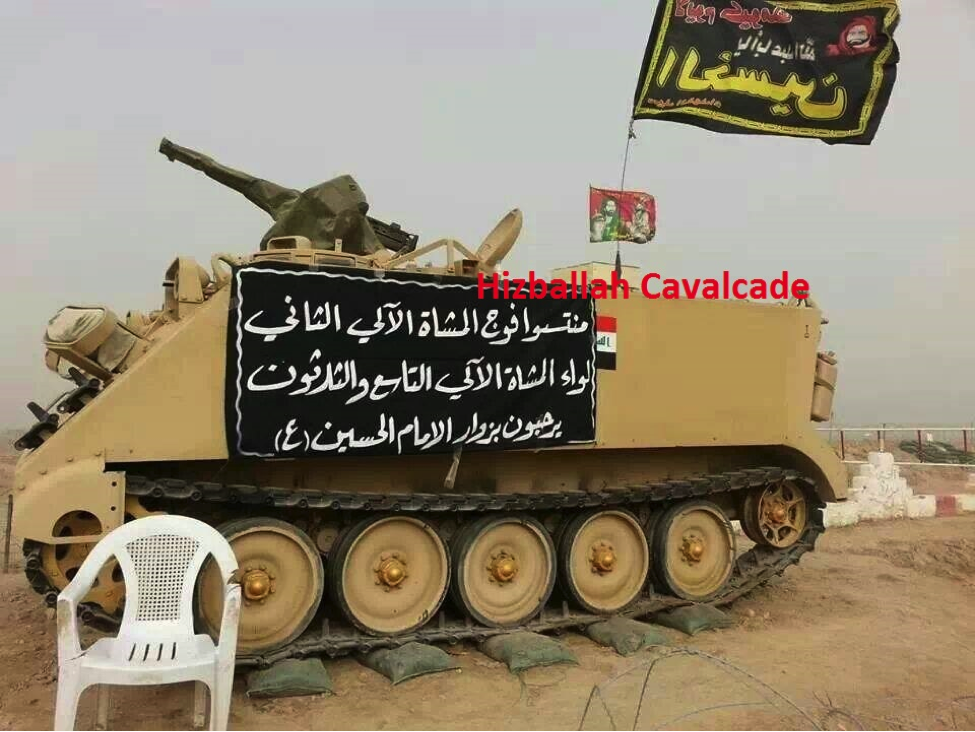
Figure 10: An Iraqi armored personnel carrier (APC) flying flags for Shia Imam Husayn with a sign partially reading, “Welcoming visitors to Imam Husayn [mosque and shrine in Karbala, Iraq]”. While the context of the photo is probably more innocuous—It is likely this APC was simply part of a guard set up in Karbala and was used to welcome pilgrims—ISIS/Sunni Islamist activists and Shia Islamist groups circulated the photograph as proof of the Iraqi Army’s sectarian loyalties.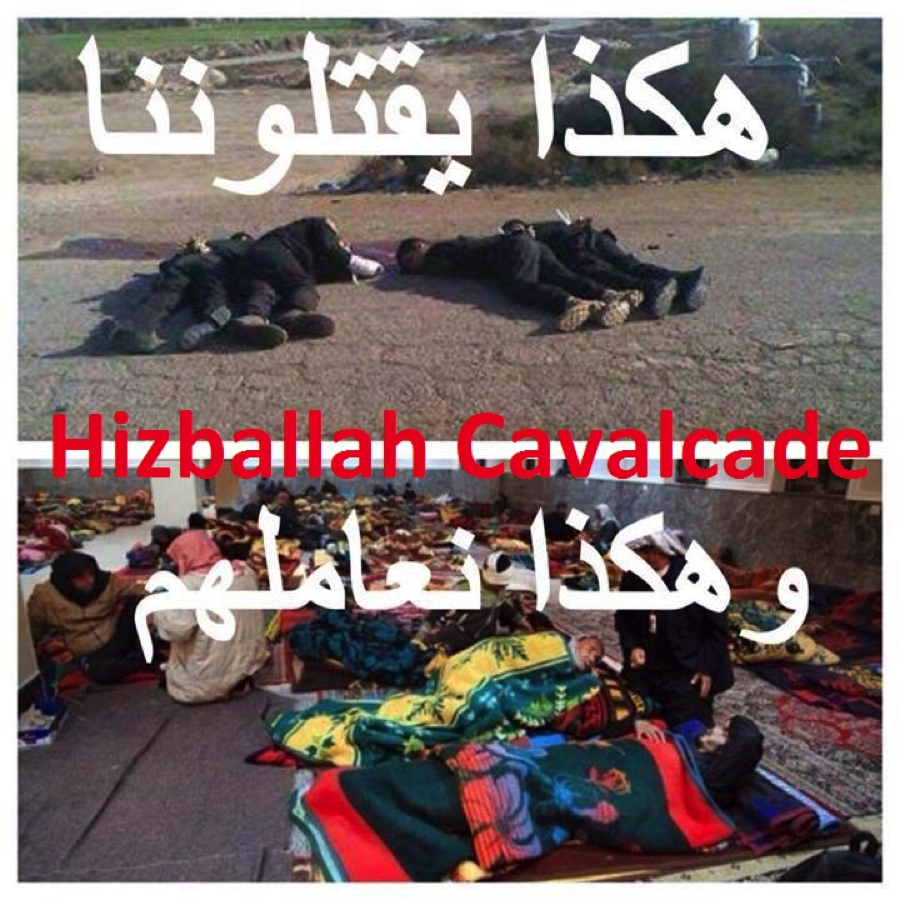
Figure 11: Top photo: “This is how they kill us”. Bottom photo: “And this is how we treat them”. The top picture shows Iraqi soldiers executed by ISIS. The bottom references reports of Shia Muslims taking in Sunni Muslim refugees from Anbar.[8] The photo was not widely distributed, but could be found on pages and profiles catering to Iranian-backed Shia Islamist organizations (mainly Asa’ib Ahl al-Haq).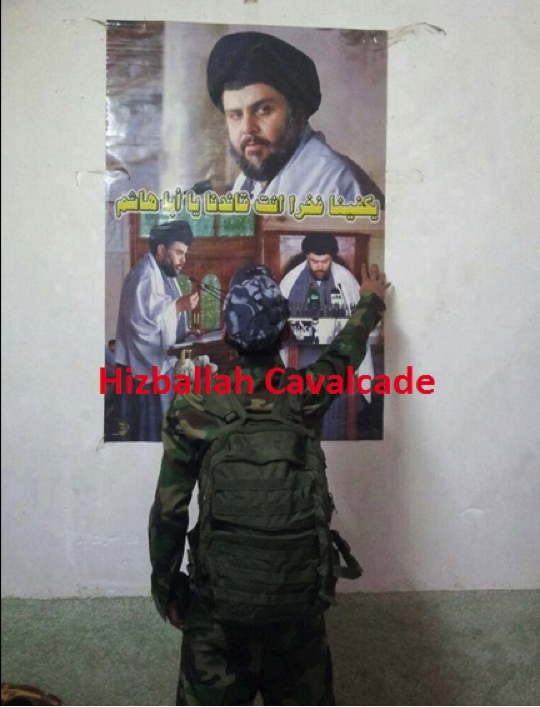
Figure 12: This photo, spread on Sadrist and Sadr-splinter group social media, claims to show an Iraqi soldier reaching out to a Muqtada al-Sadr poster.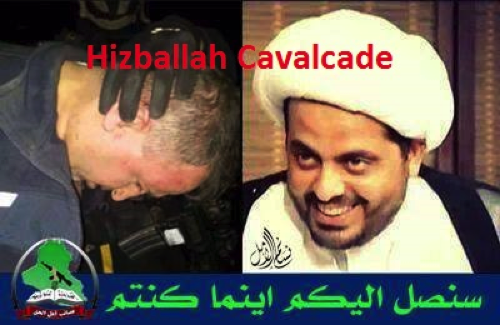
Figure 13: Asa’ib Ahl al-Haq leader Qais al-Khazali smiles (right) while Iraqi Sunni MP Ahmed al-Alwani is detained by Iraqi security forces (left).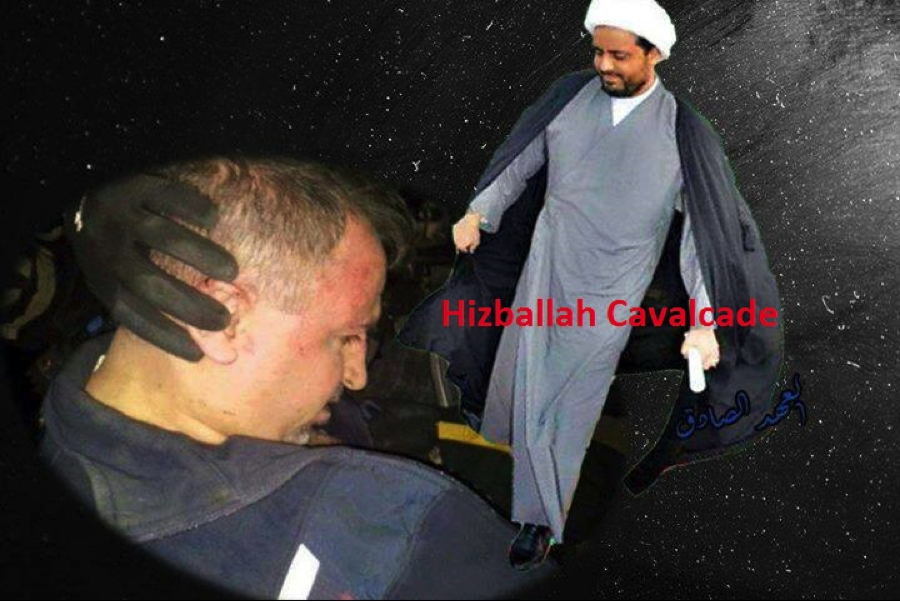
Figure 14: Qais al-Khazali is portrayed as walking on the captured Iraqi Sunni MP Alwani.
Figure 15: “Thus, we support you”. An AAH poster shows AAH leaer Qais al-Khazali looking down on Iraqi army soldiers and an Iraqi helicopter.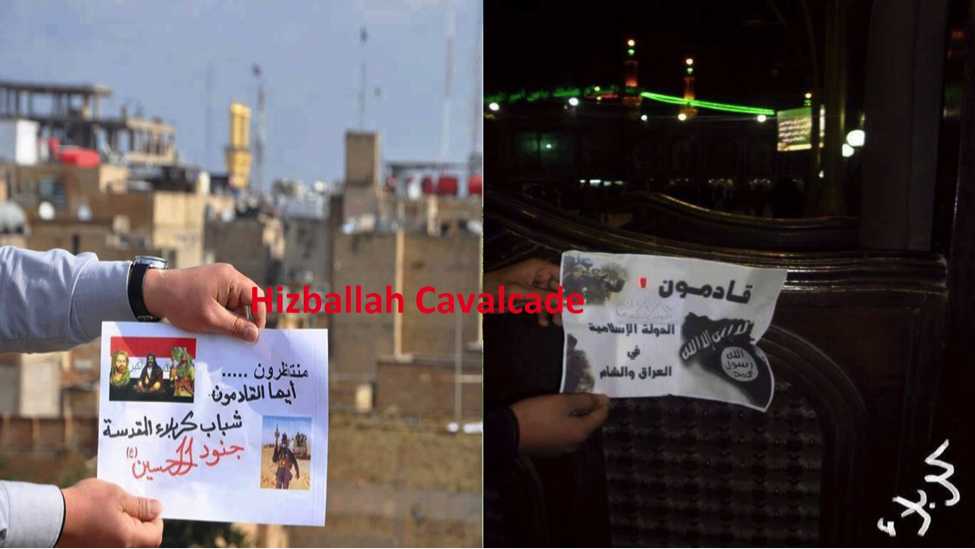
Figure 16: Selfie Taunts: On the right an ISIS supporter holds up a picture near the Imam Husayn Mosque/Shrine complex in Karbala. The sign reads, “Qadimoun” (“We are coming”). As a response to the pro-ISIS message, (on the left) “We are waiting for those coming, [we] the young men of sacred Karbala Soldiers of Husayn”.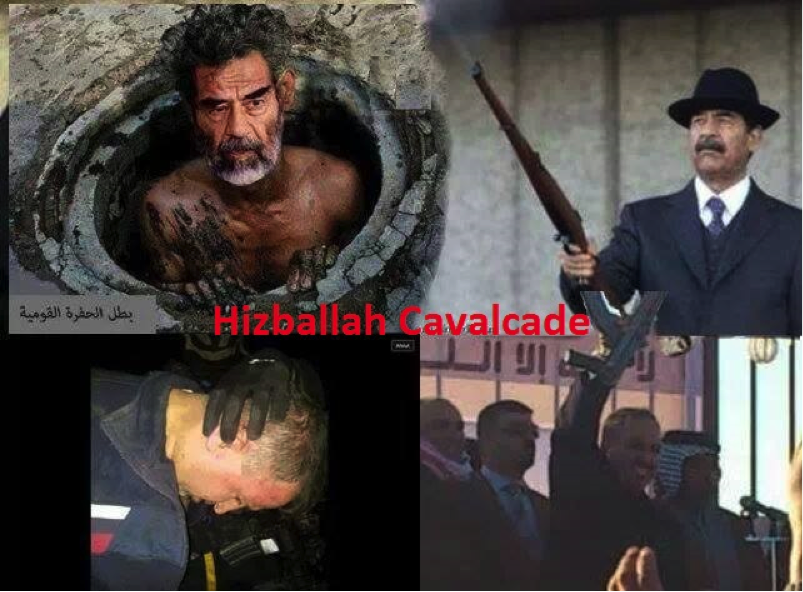
Figure 17: Right Left (top) An edited photo shows deposed Iraqi leader Saddam Husayn emerging from a dirty sewer. Left (bottom) Alwani is shown following his capture. The photo was spread on Sadrist and Iranian-backed Shia Islamist pages. The image promotes a theme of “how the mighty have fallen.” 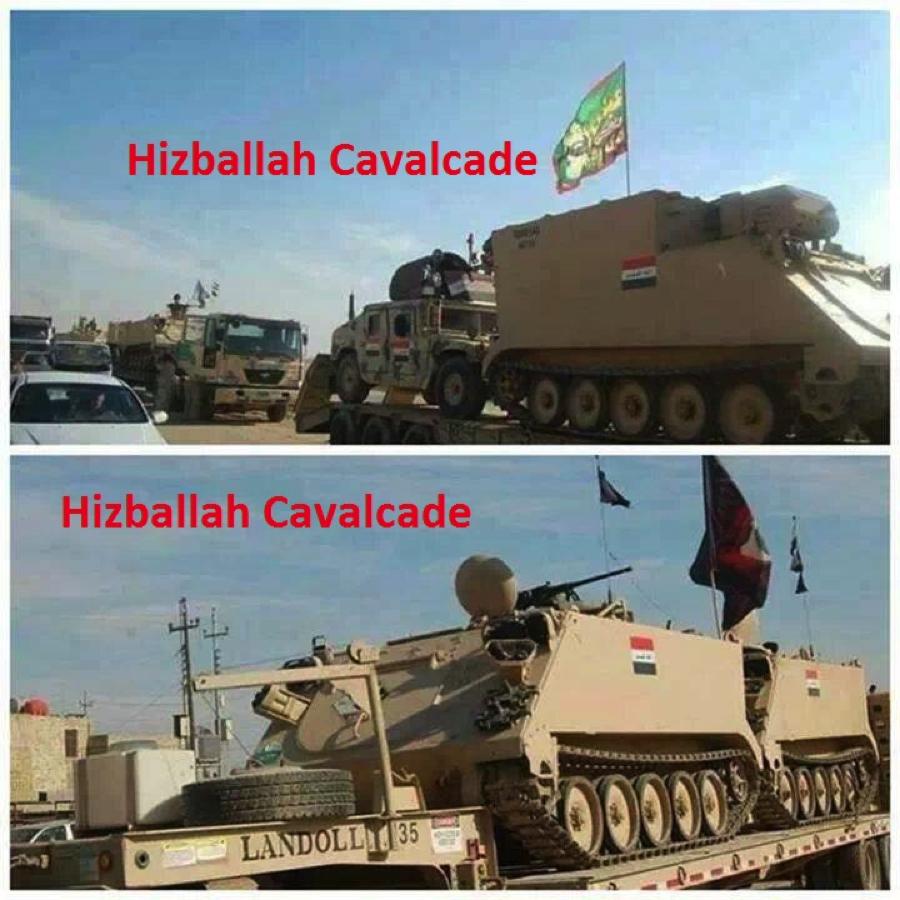
Figure 18: Another photo released on social media claiming to show Iraqi APCs flying Shia religious flags. The photos were shared online by ISIS sympathizers and Shia Islamist groups. The latter used the photos as a subtle way to suggest the Iraqi Army had Shia Islamic sectarian loyalties.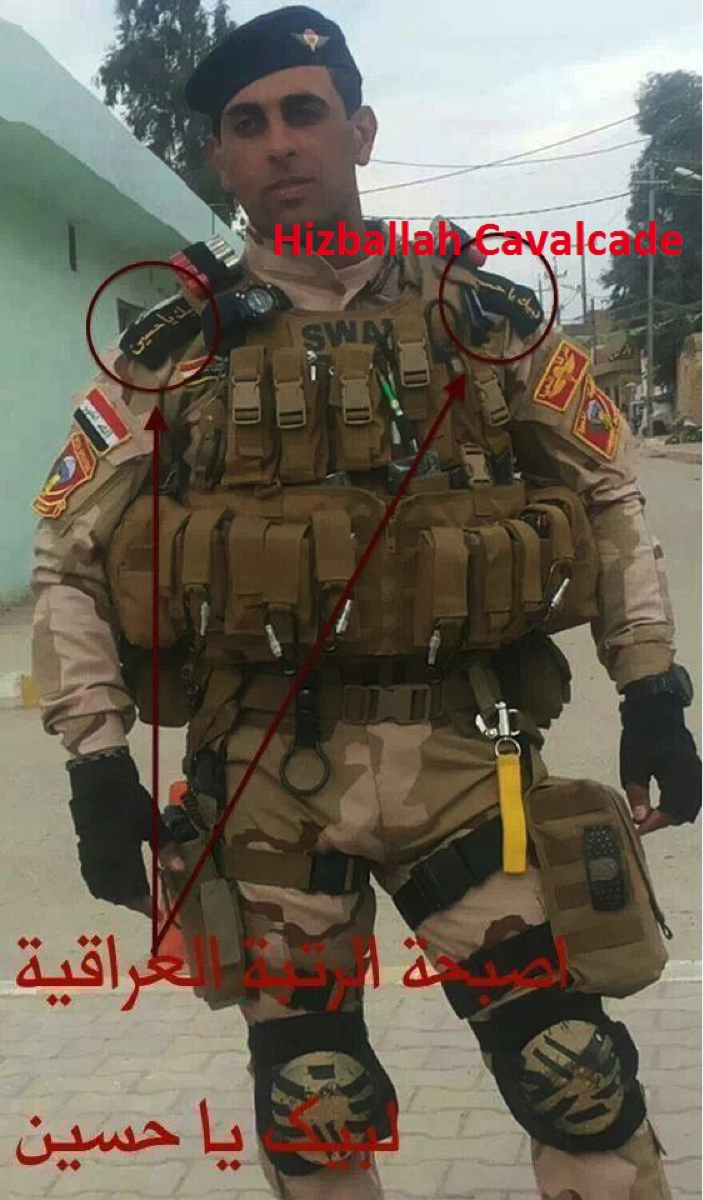
Figure 19: Shia Islamist and Sunni supporters of the protests and of ISIS circulated this photo on social media (including Twitter and Facebook). The photo purports to show an Iraqi Special Forces/SWAT member wearing epaulettes reading, “Labayk ya Husayn” (“At your service, O Husayn”), a Shia slogan used to show support for the Shi’ism’s first Imam.
One video uploaded claimed to show Iraqi units assembling before heading into Anbar and flying Shia religious flags. Due to the lower quality of the images in the video, the claim could not be confirmed. Accounts affiliated with Asa’ib Ahl al-Haq also uploaded a response to the offensive against ISIS. In their clip, a man sets up a system for a unmanned aerial vehicle (UAV) which then spots what can assumed to be ISIS positions. The ISIS positions are then destroyed. The clip was entitled, “A message from Asa’ib Ahl al-Haq to Da’sh” (note: Da’sh is the Arabic acronym for ISIS).
Hizballah Cavalcade: Khamenei’s Cannon: .50 Caliber Anti-Material Rifles & Shia Fighters in Syria
NOTE: For prior parts in the Hizballah Cavalcade series you can view an archive of it all here.
–
Khamenei’s Cannon: .50 Caliber Anti-Material Rifles & Shia Fighters in Syria
By Phillip Smyth
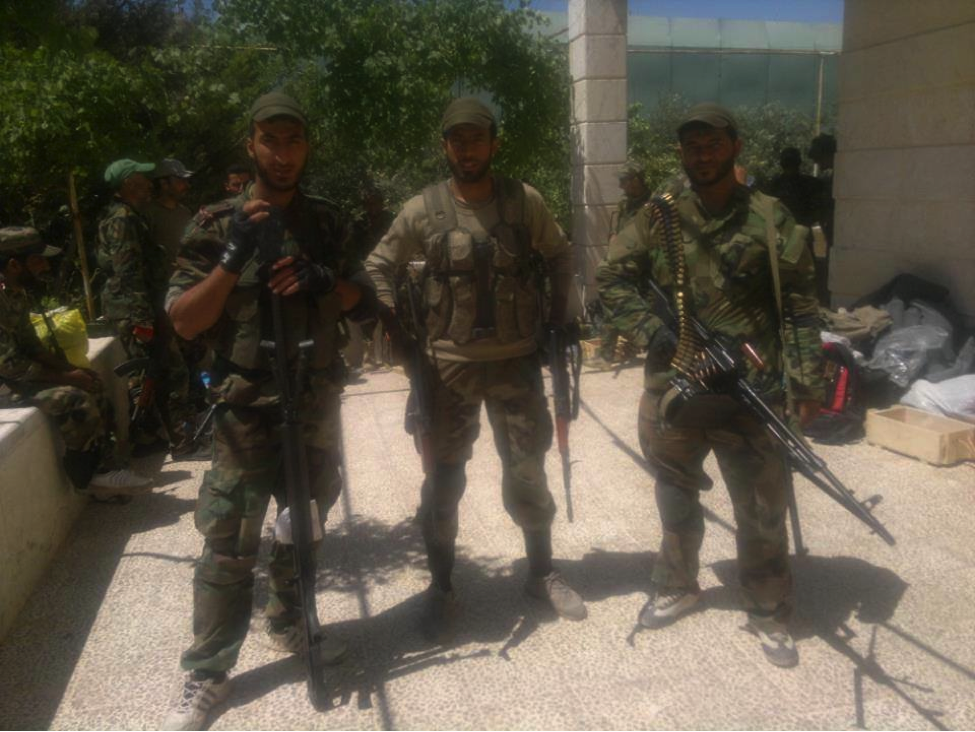
Figure 1: Combatants from Liwa’a ‘Ammar Ibn Yasir. The fighter on the left likely holds an Iranian-copy of the HS.50 rifle.
Since April 2013, around the same time Liwa’a Abu Fadl al-Abbas was first gaining broader exposure and name-recognition, another sub-trend started to appear in the photos showing Shia Islamist fighters in Syria. This trend remained minor and occasional. However, starting in October, there have been increasing examples of foreign Shia Islamist fighters being pictured with long range bolt-action anti-material rifles.[1]
It is possible these weapons were the bolt-action HS.50, .50 caliber (12.7x99mm) rifles produced by Austria’s Steyr Mannlicher. According to The Telegraph, 800 of the rifles were shipped to Iran in 2007.[2] However, according to the Brown Moses Blog, it is far more probable that these rifles are actually Iranian copies which were shipped to Syria.[3] Since the winter of 2012, pro-Iranian social media has also praised the Iranian-made copy of the rifle.[4] Still, serial numbers on the weapons are often hidden, making absolute confirmation difficult.
The original Steyr Mannlicher sale of these long-range weapons caused worries among British and U.S. policymakers and military personnel due to the fear they would be supplied to Iranian-created and supplied Shi’a Islamist “special groups” in Iraq. These groups included Asa’ib Ahl al-Haq and Kata’ib Hizballah. Both of these organizations are now sending forces to Syria.
Anti-material sniper rifles of this caliber have found a welcome place in Western military services. The U.S. military fields the M107 semi-automatic .50 caliber rifle as do a number of other militaries. In October, 2012 one of these weapons killed a Taliban member in Afghanistan from a distance of 2,475 meters.[5]
Presently in Syria, these types of rifles have been used by both rebels and pro-Assad forces. Nevertheless, the outfitting of highly organized foreign Shia fighter manned organizations may demonstrate a shift in tactics and training.
Groups using the rifle in Syria span the full spectrum of organizations backed by Iran. Lebanese Hizballah has been a primary poster of images with the weapon. Additionally, Iraq-based Harakat Hizballah al-Nujaba’s (a front for Kata’ib Hizballah and Asa’ib Ahl al-Haq) Syria-based front militias, Liwa’a ‘Ammar Ibn Yasir and Liwa’a al-Hamad have posted photos of their militants with the rifle. Iraq’s Badr Organization’s Quwet Shahid Muhammed Baqir Sadr and Kata’ib Sayyid al-Shuhada have posted their own images of their fighters with the HS.50 type rifle. Other Shia fighters from unnamed organizations have also been pictured with the weapon.
Films featuring Shia militia groups using the HS. 50 type rifles in combat in Syria have been extremely rare. Usually only photos are posted.
The first film showing Shia Islamist militias in Syria using the rifle was posted to Facebook and YouTube pages associated with the Badr Organization’s Quwet Shahid Baqir Sadr (BOQSBS), the group’s expeditionary unit in Syria. The BOQSBS has also been a main poster of high-quality images showing their combatants wielding these types of anti-material rifles. Around a minute of footage showing BOQSBS fighters using the weapon was inserted into a much longer film made to demonstrate the group’s activities in Syria (see below at minute markers 1:59-2:23).
Due to the high level of operational security employed by these groups, potential failures or successes of the rifle in combat are often not showcased. Operations using the rifle have also not been detailed on the many social media pages run by Iranian-backed Shia militia groups inside Syria. In fact, the rifle has rarely been named or described by Shia Islamist militia pages. Nevertheless, these rifles have become a regular feature in images featuring fallen fighters.
Such a capability, even if deliberately showcased for propaganda purposes, should be taken seriously by regional and global military forces. Iranian equipped and trained snipers, utilizing smaller caliber rifles, demonstrated a lethal efficiency during the Iraq War (2003). Their utilization of smaller caliber-wielding snipers (particularly using the SVD-type rifles) demonstrates a concentration on sniping tactics.
Some Possible Reasons Why the Rifles Are Appearing More
- Propaganda Purposes: Some of the photos of fighters holding the rifle appear to be posed images meant to showcase the size of the weapon (representing power) in comparison to the fighter. Additionally, since it is probably a copy, showing the rifle in operations overseas is a sign that Iranian-made weapons are of a high quality. Proxy organizations may also see the rifle as a symbol of advancement and as a sign they are comparable to first-world armies. The weapon may also be a sign to rebel groups that Shia militants have more advanced capabilities.
- General Incorporation into the Order of Battle: The rifle could have possibly become more prolific with increased foreign-manned Shia militia operations.
- Offensive Operations: Since the start of main offensives in October and increase in numbers of Shia fighters, it is possible the rifle has found more use and acceptance by fighters.
The Rifle & Its Shia Islamist Users
Lebanese Hizballah:
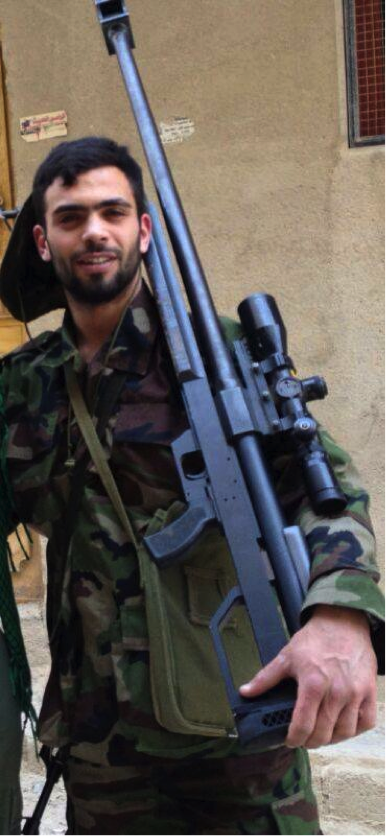
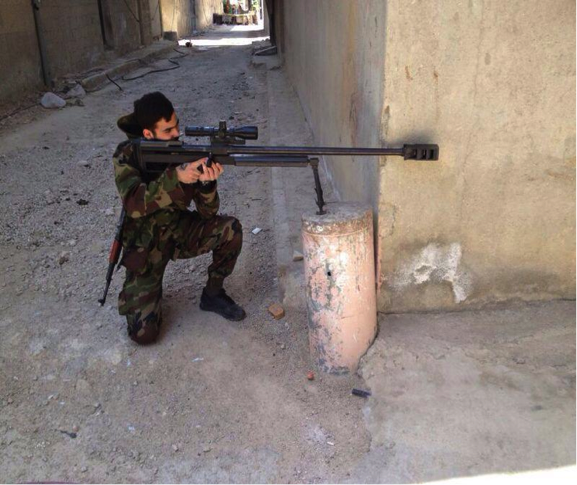
Figure 2: Lebanese Hizballah’s Ali al-Hadi Nuwn shown holding the weapon on his shoulder. (Left)
Figure 3: Another posed-photo of Lebanese Hizballah’s Ali al-Hadi Nuwn. In this picture he is taking aim with the .50 caliber rifle. (Right)
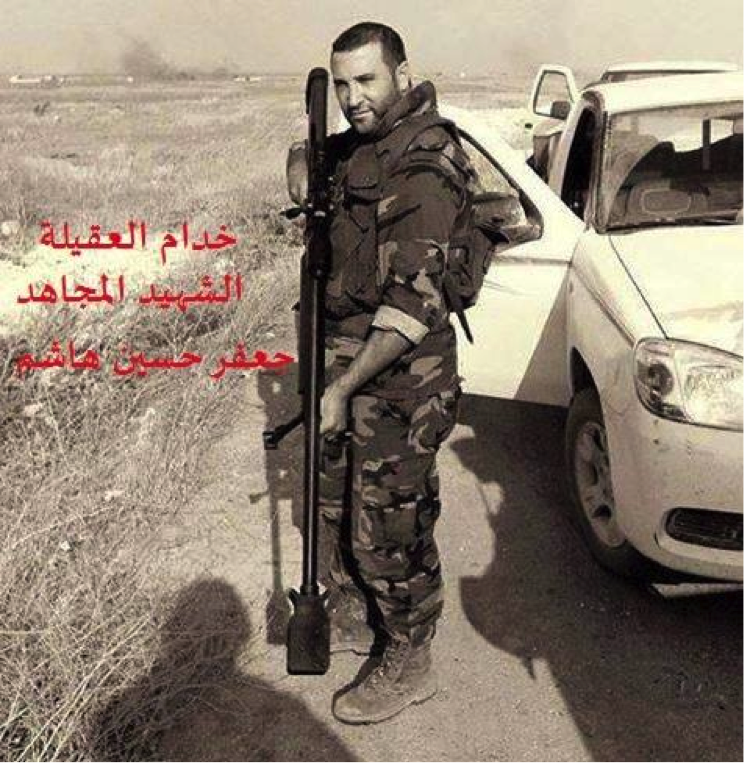
Figure 4: Hizballah commander Ja’afar Husayn Hashim with the rifle. He was reported to have been killed in Syria on November 1, 2013.
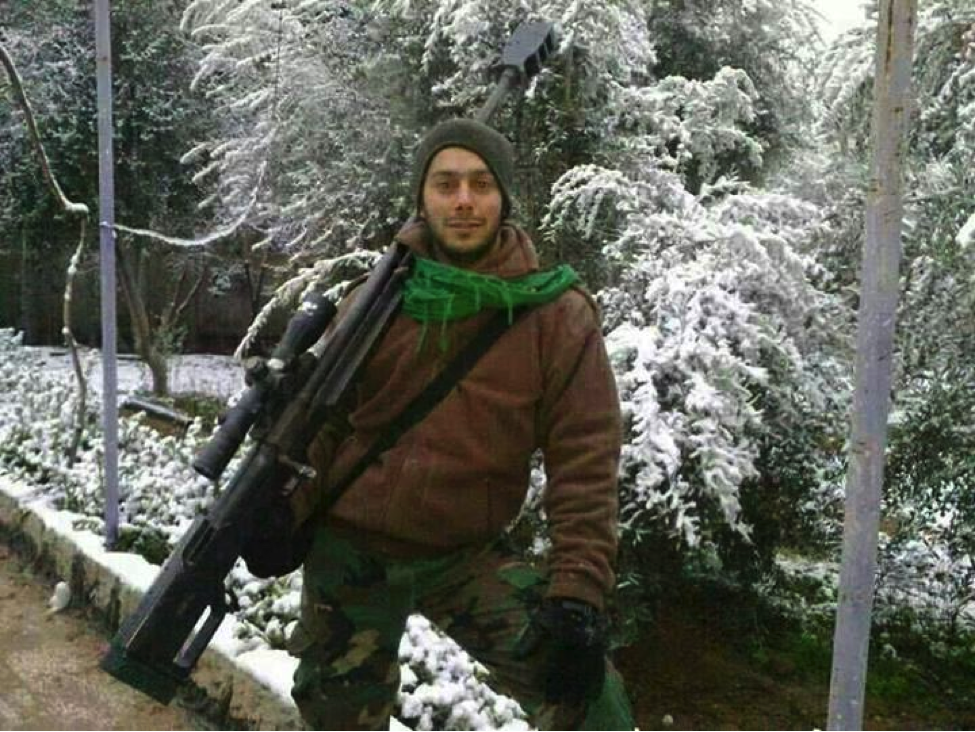
Figure 5: Hizballah’s Khadr Ahmed Matar, declared killed in Syria on December 2
0, is shown standing in the snow with the rifle.

Figure 6: Qasim Ghamloush is shown holding the .50 caliber rifle. His death was announced by Hizballah on December 7, 2013.
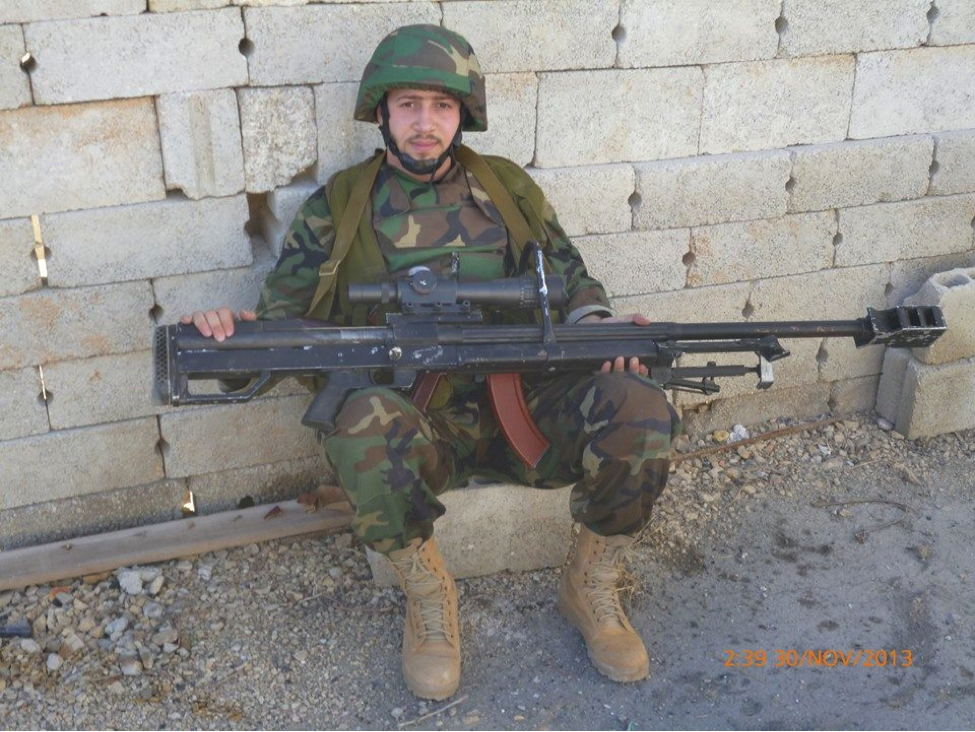
Figure 7: Ali Husayn Salah (A.K.A. Sheikh Hadi) is seen holding the rifle over his Kalashnikov-pattern weapon. Salah was also reported to have been killed in Syria on December 7, 2013.
Liwa’a al-Hamad:
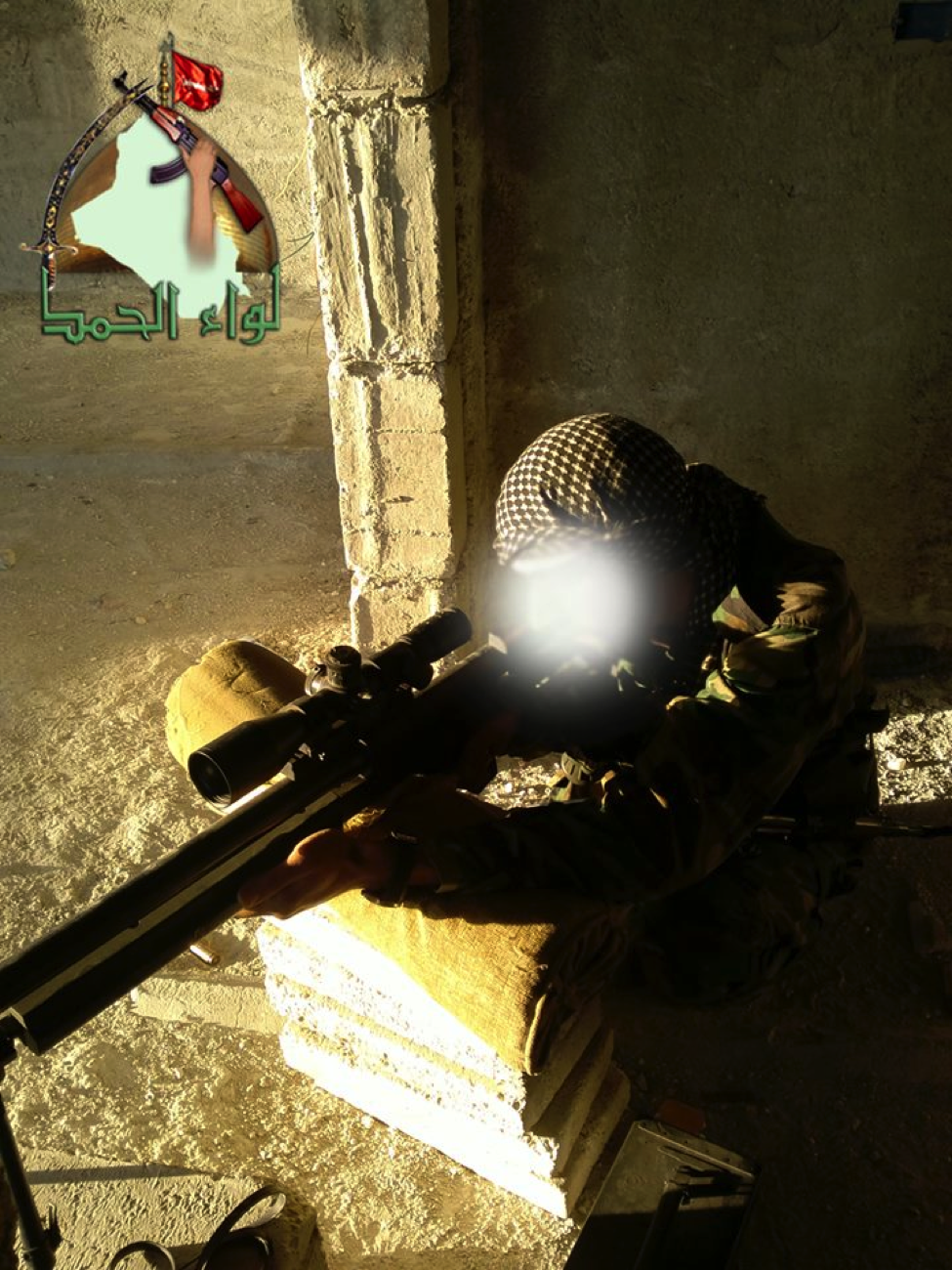
Figure 8: An October photo of a fighter from Liwa’a al-Hamad taking aim with the HS.50-type rifle.
The Badr Organization – Quwet al-Shahid Muhammed Baqir Sadr

Figure 9: Following the announcement that the Badr Organization had created its own expeditionary force for Syria, this was one of the first photos they posted online.
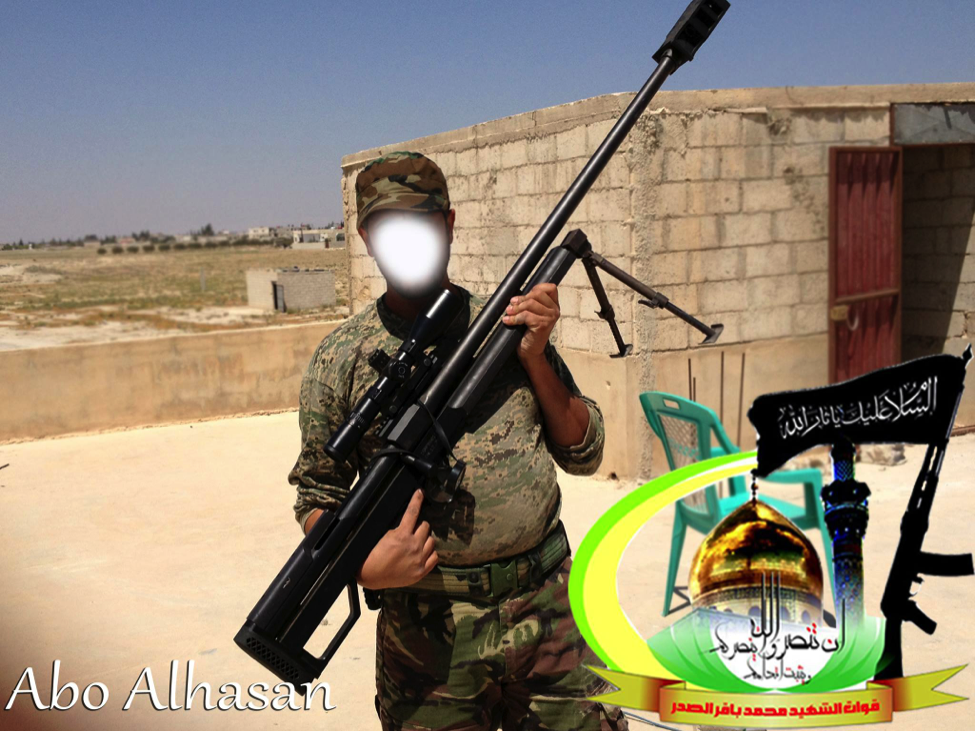
Figure 10: A Badr Organization-Quwet al-Shahid Muhammed Baqir al-Sadr is shown holding the HS. 50 type rifle.
Liwa’a ‘Ammar Ibn Yasir:
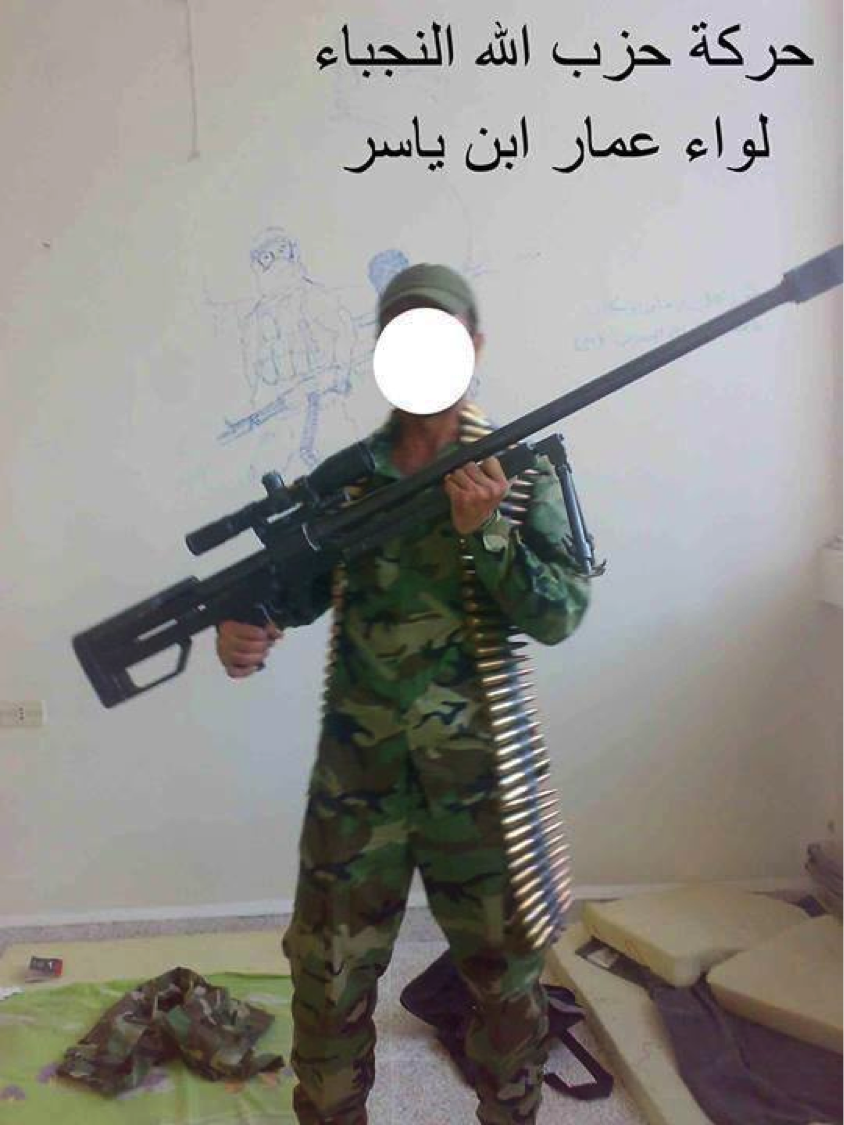

Figure 11: A commander from Liwa’a Ammar Ibn Yasir is seen holding the .50 caliber rifle.
Kata’ib Sayyid al-Shuhada:
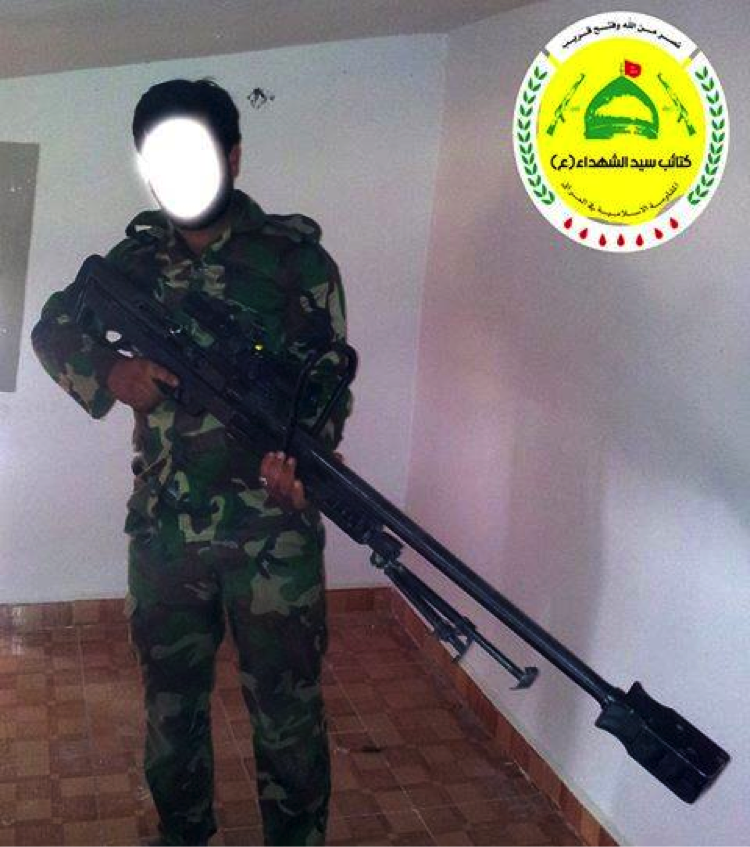
Fighters from Other Groups:
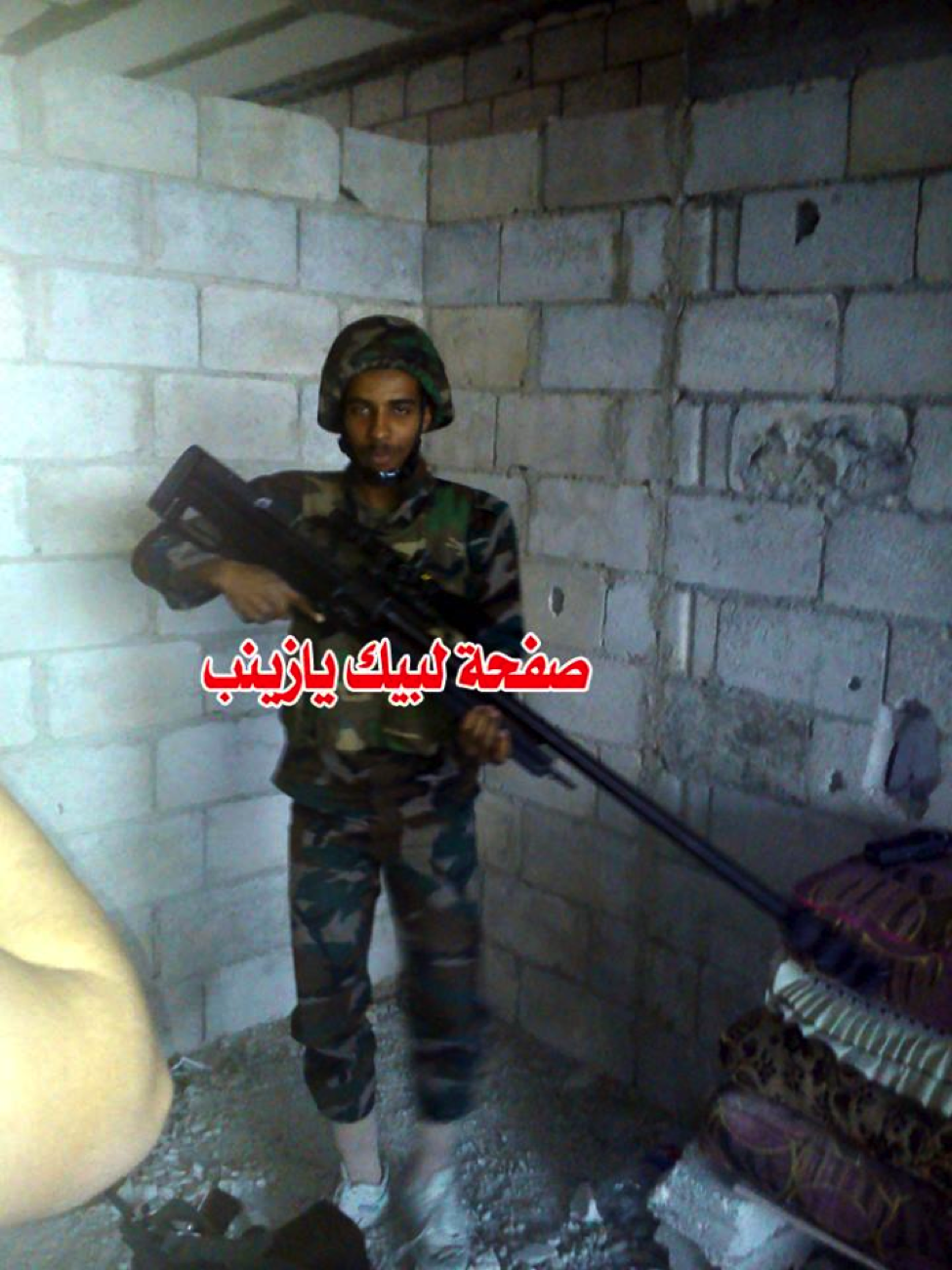
Figure 12: The Shia militia effort’s “first African martyr” (Muhammed Suleiman al-Kuwni) is shown holding the rifle.
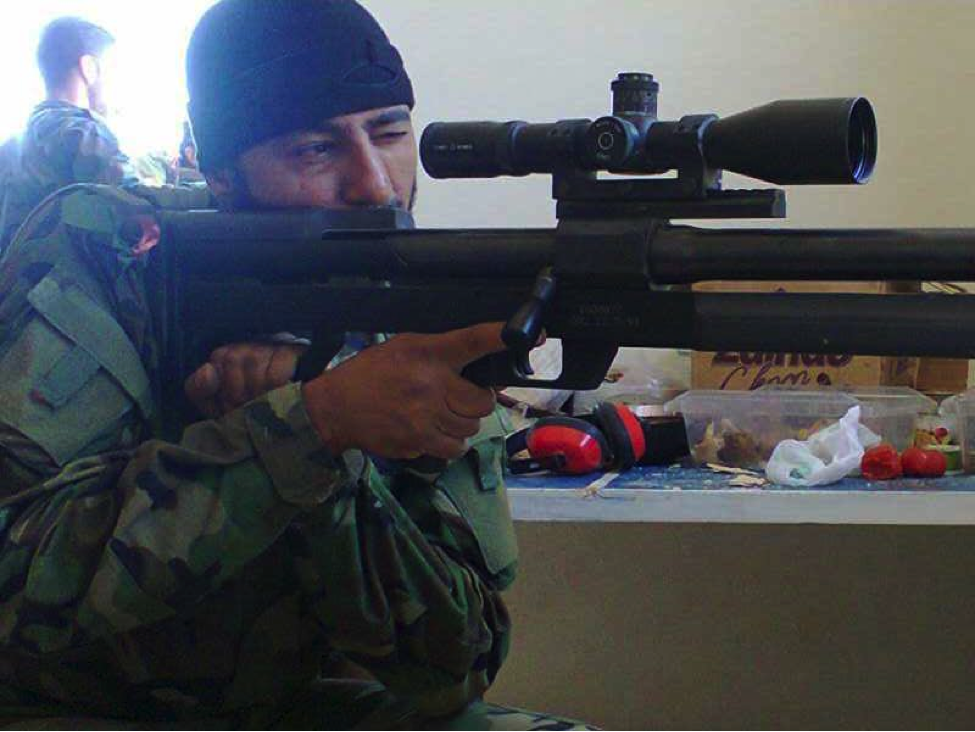
Figure 13: A fighter from an unnamed Shia Islamist militia (likely Liwa’a ‘Ammar Ibn Yasir) take aim with his rifle.
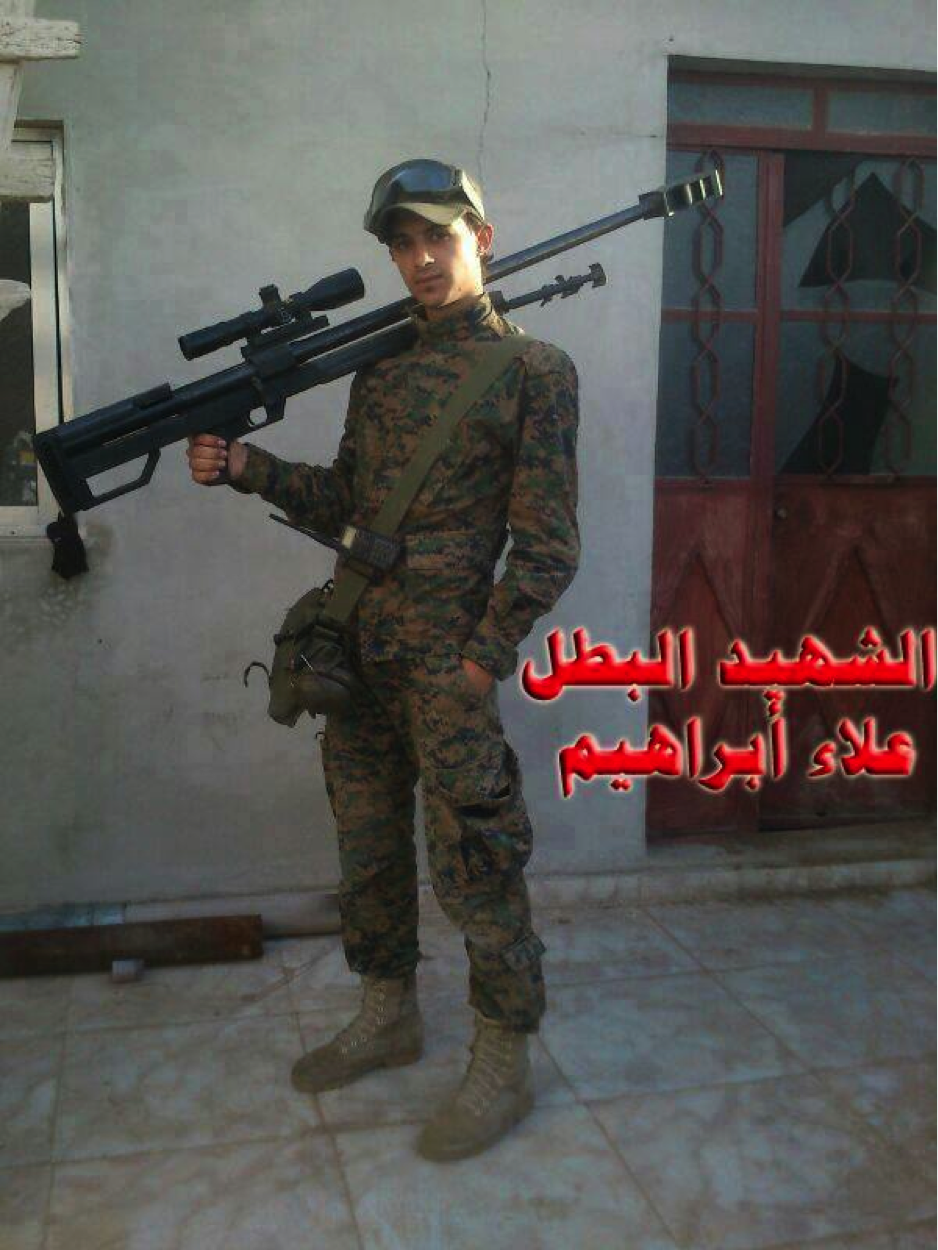
Figure 14: Alla’ Ibrahim (possibly from Liwa’a Zulfiqar), an Iraqi Shi’a fighter buried on November 30, 2013 holds the rifle over his shoulder.
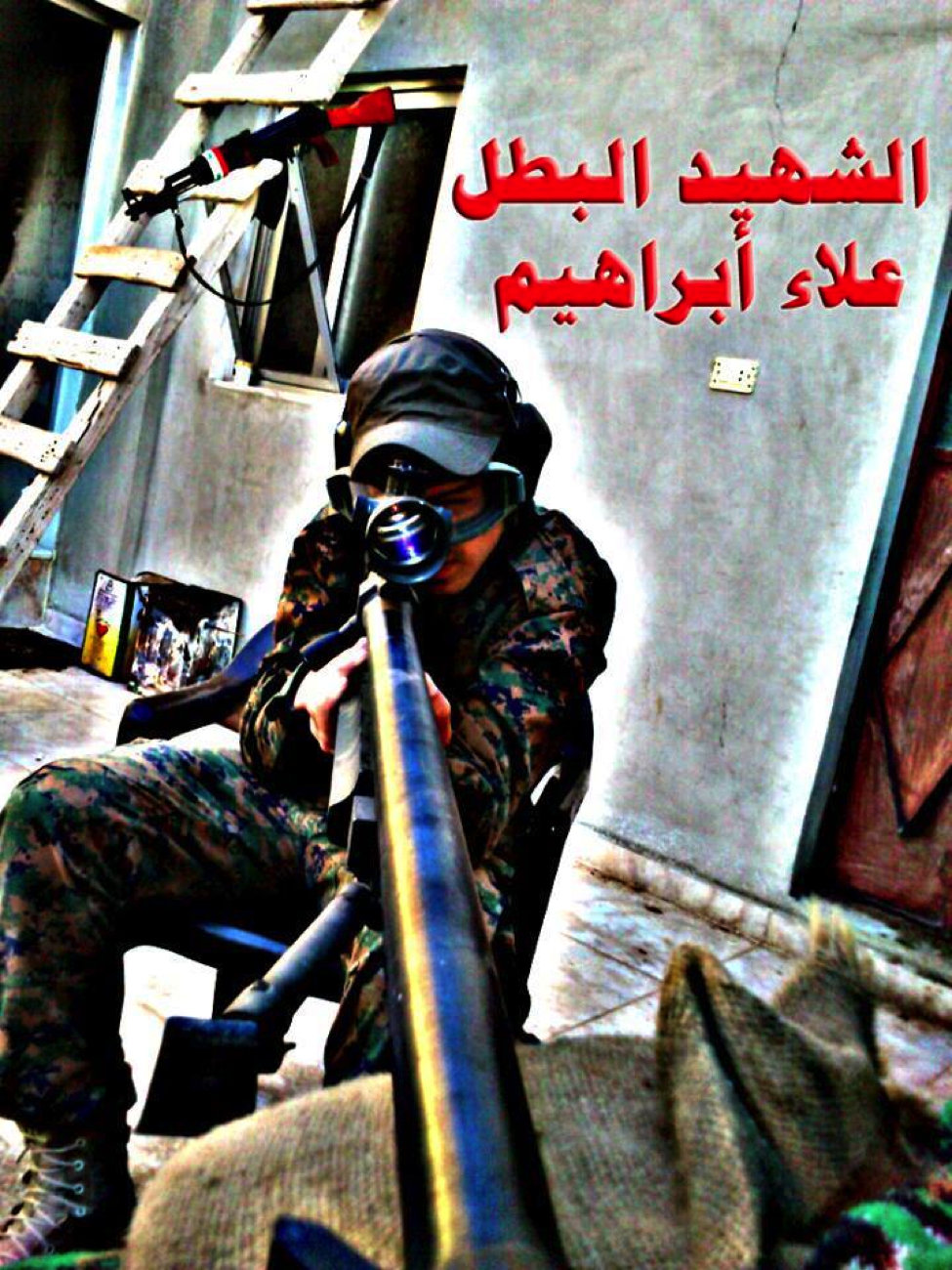
Figure 15: An edited shot of Alla’ Ibrahim shows him posting with the rifle.
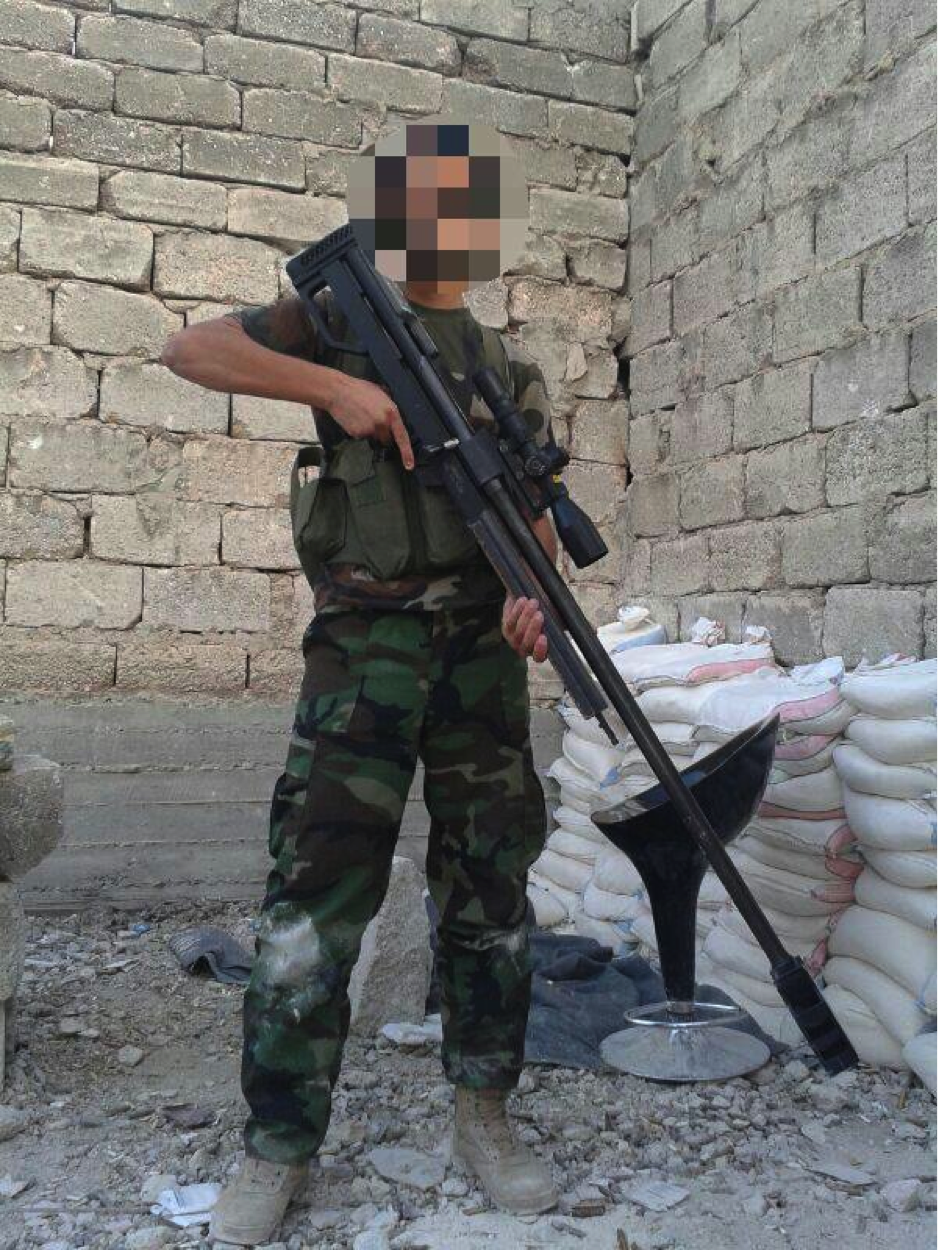
Figure 16: A Shia fighter from an unnamed militia group is shown with the HS. 50-type rifle.
[1] The Oryx Blog has an excellent post on HS. 50-type rifles in Syria: https://spioenkop.blogspot.com/2013/04/syria-and-her-hs50s.html. The post is from April 27, 2013 and pictures of Liwa’a Abu Fadl al-Abbas members with the rifle.
[2] See: https://www.telegraph.co.uk/news/worldnews/1542559/Iraqi-insurgents-using-Austrian-rifles-from-Iran.html
[3] See: https://brown-moses.blogspot.com/2013/04/anti-material-rifles-in-syria.html. See also: https://www.thefirearmblog.com/blog/2012/07/16/mysterious-iranian-50-cals-part-3/. This post by The Firearms Blog should also be read when assessing the rifle in question.
[4] See: https://www.facebook.com/permalink.php?story_fbid=477563188953409&id=174927625878471.
[5] See: https://www.dailytelegraph.com.au/news/opinion/taliban-remain-in-fear-of-lethal-strikes-writes-chris-masters/story-e6frezz0-1226504862496
Hizballah Cavalcade: Liwa’a al-Imam al-Hasan al-Mujtaba: A Shia Militia Fighting in Rif Dimashq/Ghouta
NOTE: For prior parts in the Hizballah Cavalcade series you can view an archive of it all here.
—
Liwa’a al-Imam al-Hasan al-Mujtaba: A Shia Militia Fighting in Rif Dimashq/Ghouta
By Phillip Smyth ([email protected])
Click here for a PDF version of this post
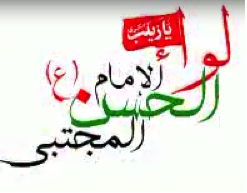
Figure 1: A vidcap of the LIHM’s logo. The symbol reads: “Liwa’a al-Imam al-Hasan al-Mujtaba. A red flag reading, “Ya Zaynab”, a reference to what Shia militias in Syria claim to be fighting for (e.g. the “defense of [the] Sayyida Zaynab” shrine in Damascus) flies on the alif in Liwa’a.
Throughout the summer of 2013, a collection of new Shia militias were announced to be fighting in Syria via social media. On July 23rd, one of these groups was announced on Facebook, carrying the name of Liwa’a al-Imam al-Hasan al-Mujtaba-Sariyya Shahid Ahmed Kayara (The Brigade of Imam Hasan the Chosen-The Martyr Ahmed Kayara Unit or LIHM). LIHM purports to operate in rural and urban sections outside of the city of Damascus. According to material the group has published on social media, the militia has been particularly deployed to defend the Damascus Airport road near Shebaa, in the southeast of Damascus.
The LIHM’s name references Shia Islam’s 2nd Imam, Hasan ibn Ali, who is often referred to in Shia literature as, “The Chosen”. Unlike other Shia militias operating in Syria, LIHM appears to have named sub-divisions of the organization and seems to be more open with announcing the establishment of these groups. Thus, based on social media posts by the group, it can be established that LIHM is split into smaller battalions with differing tasks. This is markedly different from how other Shi’a militias have presented themselves on social media. While it is possible they too have smaller units, usually the names of these groups and the fighters in them are rarely publicized.
Generally, LIHM’s claimed units only post photographs featuring 5-8 fighters. It is unknown if these combat units are limited to only that amount or if they are comprised of larger numbers. LIHM has also claimed to have its own mortar and rocket unit. Other infantry units are called The Abu Hamr Battalion and there is a so-called “Rapid Intervention” unit. The latter is called The Ashtar Battalion (Kata’ib al-Ashtar). It is likely this grouping was named after Malik al-Ashtar, “a long-standing and dedicated follower of the Imam [‘Ali].”[1] The existence of most of these units was announced in September 2013.
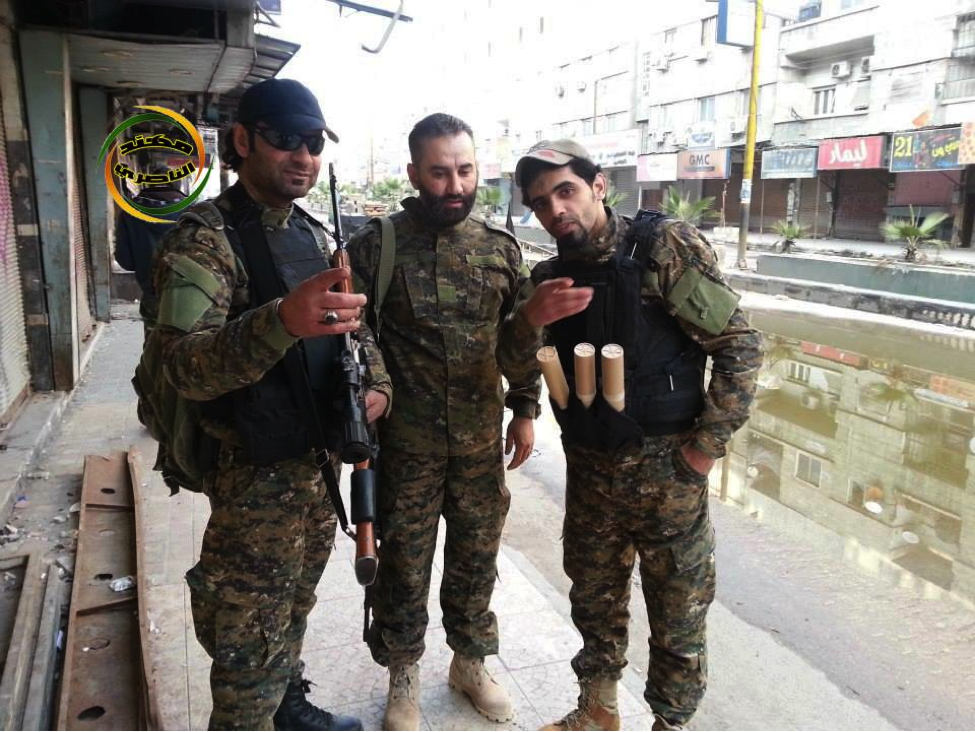
Figure 2: Ahmed Kayara (left holding the SVD-type sniper rifle) stands with other Shi’a militia commanders.
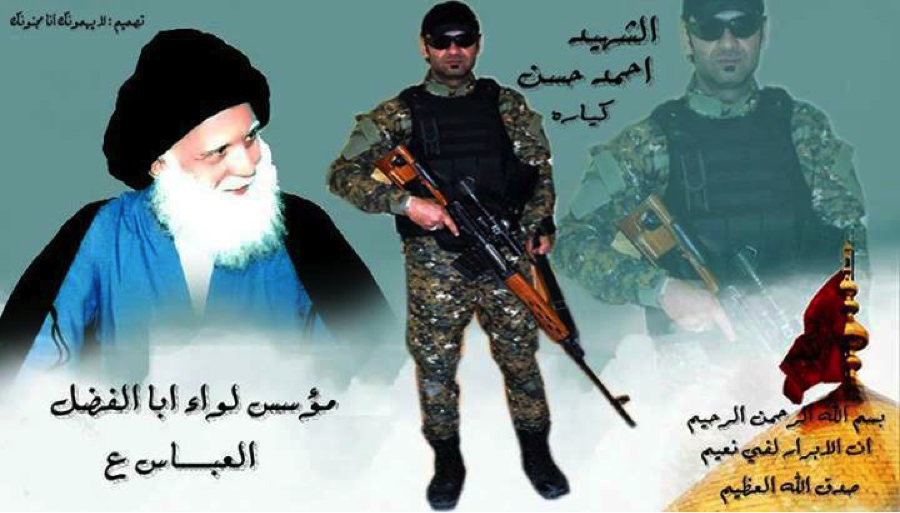
Figure 3: A martyrdom poster featuring Kayara and the late Iraqi Shia Islamist Grand Ayatollah Muhammed Sadiq al-Sadr.
Another one of these subdivisions is Sariyya Shahid Ahmed Kayara or The Martyr Ahmed Kayara Unit. In fact, LIHM’s official Facebook page includes this subdivision in its title. It is claimed that Hajji Thamer leads this group. Ahmed Hasan Kayara, also known by his nom de guerre, Abu Hamza, was one of the first publicly announced dead from the Damascus-based Shia militia, Liwa’a Abu Fadl al-Abbas. Videos of him in combat could be found online in early 2013. It was slowly established on social media circles that he was held a command position in Liwa’a Abu Fadl al-Abbas.
In late May and early June, comments on Kata’ib Sayyid al-Shuhada’s (KSS) original private Facebook group (before it was closed) claimed that some of the killed KSS members in Syria had been part of the Martyr Ahmed Kayara Unit. However, claims of the existence of a similarly named fighting group were only presented by the Facebook supporters of the different Shia militia groups, not by official administrators. Only with the creation of the LIHM’s Facebook were the militia and this particular subunit’s existence formally established.
Unlike other Shia militias operating inside Syria, LIHM has not posted any photographic material showing a link to Iran. However, when basic details regarding their fallen fighters are analyzed, it is clear these militiamen came from an Iranian-backed Iraq-based front group known occasionally as Harakat Nujaba. It has been established that Harakat Nujaba is a front for the Iranian-backed Asa’ib Ahl al-Haq and Kata’ib Hizballah.[2] This front organization was first analyzed on Hizballah Cavalcade when it announced that it was supplying fighters to Liwa’a ‘Ammar Ibn Yasir, a Shia militia which claims to operate in Aleppo. The reasons for excluding the Iranian Revolution (1979) themed material may be part of an effort to create more support for Shia militia operations in Syria along a broader Pan-Shia line.
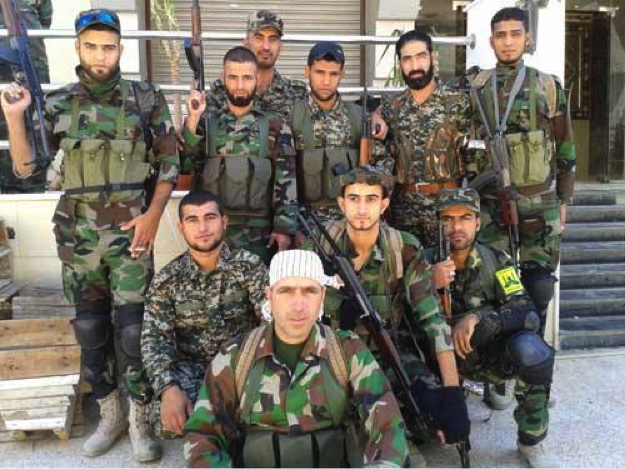
Figure 4: LIHM’s “Rapid Intervention” unit, The Ashtar Battalion.

Figure 5: LIHM’s “Abu Hamr Batallion” (Kata’ib Abu Hamr) which claims it, “protects the holy shrines”.
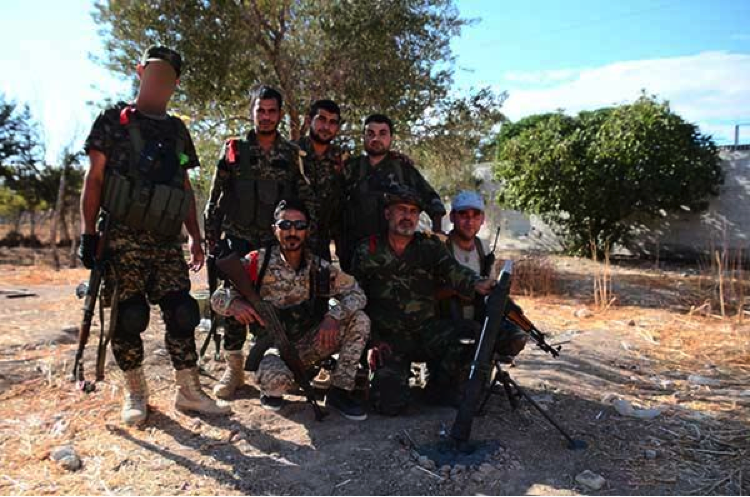
Figure 6: LIHM claims this is their “Mortar and Rocket Battalion”.

Figure 7: Haji Thamer, the commander of LIHM’s Martyr Ahmed Kayara Unit.

Figure 8: An LIHM fighter by the name of Saif al-Salam sits wrapped in a blanket near a sandbagged position.
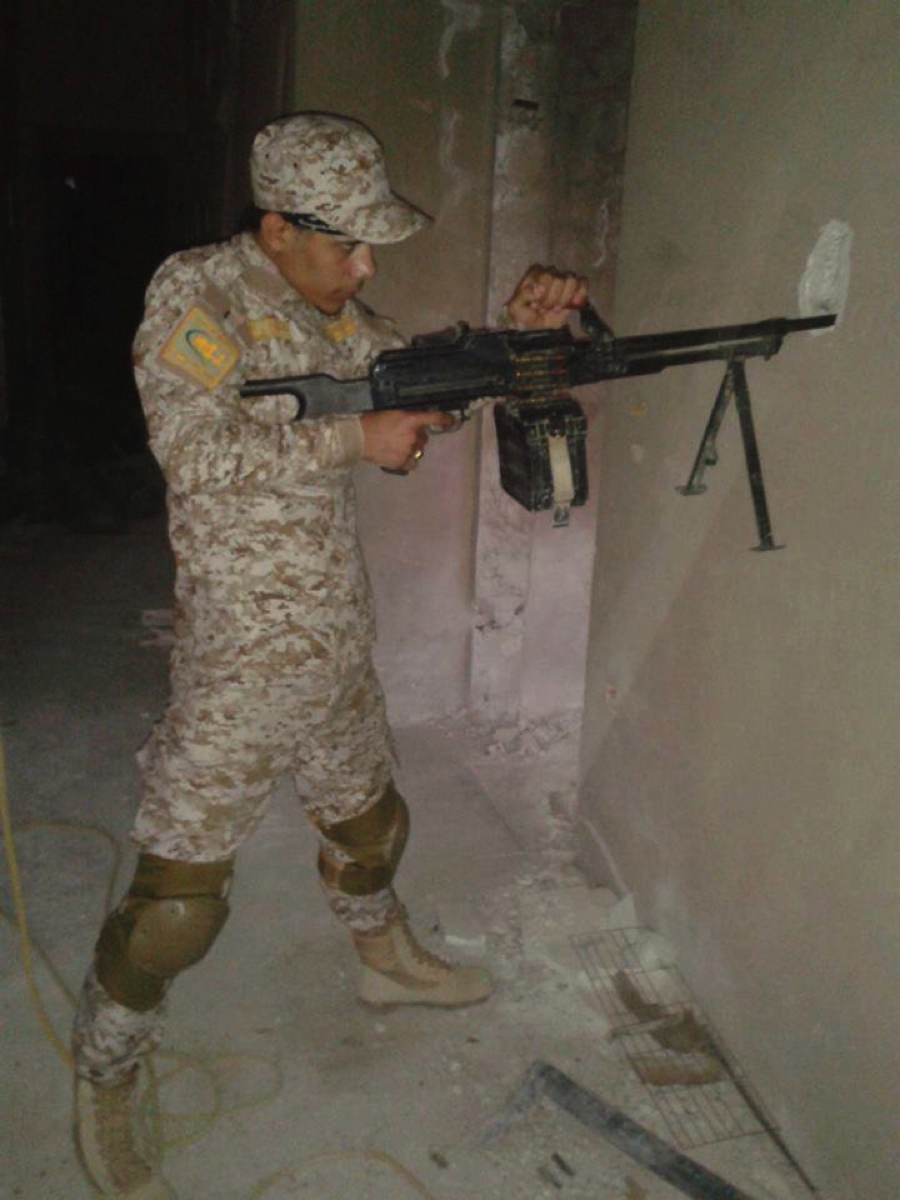
Figure 9: Sajad al-Iraqi, reportedly a member of the LIHM’s Martyr Ahmed Kayara Unit, takes aim with a PKM-type machine gun. Note the distinctive shoulder patch.
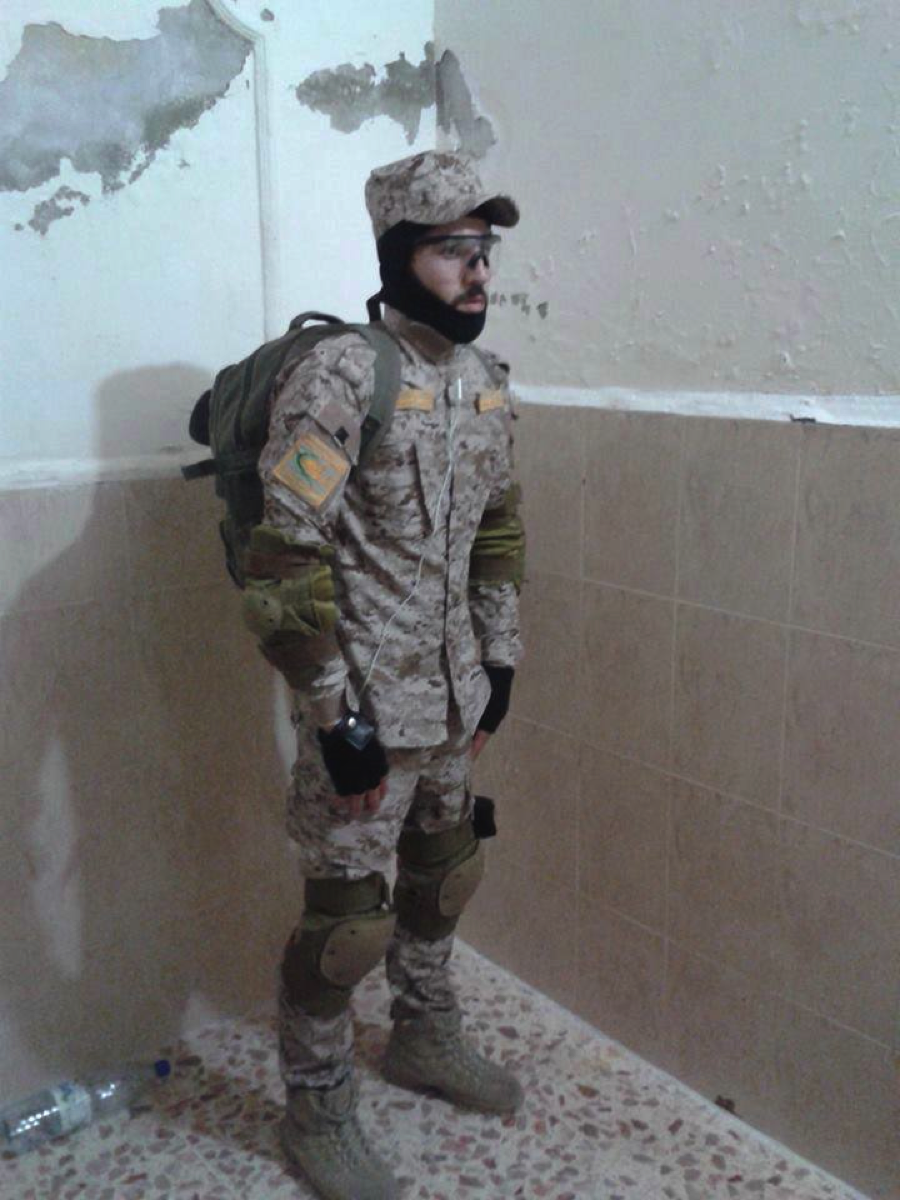
Figure 10: Abu Muqtada al-Baghdadi, another LIHM militiaman. Note the distinctive shoulder patch.
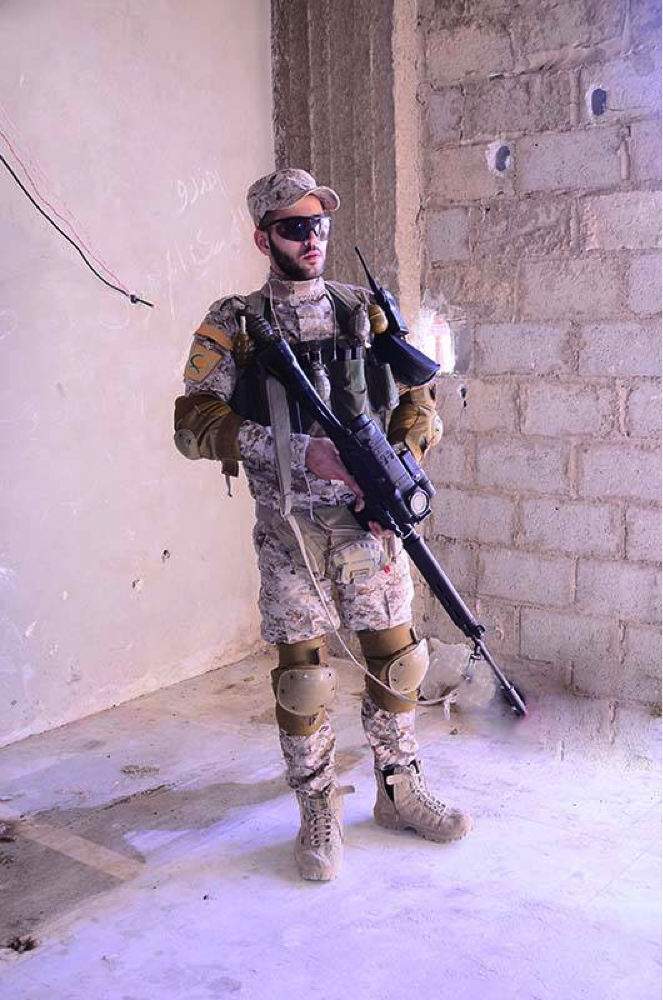
Figure 11: LIHM’s Hashim al-Baghdadi holds a FAL-type rifle mounted with optics. Note the distinctive shoulder patch.
LIHM’s Martyrs
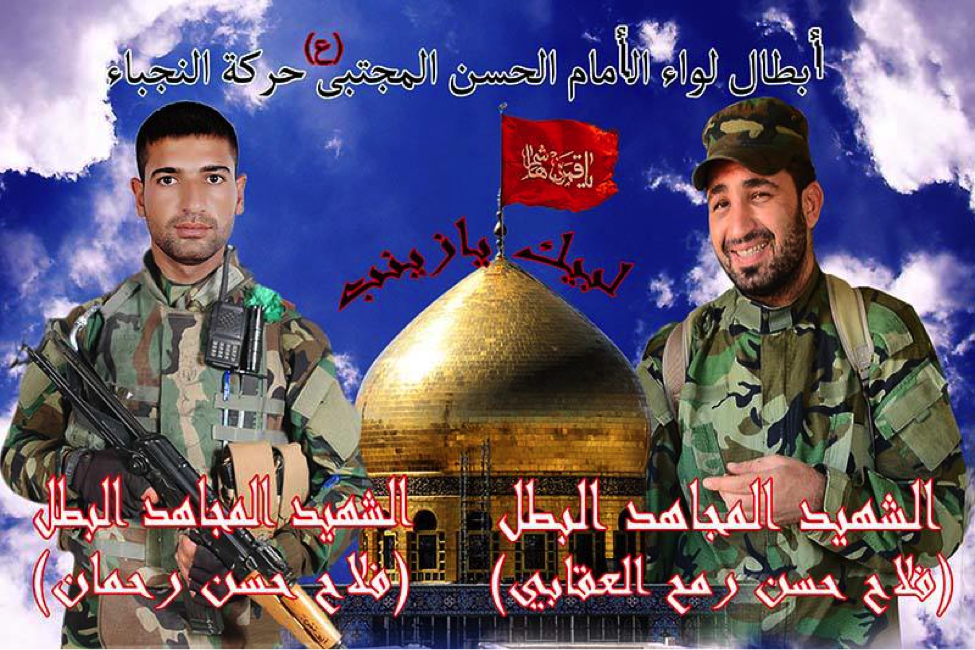
Figure 12: Fala’ Hasan Rahman (left) and Fala’ Hasan Rama’ al-‘Aqabi (right) are pictured in a joint martyrdom poster. In the center sits the golden dome of the Sayyida Zaynab Shrine in Damascus. This and other posters identify them as members of Harakat Nujaba.
Name: Fala’ Hasan Rama’ al-‘Aqabi
Death Announced: September 2, 2013
Notes: ‘Aqabi’s was listed as a member of the Harakat Nujaba. Harakat Nujaba is a front set-up by Kata’ib Hizballah and Asa’ib Ahl al-Haq to funnel fighters from Iraq to Syria. The group is the main front which supplies fighters to Liwa’a Ammar Ibn Yasir.
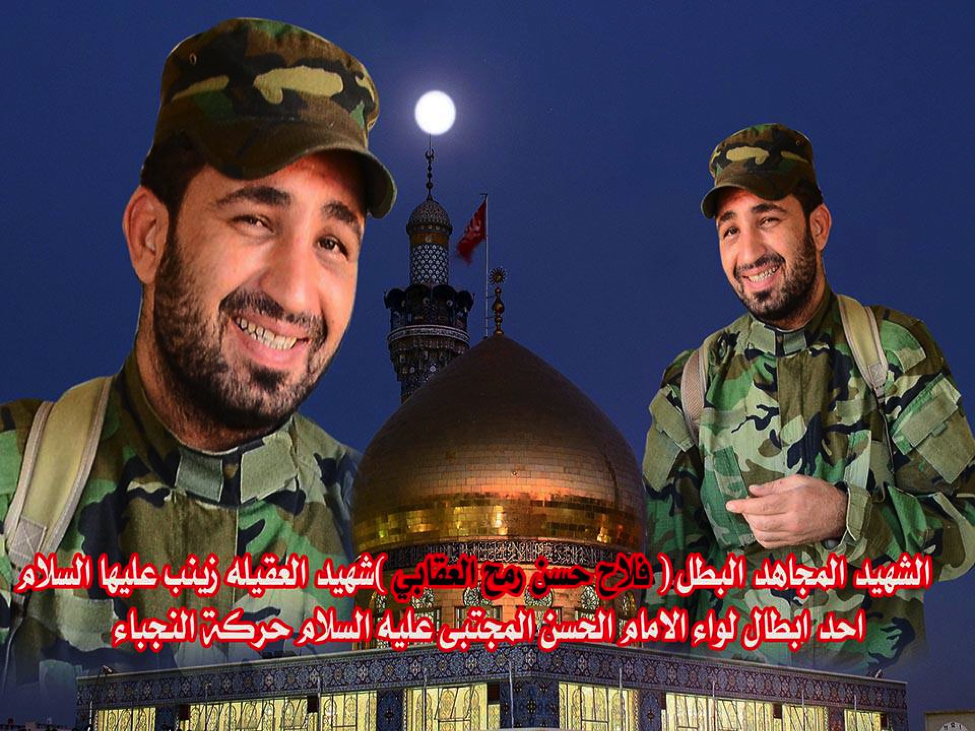
Name: Fala’ Hasan Rahman
Death Announced: September 3, 2013
Notes: Rahman was listed as a member of Harakat Nujaba.
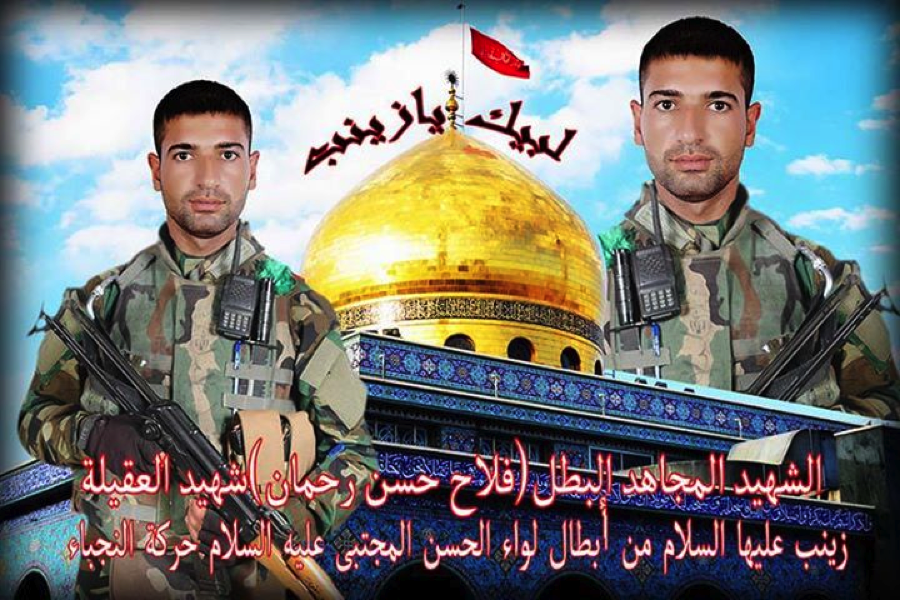
Combat Videos
LIHM’s fighters have been featured in a number of videos uploaded to YouTube and Facebook. In one of the videos, an interviewer claims the group is fighting, “irhab al-kafir” or “infidel terrorism”. Shia identity is also reinforced with the singing of an ad hoc nashid and chants which praise historic and symbolic Shia leaders like Abbas and Zaynab.
Like other Shia militias in Syria, these videos often feature videos demonstrating the group’s acumen when it comes to deploying snipers. One interesting feature of these clips is to show LIHM fighters firing a round and then showing a split screen utilizing footage of Syrian rebels being shot and killed. Additionally, common Syria-oriented Shia militia songs used by other Shia militias and some older footage from Liwa’a Abu Fadl al-Abbas (particularly video of Ahmed Kayara) has been repackaged in these videos.
[1] Reza Shah-Kazemi, “A Sacred Conception of Justice: Imam ‘Ali’s Letter to Malik al-Ashtar” in M. Ali Lakhani, The Sacred Foundations of Justice in Islam: The Teachings of ʻAlī Ibn Abī Ṭālib, (North Vancouver, B.C.: Sacred Web Publishing, 2006), P.64. [2] See: https://www.reuters.com/article/2013/08/30/us-syria-crisis-iraq-idUSBRE97T0XH20130830
Hizballah Cavalcade: Kata’ib Sayyid al-Shuhada Emerges: Updates on the New Iraqi Shia Militia Supplying Fighters to Syria
NOTE: For prior parts in the Hizballah Cavalcade series you can view an archive of it all here.
—
Kata’ib Sayyid al-Shuhada Emerges: Updates on the New Iraqi Shia Militia Supplying Fighters to Syria
By Phillip Smyth ([email protected])
Click here for a PDF version of this post
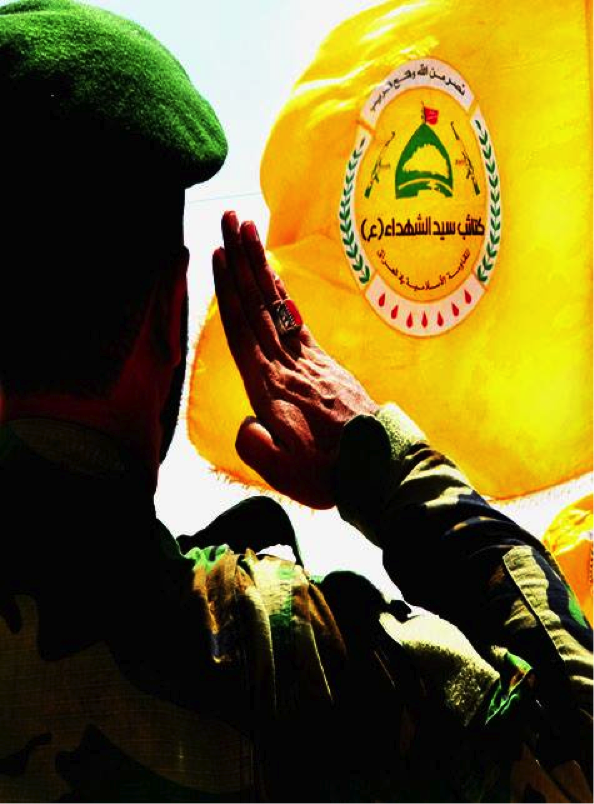
Figure 1: A KSS member salutes the group’s flag.
When Kata’ib Sayyid al-Shuhada (KSS) first announced their presence to the world, little was known about the organization, its leadership, or its force size. Funerals the group held for three of its fallen fighters in May not only announced the group’s existence, but also pointed to a strong link with Iran. However, following these funerals, little was heard from the group. Nevertheless, it would appear that starting in August the organization has fully redeveloped its messaging and online propaganda. This campaign has included well-organized and professional group funerals for members killed fighting in Syria, brand new and far-less amateurish imagery, and the introduction of some more unique features in KSS’s propaganda. Even the group’s uniforms have undergone a type of remake, featuring the KSS’s logo and patches showing their fighter’s commitments to “Defending Sayydiah Zaynab”.
The group has also been more open when it came to the numbers of its fighters deployed to Syria. In an Al-Sharqiya interview held with KSS’s information office, the group claimed to have sent 500 members to Syria.[1] Public announcements by the group have also established that since July, KSS has deployed a number of combat units to more rural zones around Damascus, particularly the frontlines in East Ghouta.
Additionally, via official websites belonging to the Badr Organization Military Wing, it is possible that a closer relationship exists between KSS and the Badr Organization. Since Badr did not announce its involvement in Syria until July, 2013, this may be a signal that KSS was used as a front group to send Badr fighters to Syria.
In terms of a social media presence, KSS has tried to reinvent itself. When the group’s more private group page was removed from Facebook, the organization simultaneously established a new Facebook page and more private profiles to disseminate photos and other information about the group. Since August, KSS has posted 1-4 unique new photographs of their activities in Syria. Additionally, other pro-Shia militia-in-Syria Facebook pages have re-posted their photographs.
Social media stature aside, the group’s rapid public growth, increased professionalism, combat deployments, and growing presence in Iraq—beyond its original base in Basra, demonstrates KSS as a rapidly growing Shia militia force. It is likely KSS will continue to announce its militant activities in Syria.
The Fighters
The fighters of Kata’ib Sayyid al-Shuhada appear to be uniformed with clear identifiable insignia. The combatants carry arms which are familiar to other Shia militia groups, particularly the PKM machine gun, RPG-7s, Kalashnikov-type assault rifles, and the popular SVD-style sniper rifle. KSS fighters have also been photographed with anti-material sniper rifles.
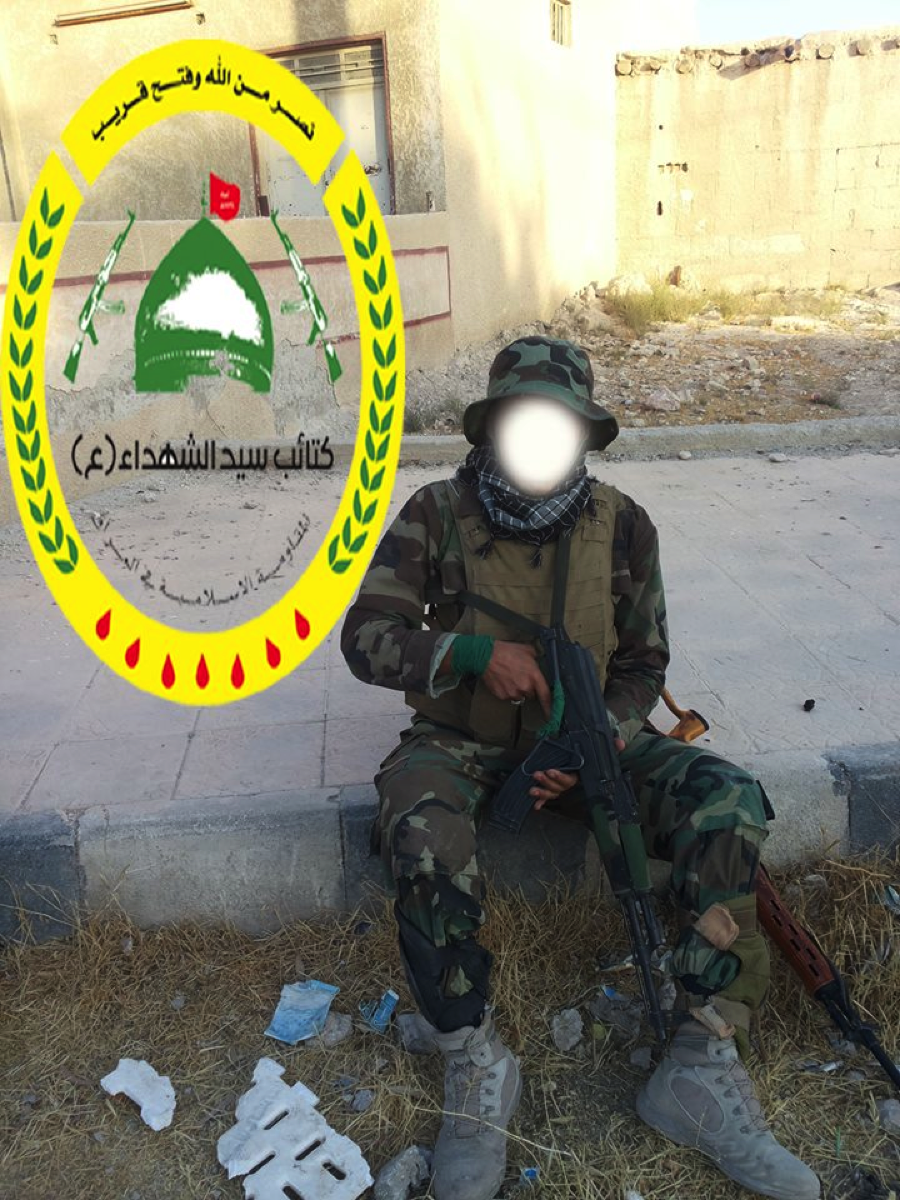
Figure 2: A KSS fighter with a customized Kalashnikov-type rifle and an SVD style sniper rifle.
Figure 3: A KSS fighter poses with a mortar.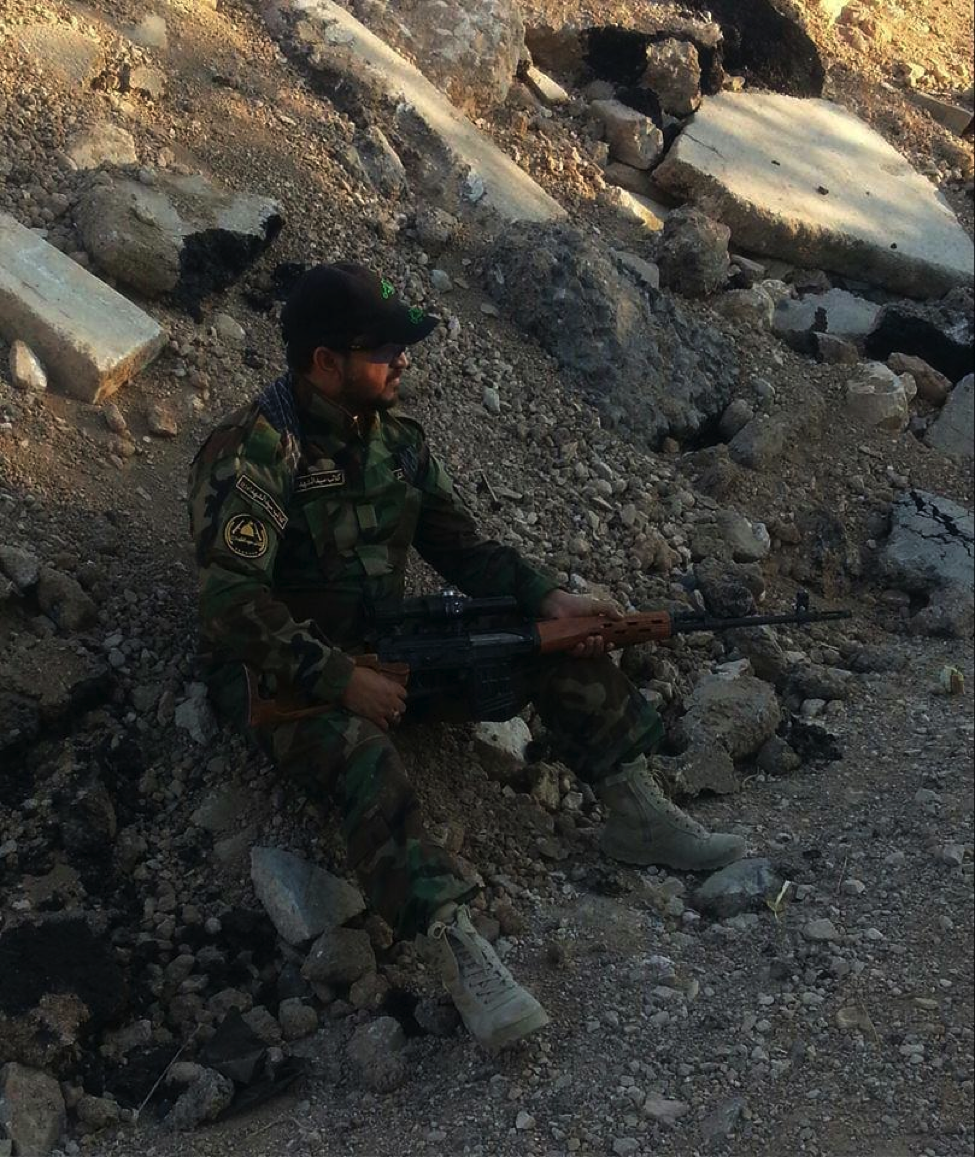
Figure 4: A KSS fighter poses on rubble with an SVD style sniper rifle. Note the KSS logo patch.
Figure 5: A KSS fighter holds an RPG-7.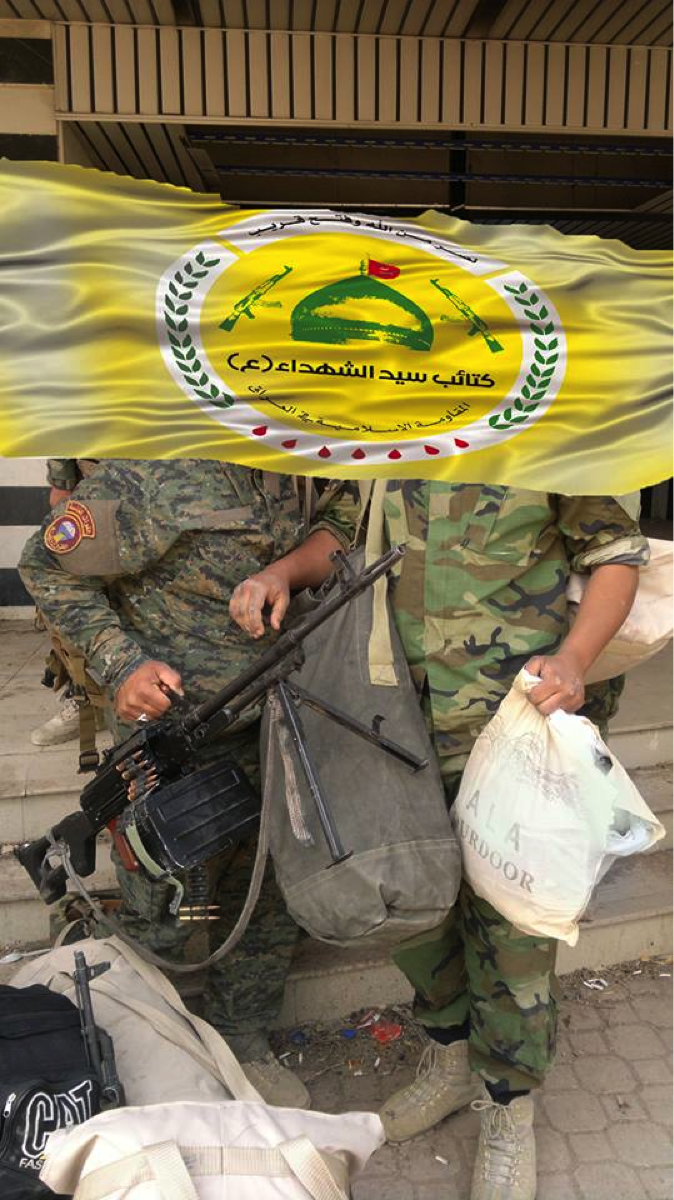
Figure 6: KSS fighters pose with a PKM machine gun.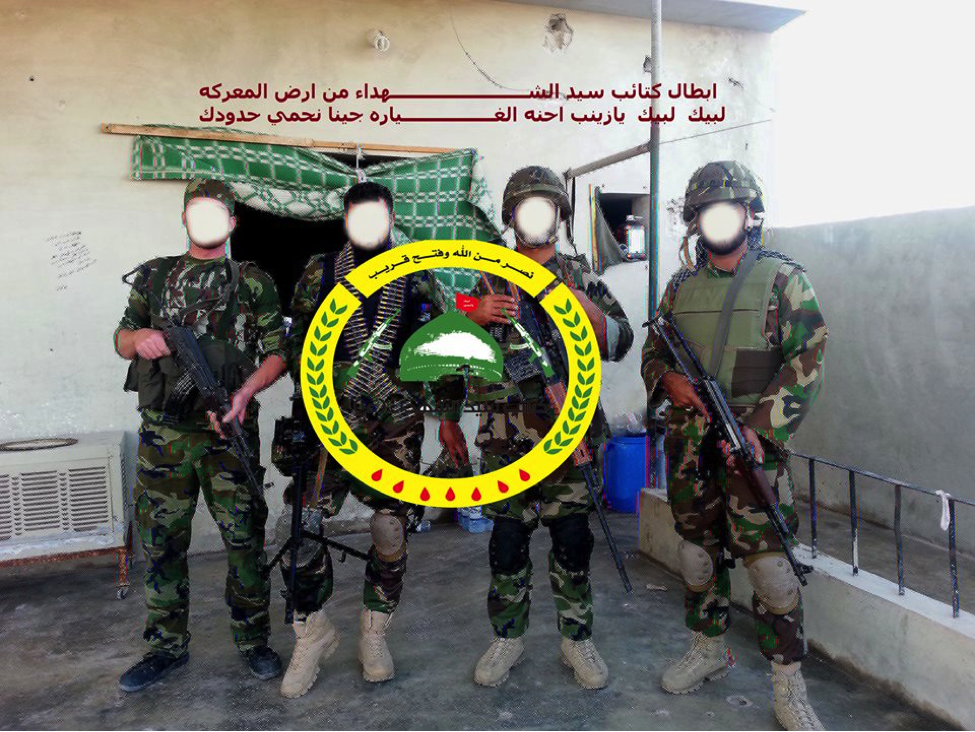
Figure 7: A small unit of KSS fighters holding a mixture of Kalashnikov type rifles, an SVD style sniper rifle, and a PKM machine gun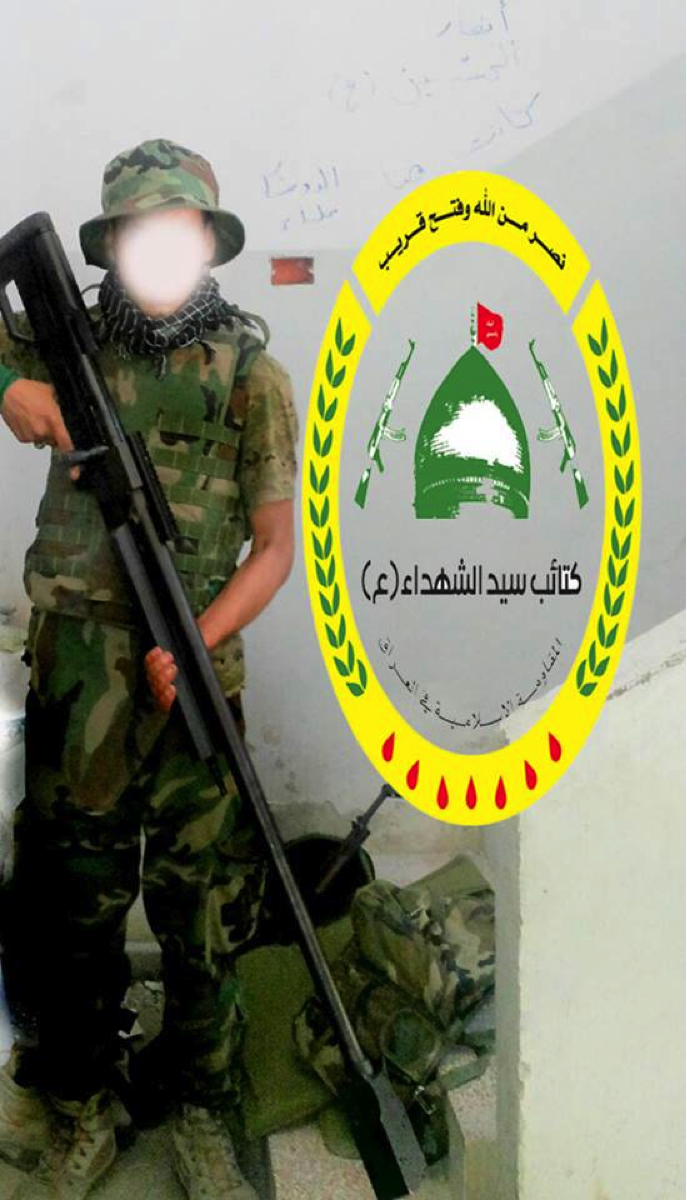
Figure 8: This KSS fighter appears to be holding a Steyr HS .50 style, .50 caliber bolt action anti-material sniper rifle. The rifle could also be an Iranian copy of the HS .50.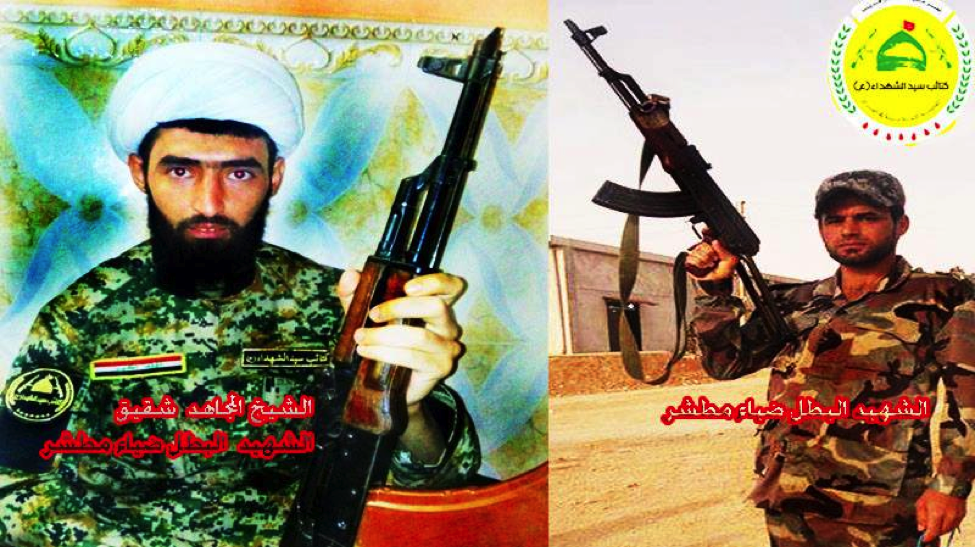
Figure 9: Diya Issawi’s brother (left), pictured in a white turban of commonly found with Shia clerics. He was listed by KSS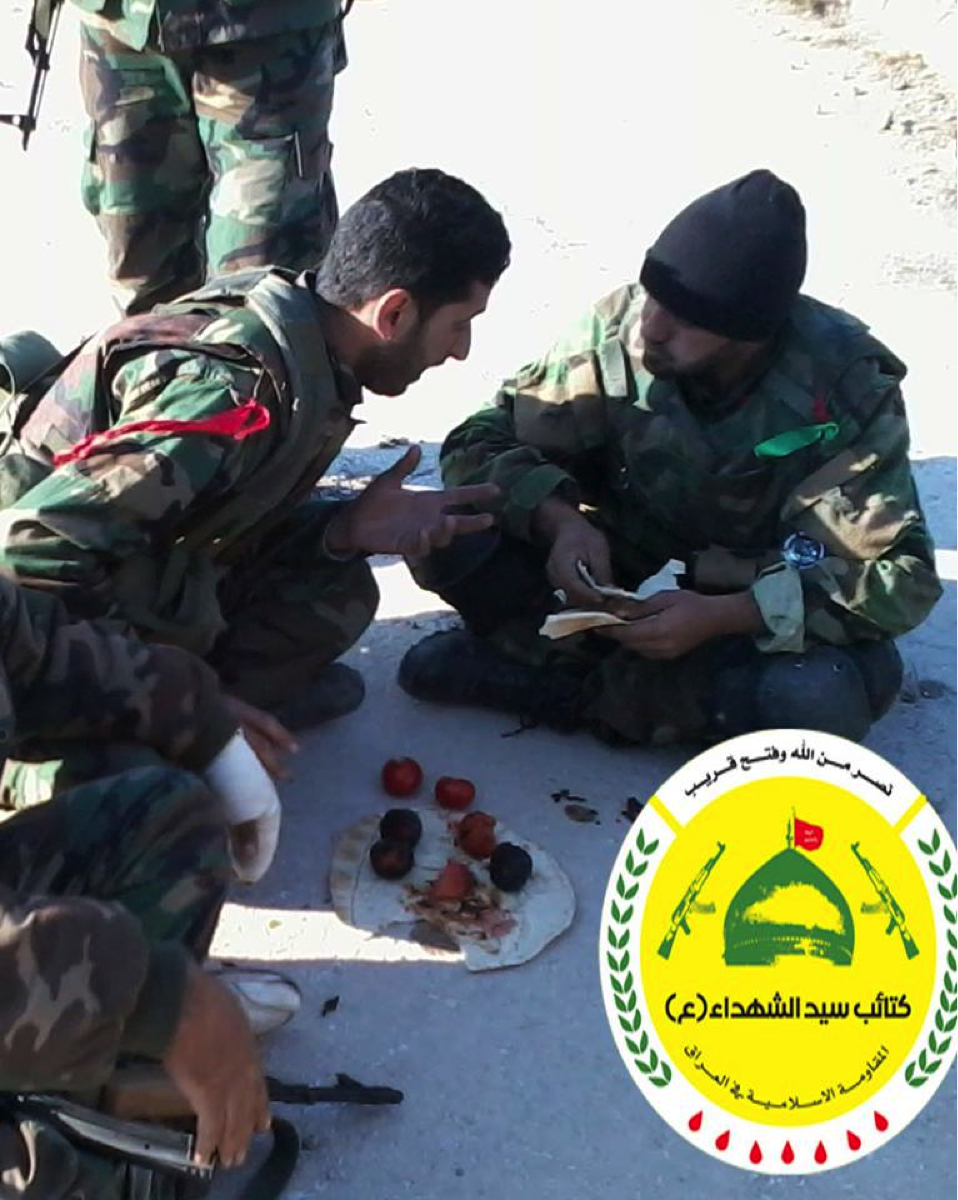
Figure 10: KSS members “Enjoy a simple modest lunch”. This photo was issued by the group to demonstrate the humility of their fighters.
The KSS’s New Martyrs
On August 20, a main Facebook page which publishes information about Shia militia operations and deaths in Syria, claimed that Kata’ib Sayyid al-Shuhada was operating in East Ghouta. During their operations in the area, the page reported three fighters as killed-in-action, with another five missing (listed in the post as, “Fate unknown”).
On August 24, KSS released eight martyrdom announcements in the form of more professionally designed graphics. The photographs were first released on the KSS and then the Badr Organization Military Wing’s official Facebook page. The posted images presumably show the eight fighters who were killed or who were missing in East Ghouta, in Rif Dimashq. It is important to note that on August 21, East Ghouta was also the reported as the scene of the deadliest chemical weapons attack within Syria.[2] According to American Military University’s In Homeland Security Blog chief correspondent and chemical weapons expert, William Tucker, it is possible these KSS fighters were, “bracketing the kill box”.[3] Meaning, they had generally surrounded the area where the chemical weapons were used and then attacked any Syrian rebel elements which may have tried to breakout.
However, a video emerged on September 1st showing some of the KSS fighters being killed in an assault by rebel forces. A longer video of the engagement was released on September 7th. The KSS fighters were reportedly stationed in what rebels referred to as a train station in East Ghouta. This would suggest that some of the KSS fighters may have been guarding transportation links in the area.
** Warning: Graphic Imagery **
In the video, it is clear to see that KSS fighters openly wear the insignia for their organization during combat operations. Some KSS and possibly Hizballah fighters are shown with Shia Islamic paraphernalia. One card removed from the pocket of a dead fighter featured a stylized photo of the assassinated Hizballah terror-leader, Imad Mughniyeh.[4]
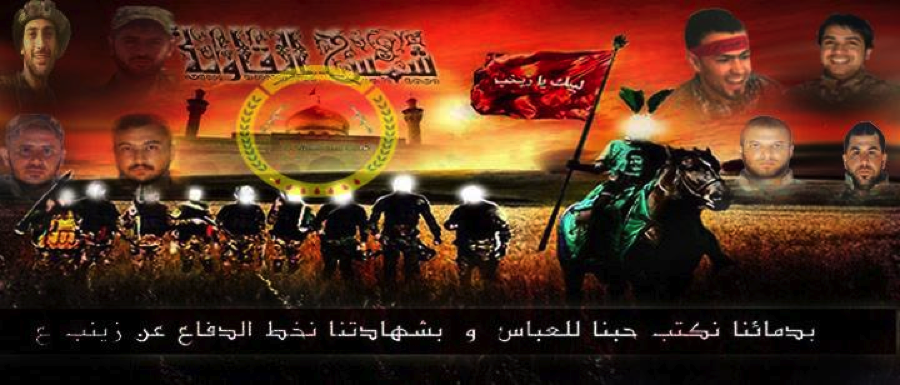
Figure 11: Eight of the dead KSS members are featured on this poster.
Name: Amir al-Badlawi
Death Announced: September 5, 2013
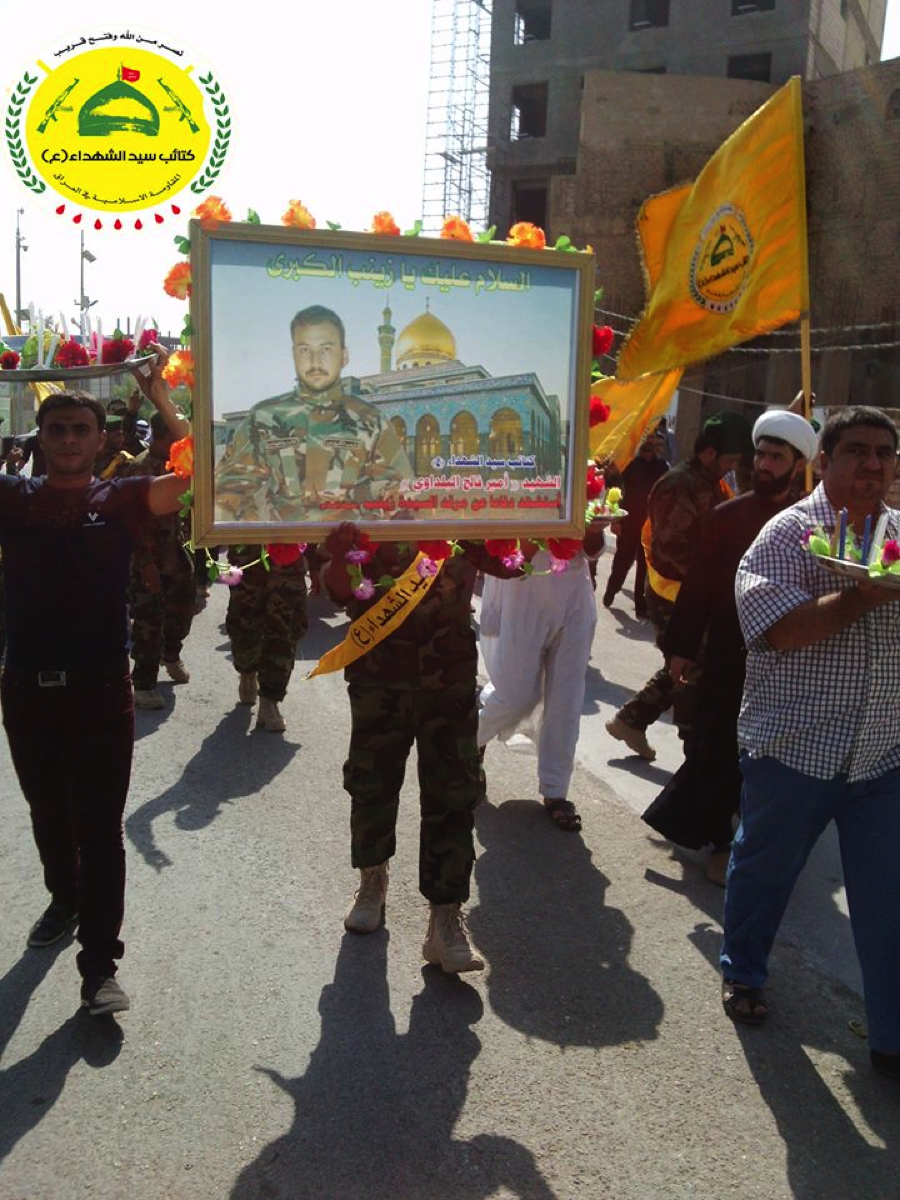
Name: Muhammed Radi al-Shumaylawi
Death Announced: August 24, 2013. Funeral held on August 27, 2013.
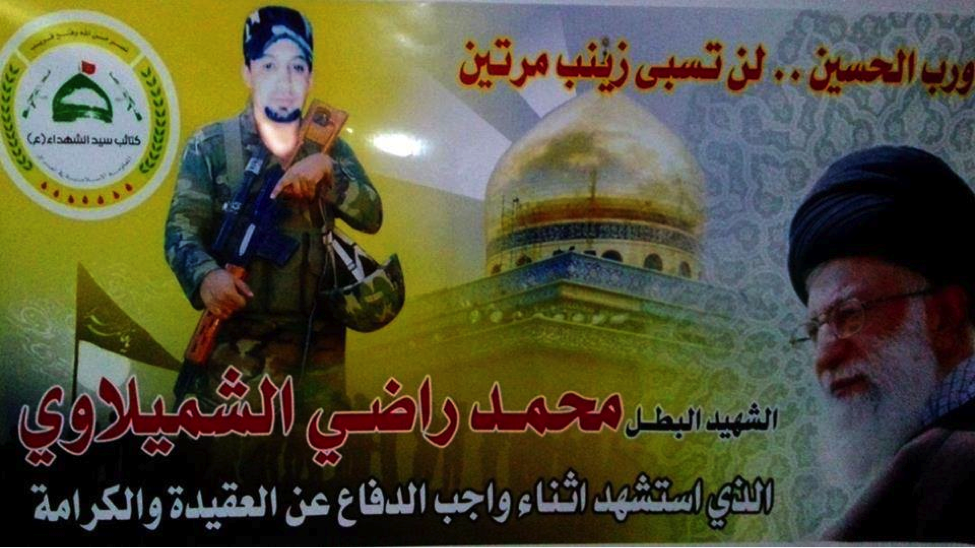
Name: Al-Said Hasan ‘Ali Farhoud al-Furaydawi
Death Announced: August 11, 2013
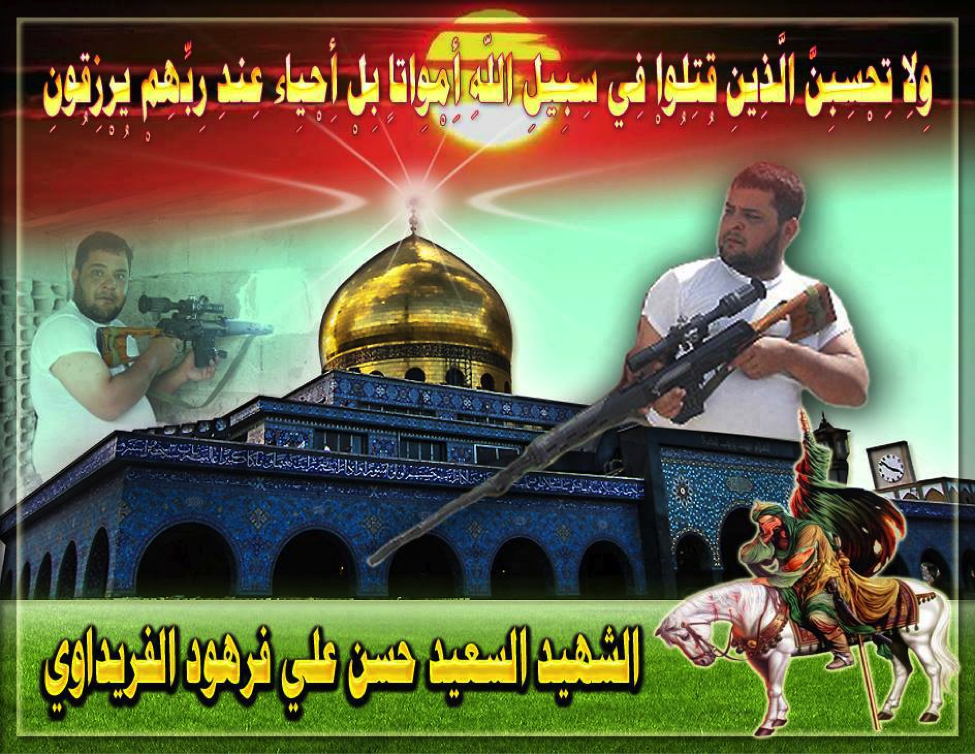
Name: Sejjad al-Shibani
Death Announced: August 23, 2013, reportedly killed on August 20, 2013, funeral reportedly held on August 27, 2013.
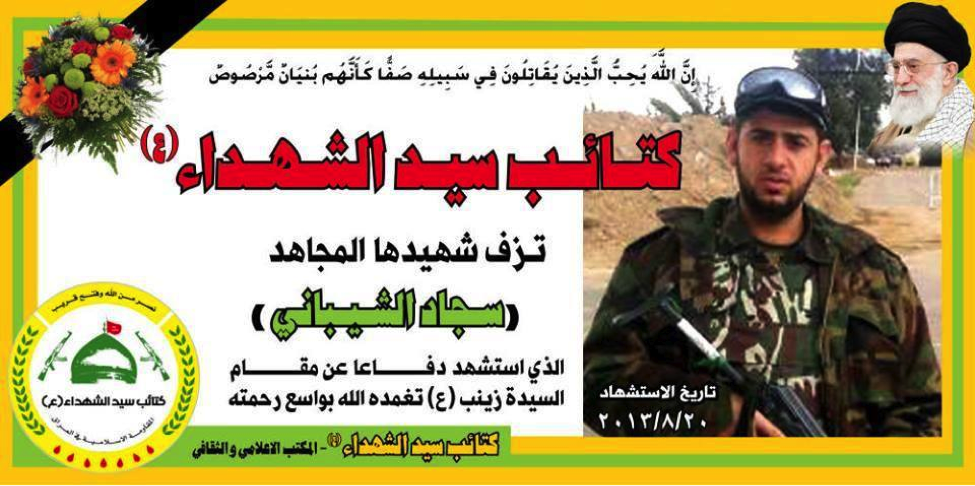
Name: Walid al-‘Abudi
Death Announced: August 23, 2013, reportedly killed on August 20, 2013.

Name: ‘Ali Hamza al-Deraghi al-Sadiqi
Death Announced: August 23, 2013, reportedly killed on August 20, 2013, funeral reportedly held on August 27, 2013.
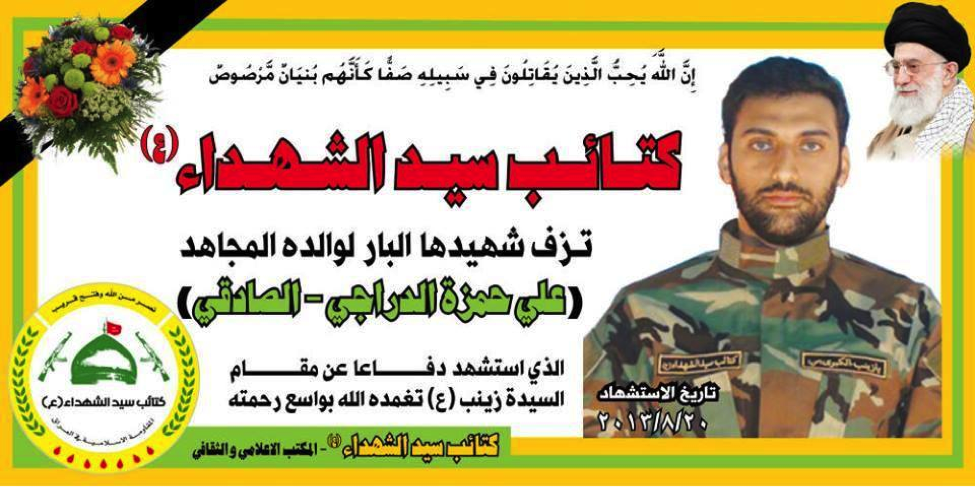
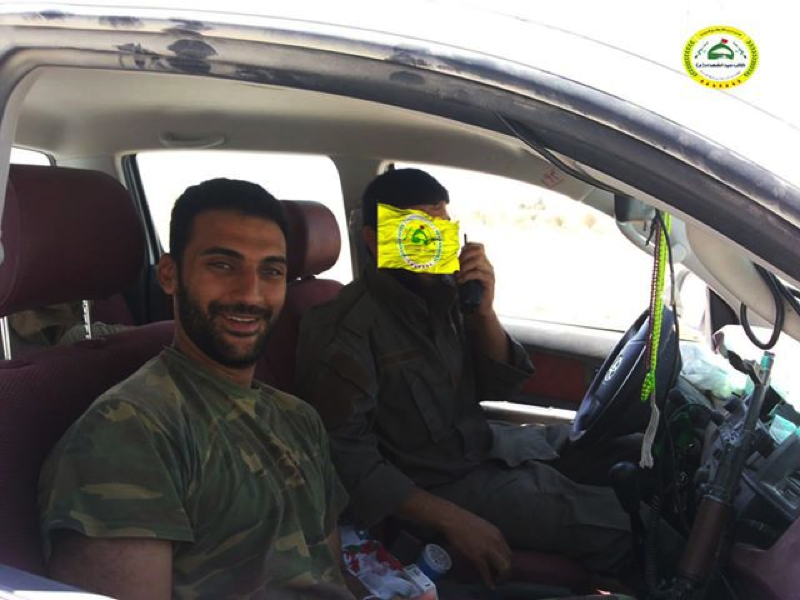
Figure 12: Sadiqi is shown in a car with what may be another KSS member and a Kalashnikov style rifle.
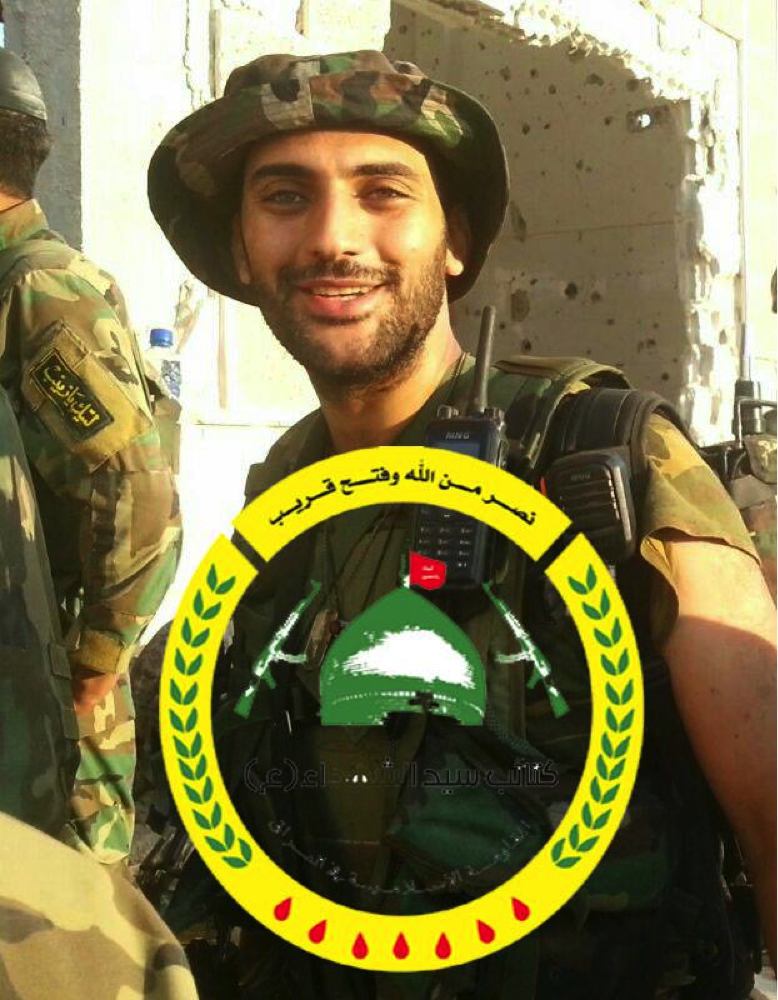
Figure 13: An official KSS release of Sadiqi with other KSS fighters.
Name: Zulfiqar al-Raseetmawi
Death Announced: August 25, 2013, reportedly killed on August 20, 2013, funeral reportedly held on August 27, 2013.
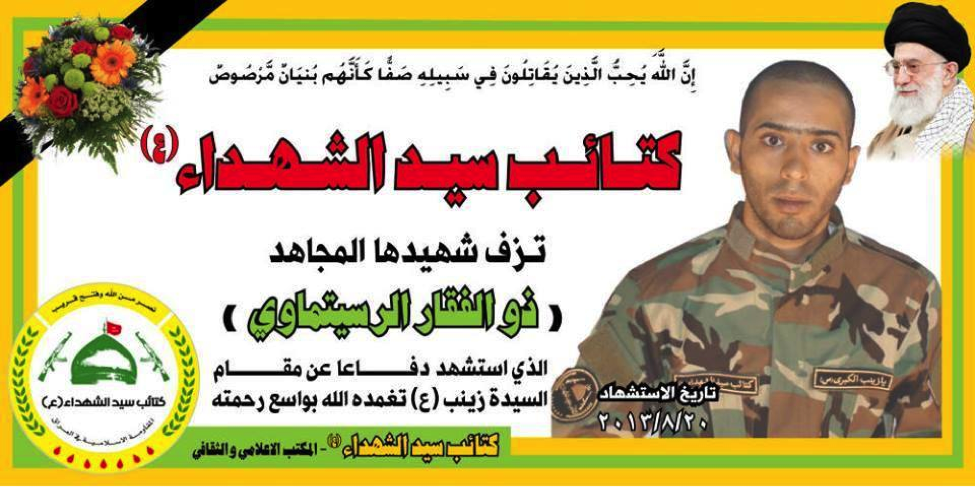
Name: Muhammed ‘Abd al-Husayn al-Faridawi
Death Announced: August 25, 2013, reportedly killed on August 20, 2013, funeral reportedly held on August 27, 2013.
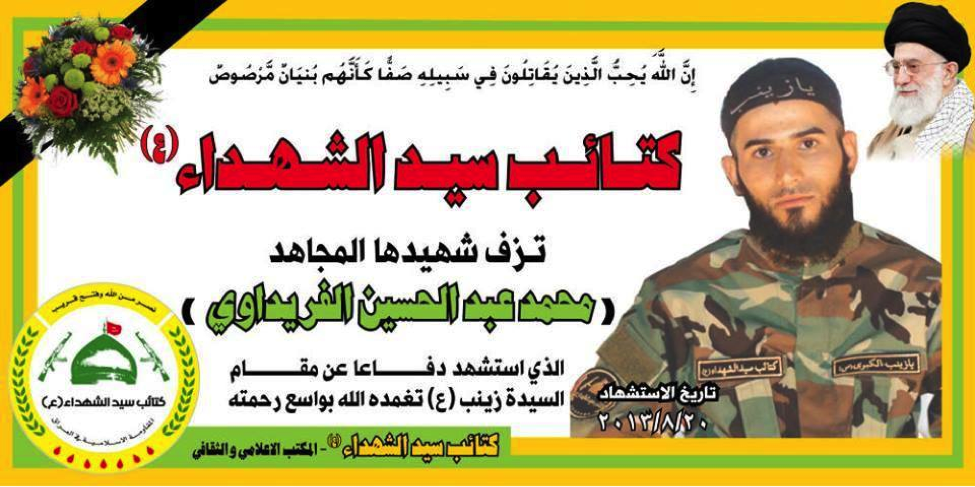
Name: Ala al-Ka’bi
Death Announced: August 23, 2013, reportedly killed on August 20, 2013, funeral reportedly held on August 27, 2013.
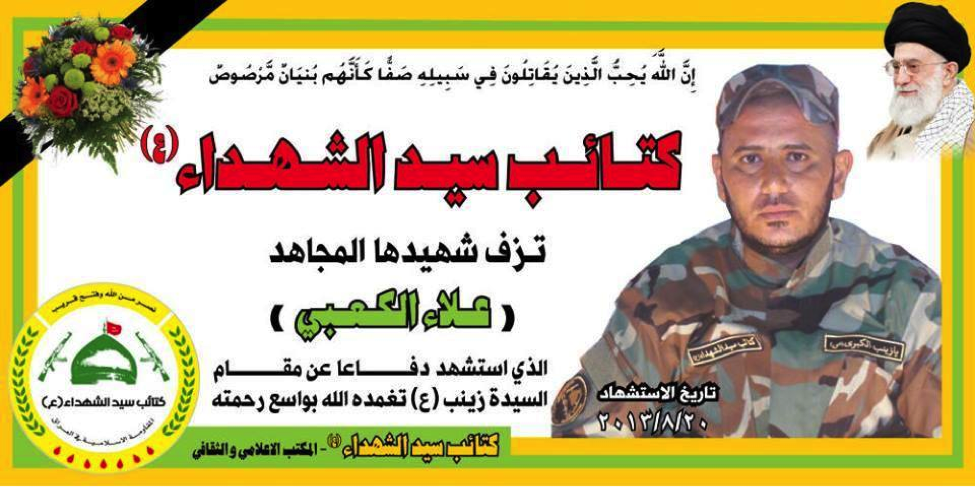
Name: Watheq Hashem al-‘Anzi
Death Announced: August 23, 2013, reportedly killed on August 20, 2013, funeral reportedly held on August 27, 2013.

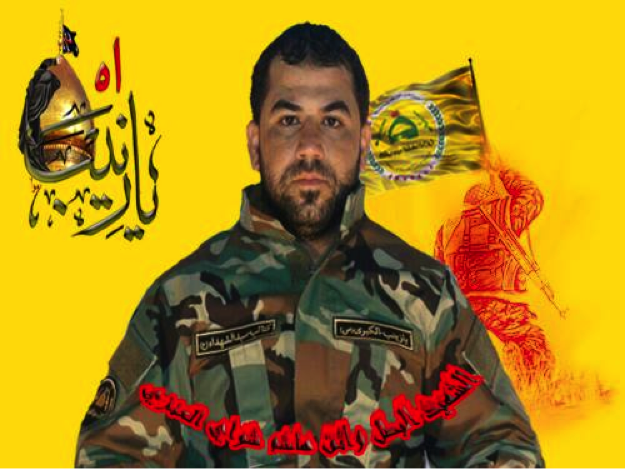
Figure 14: An officially produced martyrdom post
Name: ‘Ali Sami al-Zubaydi
Death Announced: August 23, 2013, reportedly killed on August 20, 2013, funeral reportedly held on August 27, 2013.
Notes: Zubaydi was one of the few KSS dead who had other photos of him in Syria uploaded to a number of pro-Shia militia
Hizballah Cavalcade: The Lion of Damascus, and Afghans, and Africans! Oh My!: Fighters From Exotic Locales In Syria’s Shia Militias
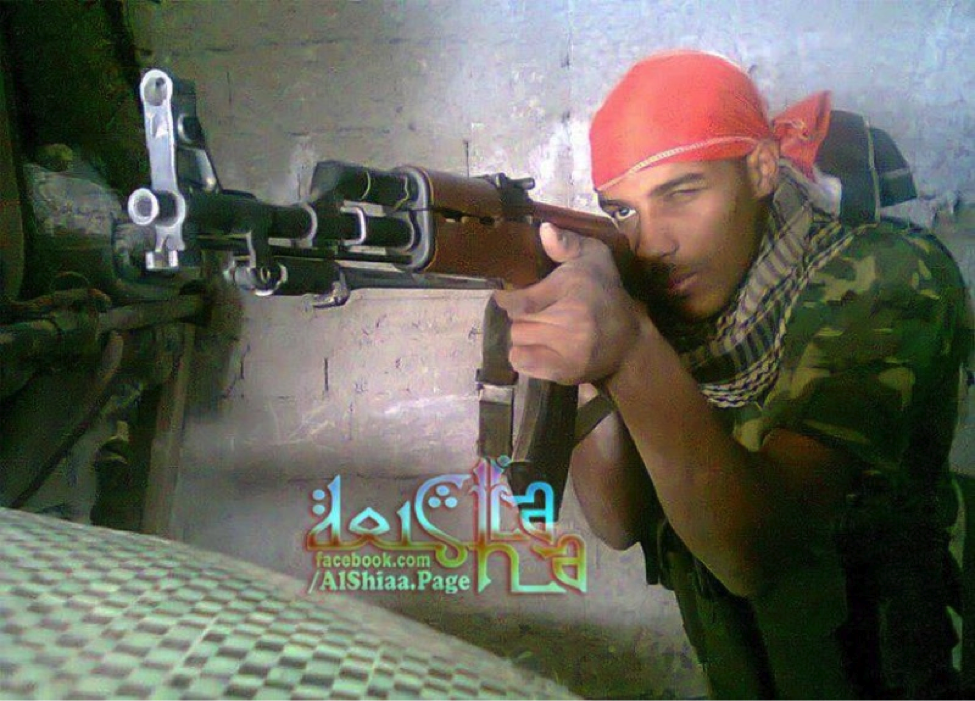 Figure 3: The original photo of Kuwni circulated on Facebook pages managed by pro-LAFA/LAFA administrators.
Called the, “First African martyr” for the Sayyidah Zaynab Shrine, Muhammed Suleiman al-Kuwni was reported dead on the pro-LAFA/LAFA administered “Al-Shiaa” Facebook page on July 26, 2013. One pro-LAFA Facebook page claimed Kuwni was killed due to injuries he suffered during fighting. Interestingly, Kuwni was not reported to be a member of Liwa’a Abu Fadl al-Abbas or of another announced Shia militia in Syria. Instead he was simply listed as a “Defender of…Zaynab”.
His death was later reported by Iranian media outlets on July 27, 2013.[8] On that same day Iranian media started covering Kuwni’s story, Hizballah’s SouthLebanon.org webpage also included a prayer for him.[9] Most importantly, both Iranian and pro-LAFA Arabic language sources reported Kuwni was originally from the West African state of Côte d`Ivoire, home to almost half a million Shia Muslims.[10]
Stories about Kuwni did not include details on any burial plans. Additionally, more comprehensive information covering his family, or a detailed biography stating where he was originally from in Côte d`Ivoire was also not presented.
Hizballah and Iranian activities have been rather extensive in West Africa.[11] According to the U.S. Department of Treasury, Hizballah has also pieced together an extensive fundraising and recruiting network in Côte d`Ivoire.[12] It is possible Kuwni passed through Hizballah recruitment in Africa, was trained (likely in Lebanon), and was then deployed to fight in Syria. However, his case remains unique and unusual. Iran has primarily utilized Arabic-speaking proxies from Iraq and Lebanese Hizballah to bolster Assad. The addition of African fighters demonstrates Tehran is more open to using proxies from all over the world.
[1] See: https://www.syriaonline.sy/?f=Details&catid=12&pageid=4174.
[2] See: https://www.khaama.com/afghans-involvement-in-syria-war-to-be-investigated-mosazai-1562
[3] See: https://algadtv.com/?p=53142
[4] See: https://freehalab.wordpress.com/2013/06/06/assads-foreign-jihadists-and-mercenaries/
[5] Grant Farr, “The Hazara of Central Afghanistan”, in Barbara Brower and Barbara Rose Johnston (eds.), Disappearing Peoples?: Indigenous Groups and Ethnic Minorities in South and Central Asia, (Walnut Creek, California: Left Coast Press, Inc., 2007), P. 164.
[6] See: https://www.hazara.net/news/news2012/khoemini/khoemini-anniversary-kabul.html. See also: https://www.brianglynwilliams.com/pdfs/20120301114407597.pdf and https://www.csmonitor.com/2005/0824/p06s01-wosc.html.
[7] See: https://www.khaama.com/afghans-involvement-in-syria-war-to-be-investigated-mosazai-1562.
[8] The first Iranian story covering Kuwni’s death was published by Iran’s AhlulBayt News Agency. See: https://www.abna.ir/data.asp?lang=1&id=445548. The same story and published photograph have been reproduced by a number of Iranian news websites. See: https://valieamr.com/Default.aspx?PageName=news&ID=20336&Language=1, https://eslamabadkhabar.ir/shownews.php?idnews=42108, and https://www.fardanews.com/fa/news/276512/%D8%B4%D9%87%D8%A7%D8%AF%D8%AA-%D9%86%D8%AE%D8%B3%D8%AA%DB%8C%D9%86-%D8%A2%D9%81%D8%B1%DB%8C%D9%82%D8%A7%DB%8C%DB%8C-%D9%85%D8%AF%D8%A7%D9%81%D8%B9-%D8%AD%D8%B1%D9%85%D8%B9%DA%A9%D8%B3.
[9] See: https://www.southlebanon.org/?p=79659.
[10] Shireen Hunter, Iran’s Foreign Policy in the Post-Soviet Era: Resisting the New International Order, (Santa Barbara, California: Praeger, 2010), P. 227.
[11] In Nigeria, Hizballah has been involved in maintaining arms caches and the creation of groups pushing Iranian revolutionary ideology. Nigeria even has its own political organization (the Islamic Movement of Nigeria) which was created as a near mirror image of Lebanese Hizballah. See: https://www.islamicmovement.org/ and https://www.bbc.co.uk/news/world-africa-17908704. See also: https://www.foxnews.com/world/2013/07/12/nigeria-judge-refuses-bail-for-3-lebanese-nigerians-accused-hoarding-hezbollah/ and https://www.haaretz.com/news/features/.premium-1.530327. For some earlier examples (2009-2010) of Iranian diplomatic, cultural, and financial moves in West Africa, see: https://www.irantracker.org/analysis/ahmadinejad-west-africa-iranian-outreach-reveals-tehran-foreign-policy-aug-3-2010-3242. See also: https://www.aei.org/article/foreign-and-defense-policy/regional/subsaharan-africa/forgotten-africa-turns-to-iran-as-a-result-of-western-neglect/.
[12] See: https://www.treasury.gov/press-center/press-releases/Pages/jl1980.aspx and https://www.treasury.gov/press-center/press-releases/Pages/tg149.aspx.
Figure 3: The original photo of Kuwni circulated on Facebook pages managed by pro-LAFA/LAFA administrators.
Called the, “First African martyr” for the Sayyidah Zaynab Shrine, Muhammed Suleiman al-Kuwni was reported dead on the pro-LAFA/LAFA administered “Al-Shiaa” Facebook page on July 26, 2013. One pro-LAFA Facebook page claimed Kuwni was killed due to injuries he suffered during fighting. Interestingly, Kuwni was not reported to be a member of Liwa’a Abu Fadl al-Abbas or of another announced Shia militia in Syria. Instead he was simply listed as a “Defender of…Zaynab”.
His death was later reported by Iranian media outlets on July 27, 2013.[8] On that same day Iranian media started covering Kuwni’s story, Hizballah’s SouthLebanon.org webpage also included a prayer for him.[9] Most importantly, both Iranian and pro-LAFA Arabic language sources reported Kuwni was originally from the West African state of Côte d`Ivoire, home to almost half a million Shia Muslims.[10]
Stories about Kuwni did not include details on any burial plans. Additionally, more comprehensive information covering his family, or a detailed biography stating where he was originally from in Côte d`Ivoire was also not presented.
Hizballah and Iranian activities have been rather extensive in West Africa.[11] According to the U.S. Department of Treasury, Hizballah has also pieced together an extensive fundraising and recruiting network in Côte d`Ivoire.[12] It is possible Kuwni passed through Hizballah recruitment in Africa, was trained (likely in Lebanon), and was then deployed to fight in Syria. However, his case remains unique and unusual. Iran has primarily utilized Arabic-speaking proxies from Iraq and Lebanese Hizballah to bolster Assad. The addition of African fighters demonstrates Tehran is more open to using proxies from all over the world.
[1] See: https://www.syriaonline.sy/?f=Details&catid=12&pageid=4174.
[2] See: https://www.khaama.com/afghans-involvement-in-syria-war-to-be-investigated-mosazai-1562
[3] See: https://algadtv.com/?p=53142
[4] See: https://freehalab.wordpress.com/2013/06/06/assads-foreign-jihadists-and-mercenaries/
[5] Grant Farr, “The Hazara of Central Afghanistan”, in Barbara Brower and Barbara Rose Johnston (eds.), Disappearing Peoples?: Indigenous Groups and Ethnic Minorities in South and Central Asia, (Walnut Creek, California: Left Coast Press, Inc., 2007), P. 164.
[6] See: https://www.hazara.net/news/news2012/khoemini/khoemini-anniversary-kabul.html. See also: https://www.brianglynwilliams.com/pdfs/20120301114407597.pdf and https://www.csmonitor.com/2005/0824/p06s01-wosc.html.
[7] See: https://www.khaama.com/afghans-involvement-in-syria-war-to-be-investigated-mosazai-1562.
[8] The first Iranian story covering Kuwni’s death was published by Iran’s AhlulBayt News Agency. See: https://www.abna.ir/data.asp?lang=1&id=445548. The same story and published photograph have been reproduced by a number of Iranian news websites. See: https://valieamr.com/Default.aspx?PageName=news&ID=20336&Language=1, https://eslamabadkhabar.ir/shownews.php?idnews=42108, and https://www.fardanews.com/fa/news/276512/%D8%B4%D9%87%D8%A7%D8%AF%D8%AA-%D9%86%D8%AE%D8%B3%D8%AA%DB%8C%D9%86-%D8%A2%D9%81%D8%B1%DB%8C%D9%82%D8%A7%DB%8C%DB%8C-%D9%85%D8%AF%D8%A7%D9%81%D8%B9-%D8%AD%D8%B1%D9%85%D8%B9%DA%A9%D8%B3.
[9] See: https://www.southlebanon.org/?p=79659.
[10] Shireen Hunter, Iran’s Foreign Policy in the Post-Soviet Era: Resisting the New International Order, (Santa Barbara, California: Praeger, 2010), P. 227.
[11] In Nigeria, Hizballah has been involved in maintaining arms caches and the creation of groups pushing Iranian revolutionary ideology. Nigeria even has its own political organization (the Islamic Movement of Nigeria) which was created as a near mirror image of Lebanese Hizballah. See: https://www.islamicmovement.org/ and https://www.bbc.co.uk/news/world-africa-17908704. See also: https://www.foxnews.com/world/2013/07/12/nigeria-judge-refuses-bail-for-3-lebanese-nigerians-accused-hoarding-hezbollah/ and https://www.haaretz.com/news/features/.premium-1.530327. For some earlier examples (2009-2010) of Iranian diplomatic, cultural, and financial moves in West Africa, see: https://www.irantracker.org/analysis/ahmadinejad-west-africa-iranian-outreach-reveals-tehran-foreign-policy-aug-3-2010-3242. See also: https://www.aei.org/article/foreign-and-defense-policy/regional/subsaharan-africa/forgotten-africa-turns-to-iran-as-a-result-of-western-neglect/.
[12] See: https://www.treasury.gov/press-center/press-releases/Pages/jl1980.aspx and https://www.treasury.gov/press-center/press-releases/Pages/tg149.aspx.
Hizballah Cavalcade: Liwa’a ‘Ammar Ibn Yasir: A New Shia Militia Operating In Aleppo, Syria
NOTE: For prior parts in the Hizballah Cavalcade series you can view an archive of it all here.
—
Liwa’a ‘Ammar Ibn Yasir: A New Shia Militia Operating In Aleppo, Syria
By Phillip Smyth ([email protected])
Click here for a PDF version of this post
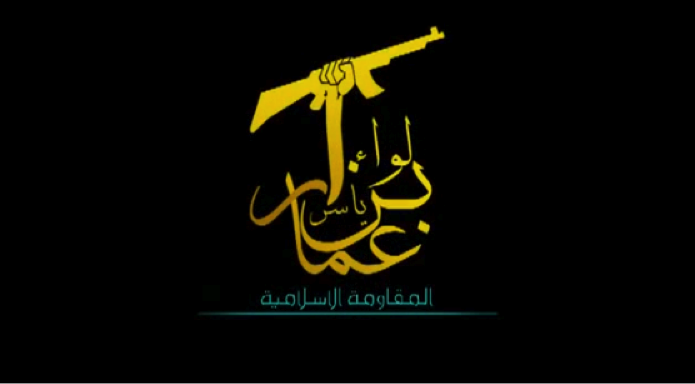
Figure 1: The logo for Liwa’a ‘Ammar Ibn Yasir. The group’s name is stylized into a pattern which includes the Lebanese Hizballah/Iranian Revolutionary Guard Corps style symbol of a fist gripping an AK-47. (In Gold) “Liwa’a ‘Ammar Ibn Yasir” (‘Ammar Ibn Yasir Brigade) and (in blue) “Al-Muqawama al-Islamiya” (“The Islamic Resistance”).
Since the first announcement of organized Iraqi Shia fighting on behalf of the Assad regime in Syria, their geographic displacement in the country was often matched with their propaganda statements. Both Liwa’a Abu Fadl al-Abbas and Liwa’a Zulfiqar have stated on their multitude of social media platforms, videos, and through photographs, that their primary area of operation is Damascus. In particular, the Saydah Zaynab Shrine features heavily in their propaganda and the groups are self-proclaimed “Defenders” of the Shrine.
However, with the creation of Liwa’a ‘Ammar Ibn Yasir (‘Ammar Ibn Yasir Battalion or LAIY), the “Defenders of the Saydah Zaynab Shrine” narrative is now encompassing an organization which—according to its statements and other sources—does not operate in Damascus or directly maintain a presence at the Saydah Zaynab Shrine. In fact, LAIY advertises the fact that it is operating in the areas surrounding the northern Syrian city of Aleppo. In videos released by the group onto YouTube, the films’ titles proclaim LAIY fighters are present in rural sections of Aleppo. While this could not be independently confirmed, it would appear the group is attempting to cast another narrative that LAIY is the pro-Assad Shia militia organization which handles combat operations in the Aleppo area.
The fact the group is announcing it is operating in Aleppo is very important when assessing the manner Iranian-backed Shia militias have been utilized in Syria. Initially, most analysts and journalists have acknowledged these groups have fought around the Saydah Zaynab Shrine in Damascus or, as with Lebanese Hizballah, fought at Qusayr. This represents a major departure from the accepted line and shows that Iraqi-staffed Shia militias are likely operating in other urban areas throughout the country.
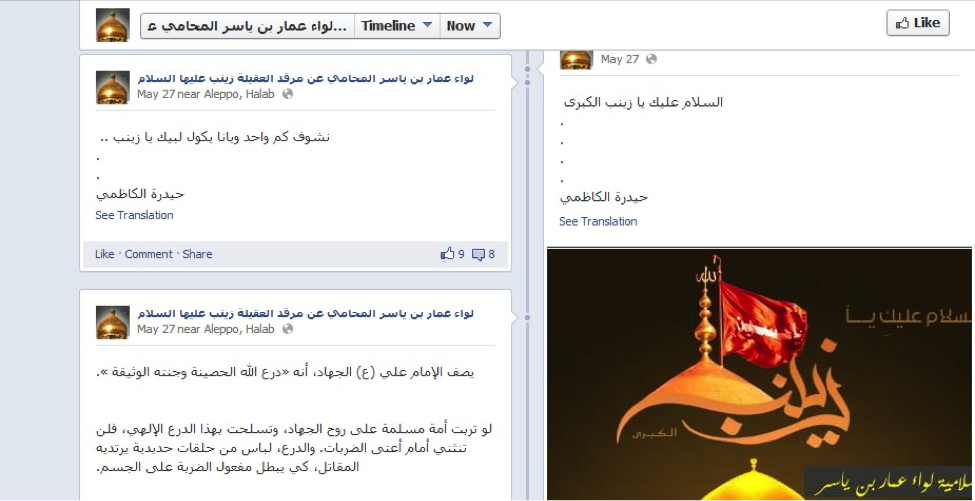
Figure 2: Since the creation of LAIY’s official Facebook page, the group has made attempts to demonstrate they are posting statuses from Aleppo.
Initially, LAIY announced their presence to the world through the creation of a Facebook page made at the end of May, 2013. The page only posted basic status updates including quotes from Lebanese Hizballah General Secretary and in a blatant display of their loyalty to Iran, postings of two photographs featuring Iranian Supreme Leader Ayatollah Ali Khamenei. The caption for one of the photographs read, “Labayka ya Khamenei” (“We are here for you, O Khamenei”). Other early photographs emphasized the same “Defenders of the Saydah Zaynab Shrine” narrative first promoted by Liwa’a Abu Fadl al-Abbas and Lebanese Hizballah.
The logic behind the continuance of the “Defenders of the Saydah Zaynab Shrine” narrative for a group not directly defending it, is likely a way to express that despite LAIY not directly defending the shrine, the very fact they are countering anti-Assad forces in other parts of Syria helps save the shrine. Extending the narrative in this way allows for later potential announcements addressing the presence of other pro-Assad Shia militia in other areas of Syria. The rhetoric also acts and as a blanket explanation for why the groups’ directly cooperate and back the regime of Bashar al-Assad. For LAIY’s messaging campaign, it is key to demonstrate that backing Assad on all fronts means the Saydah Zaynab Shrine and other Shia religious structures will be protected.
Off of the internet, LAIY made its presence known in the same way Kata’ib Sayyid al-Shuhada did during the Spring of 2013; Via extravagant funeral cum demonstrations for fallen members of the organization. On June 4, a large funeral in Iraq’s Maysan was held for seven members of LAIY. Like Kata’ib Sayyid al-Shuhada, at the group funeral, representatives from the organization announced they would defend shrines, “All over the world”.[1]
LAIY has also exhibited a number of advanced messaging strategies. When the organization was announced, it already had its own song (posted below), a symbol, fighters dressed in similar combat fatigues, and a clear messaging strategy to address its presence in Syria.
LAIY’s Name
Liwa’a ‘Ammar Ibn Yasir takes its name from ‘Ammar Ibn Yasir. Described by historian Matti Moosa as, “one of Ali’s [considered by Shia to be the Islamic prophet Muhammed’s true successor for leadership of the Muslim community] most zealous companions and champions”, Yasir is revered by Shia for his loyalty.[2]
The group’s name also references the tomb of ‘Ammar Ibn Yasir which was located in Raqqa, Syria. The tomb was blown-up by Sunni Islamist rebels forces in March, 2013. These forces also recorded the destruction of the tomb and distributed their video online.[3] The video then made its rounds on pro-Assad media outlets. In terms of narrative development, the adoption of the name of a destroyed Shia shrine in Syria further underlines the line the group previously established as, “Defenders of shrines”.
Nevertheless, there have been no specific mentions of the destruction of ‘Ammar Ibn Yasir’s tomb via the group’s statements to the media or through their social media presence.
LAIY’s complete name is, Al-Muqawamah al-Islamiya fi Iraq Liwa’a ‘Ammar Ibn Yasir Hizballah al-Nujaba’ (The Islamic Resistance In Iraq ‘Ammar Ibn Yasir Brigade Hizballah Movement of the Outstanding). Adding further complication to the group, LAIY claims to be a part of Harakat Hizballah al-Nujaba’ or Harakat al-Nujaba’ (The Hizballah Movement of the Outstanding). This group, in and of itself, is also new. Harakat Hizballah al-Nujaba’ draws its name from the regularly used “Hizballah” term, a name found and utilized by a multitude of Iranian-backed organizations. It has also added that it is a “Harakat” or “movement”, most likely a way to appear as if it has greater numbers. The addition of the term, “al-Nujaba’” (plural for “The Outstanding”) references a term sometimes used in relation to the return of Imam al-Mahdi (for Shia, the Mahdi will return in a messianic form and establish a truly just earthly regime).[4]
LAIY’s Links, & Ideology
Based on the large amount of imagery, videos, and direct statements praising Iran’s Supreme Leader, Ayatollah Khamenei and repeated insistences where the group has said it is, “at Khamenei’s service”, LAIY does not hide its allegiance to Iranian leadership and ideology. The utilization of the exact “Defense of the Saydah Zaynab Shrine” narrative, honed by Lebanese Hizballah, Iran, and Iran’s many Iraqi Shia proxies—Many of whom have contributed fighters to the battle in Syria—also demonstrates a mirroring of larger Iranian strategies.
Sheikh Akram al-Kaabi, a founder and leader of Asa’ib Ahl al-Haq, an Iranian-backed organization which has lost members in Syria, has also featured prominently in LAIY propaganda. Al-Kaabi has described as a “Leader” by the group’s Facebook page and on posters the group has issued. The link to Asa’ib Ahl al-Haq further suggests LAIY and Harakat Hizballah al-Nujaba’ may be front groups for other existing Iranian-backed Iraqi Shia parties. Additionally, imagery used for martyrdom posters matches those found with Asa’ib Ahl al-Haq. These posters normally feature Grand Ayatollah Muhammed Sadiq al-Sadr and Iranian Supreme Leader, Grand Ayatollah Khamenei with a dark background or one featuring the Saydah Zaynab Shrine (see: Hizballah Cavalcade’s Roundup of Iraqi’s Killed in Syria, Parts 1, 2, and 3).
The utilization of the phrase, “Islamic Resistance” has also been a hallmark for Iranian-created organizations and has made a strong presence among the multitude of groups under Tehran’s guidance. Lebanese Hizballah calls itself, “Al-muqawama al-islamiya fi lubnan” (“The Islamic Resistance in Lebanon”).[5] Both Asa’ib Ahl al-Haq and Kata’ib Hizballah have characterized themselves as the “Islamic Resistance in Iraq”.[6]
Hizballah Cavalcade: Breaking Badr: Is Iraq’s Badr Organization Operating In Syria?
NOTE: For prior parts in the Hizballah Cavalcade series you can view an archive of it all here.
—
Breaking Badr: Is Iraq’s Badr Organization Operating In Syria?
By Phillip Smyth ([email protected])
Click here for a PDF version of this post
Due to many public funerals, a number of Iranian-backed Iraqi organizations (Asa’ib Ahl al-Haq, Kata’ib Hizballah, and Kata’ib Sayyid al-Shuhada stand as prime examples) have been identified as supplying combatants to fight in support of the regime of Bashar al-Assad in Syria. However, the Badr Organization, an Iraqi group which has pledged its loyalty to Tehran, was absent from announcements involving Iraqis killed in Syria and has been rather murky on whether it is fighting in Syria.
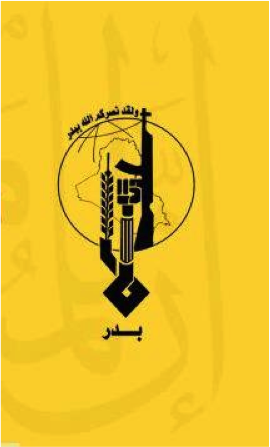
Figure 1: The Badr Organization Military Wing’s logo. Note its similarity to Lebanese Hizballah’s, Asa’ib Ahl al-Haq’s, Kata’ib Hizballah’s and the Iranian Revolutionary Guard Corps’ logos
In February, 2013, Hadi al-Amiri, leader of Iraq’s Badr Organization, said Turkey and Qatar were supplying Al Qa’ida and that this was a declaration of war against Iraq.[1] During a June 21, 2013 interview with Reuters, Amiri said the group was contemplating intervening in Syria and could not, “sit idle while the Shi’ites are being attacked”. [2] Regardless, after assessing posted material issued by the Badr Organization’s social media webpages, it is becoming clear the group may actually be involved in the fighting in Syria.
Beginning life as the Badr Brigade, the militia for the Supreme Council for the Islamic Revolution in Iraq (SCIRI), the Badr Organization split from SCIRI and became its own political group.[3] In 2006, the Council on Foreign Relations reported the Badr Organization had upwards of 10,000 militiamen.[4]
Before and after the split with SCIRI, the Badr Organization received heavy funding, training, and equipment from Iran.[5] The group is also unabashed about its close links with Iran, especially Iranian Supreme Leader Ayatollah Ali Khamenei, and Iranian proxy groups.
Despite material which affirms the group supports the actions of Lebanese Hizballah in Syria, the official Facebook page for the Badr Organization makes no mention that its militiamen may be also operating in Syria. Nevertheless, there are hints of involvement on the group’s page for the Badr Organization Military Wing, the Badr Organization’s militia. Throughout the Spring of 2013, the Badr Organization increased the level of supportive rhetoric for Lebanese Hizballah, Asa’ib Ahl al-Haq, Kata’ib Hizballah, and Iran’s efforts in Syria. A June 21, 2013 photo’s caption said the, “Badr Military Wing will defend Zaynab to the last mujahid”.
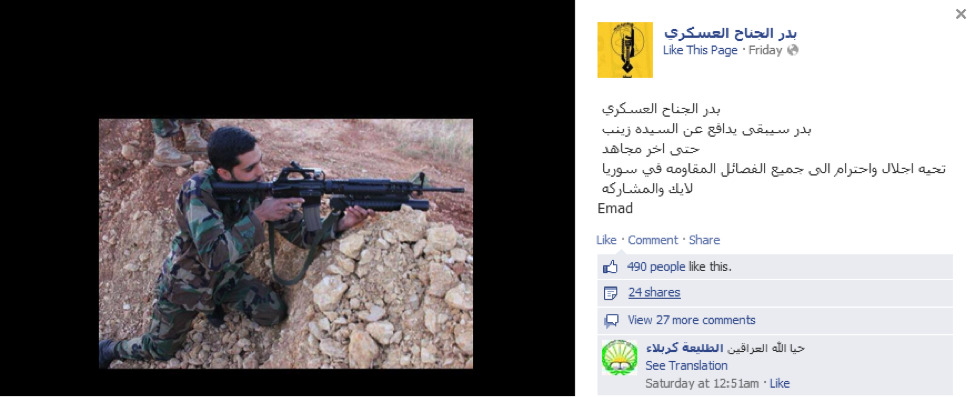
Figure 2: Photo from the Badr Organization Military Wing’s Facebook saying the group will “Defend the Zaynab Shrine to the last holy warrior [mujahid]”.
Earlier, on April 22, 2013, The Badr Organization Military Wing produced and uploaded a song to YouTube. The song’s discription said it was, “A message from Badr to the unjust”and included the lyrics, “We will issue a death sentence against the Free Syrian Army (Jaysh al-Hurr) and no one will be able to defeat us.” The only images present during the music were those of a fighter armed with an RPG-7 in front of the Saydah Zaynab Shrine, the logo for the Badr Organization Military Wing, and the logo for the Badr Organization.
From May 5-9, 2013, a few photographs depicting Badr Organization fighters showing their “Soliderity” with members of Liwa’a Abu Fadl al-Abbas (LAFA) appeared on various pro-LAFA, Badr Organization, and pro-Lebanese Hizballah websites. LAFA has acted as the main front for pro-Iranian fighters inside Syria.
Nevertheless, Badr’s symbols are not a pervasive presence on LAFA or Liwa’a Zulfiqar’s social media websites. Since the group reportedly did not suffer any killed in Syria before June, coverage of the organization’s possible involvement with LAFA or Liwa’a Zulfiqar was muted. The group’s social media posts appeared to do little more than offer visible support for the actions of other pro-Iranian Iraqi groups operating in Syria.
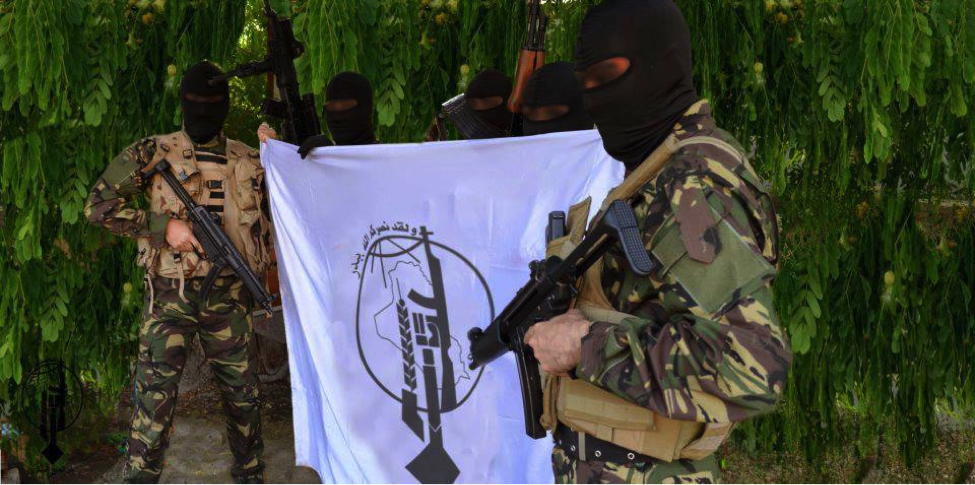
Figure 3: The photo was first posted on the Badr Organization Military Wing’s official and mirror Facebook pages. The photo shows Badr militiamen armed with Heckler and Koch MP5 submachine guns (though, it’s possible these are Iranian copies) and AK-47 style rifles.
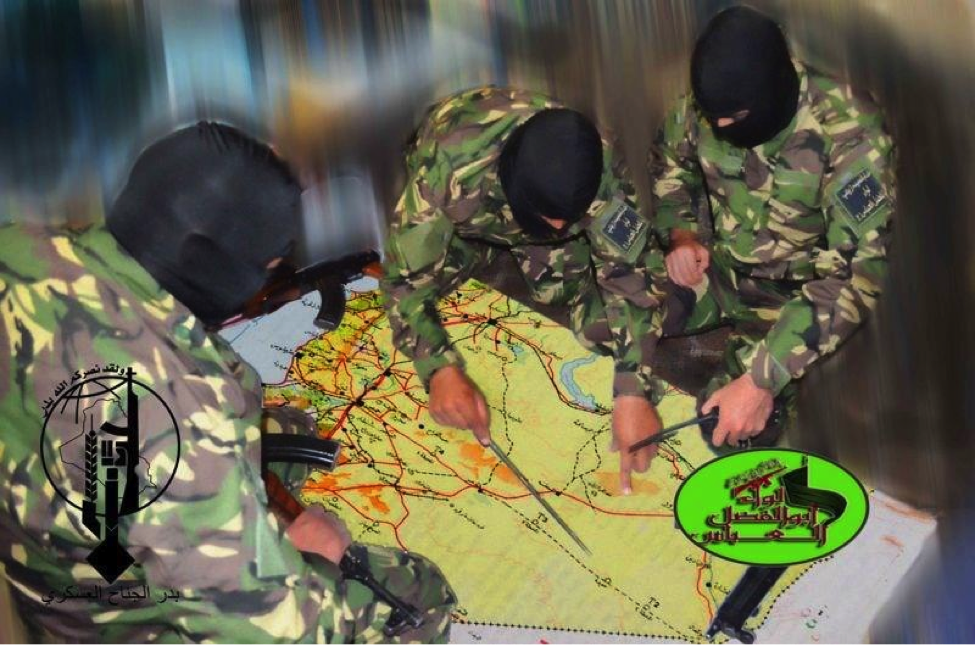
Figure 4: A photo first posted on Liwa’a Abu Fadl al-Abbas’s Facebook page claims to show Badr Organization militiamen studying a map of Syria. Most captions to go along with this photo claimed it was a photo to express solidarity with the defenders of the Zaynab Shrine.
However, the Badr Organization’s public statements regarding Syria grew louder after May 20, 2013. Immediately following attacks on buses carrying Iranian pilgrims near the Iraqi city of Tikrit, the Badr Organization Military Wing announced they would adopt a more threatening posture. [6] The statement said the “Plotters” of the attacks were the United States, Saudi Arabia, Qatar, and “The Zionist Entity” (Israel), and that they would face a swift retaliation. It is important to note that the same compendium of enemies is blamed by Iran and its proxies operating in Syria for being behind forces opposing the regime of Bashar al-Assad. Interestingly, notwithstanding the other, often more horrific bombings Iraqi Shia suffered, and other attacks launched by Sunni Islamists against Shia in Iraq, the Badr Organization appeared to draw a redline with the attack on the Iranians. It is also possible the targeted bus was not carrying Iranian pilgrims as reported, but Iranian advisors or fighters, which would further inflame a pro-Iranian proxy group like Badr.[7]
Based on the fact that other smaller Iranian-backed Iraqi Shia groups have sent fighters into Syria, it is possible the Badr Organization has also sent members. This possibility gained added credence on June 17, 2013 when the Badr Organization Military Wing announced a member had been killed “Defending the Saydah Zaynab Shrine”. Despite this announcement, it is still unclear whether the Badr Organization has committed sizable amounts of fighting men to the war in Syria.
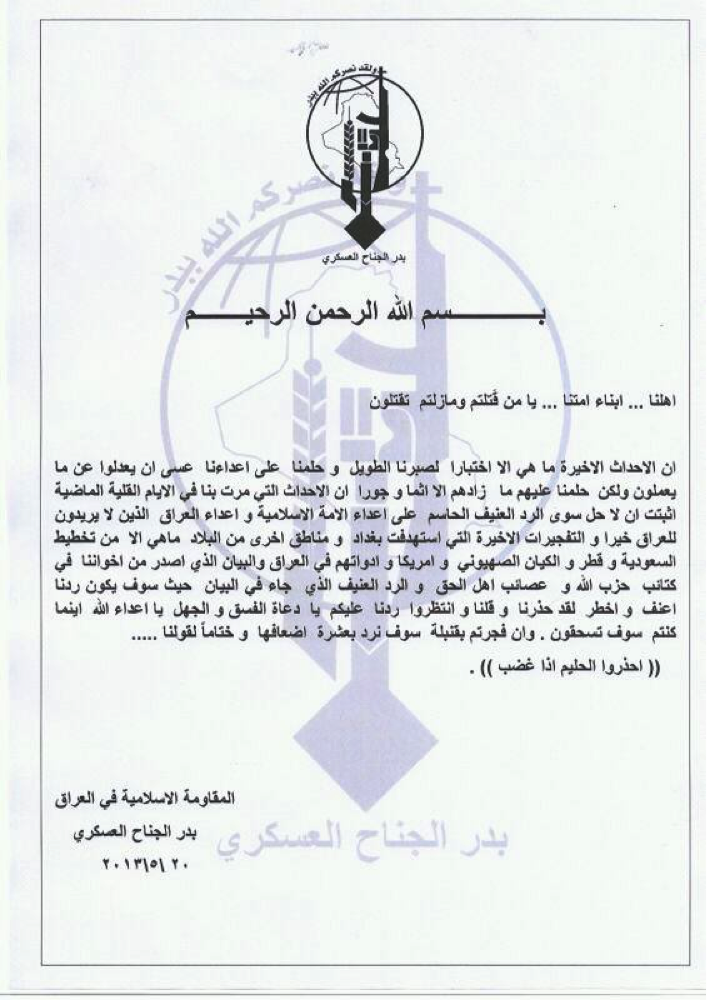
Figure 5: May 20, 2013 Badr statement threatening Saudi Arabia, Qatar, “The Zionist entity”, and the U.S.
The Badr Organization’s First Martyr In Syria?
Name: Yasin Muhammed al-Zayn (A.K.A. Hadi)
Death Announced: June 17, 2013. (He was declared killed on June 17, 2013). The Badr Organization Military Wing’s Facebook declared his death on June 18, 2013.
Notes: Only on the Badr Organization Military Wing’s official page was al-Zayn claimed as a member of the Badr Organization. On his martyrdom poster, it was claimed al-Zayn was killed in the Zayn al-‘Abideen neighborhood of Damascus while “Defending the Saydah Zaynab Shrine”. Other pro-Assad/pro-Iranian backed Shia organization Facebook pages did not mention his affiliation with the Badr Organization. Additionally, no footage of al-Zayn’s funeral could be located. A personal martyrdom page was also created (on June 18, 2013) for al-Zayn.[8] On the page, no mention of any Badr affiliations was made. Interestingly, his death was not claimed by Liwa’a Abu Fadl al-Abbas or Liwa’a Zulfiqar, the two groups Iraqi Shia have fought for in Syria.


Figure 6: The Saydah Zanab Shrine’s golden dome features prominently in the background. No logos for the Badr Organization Military Wing were present on the martyrdom poster.
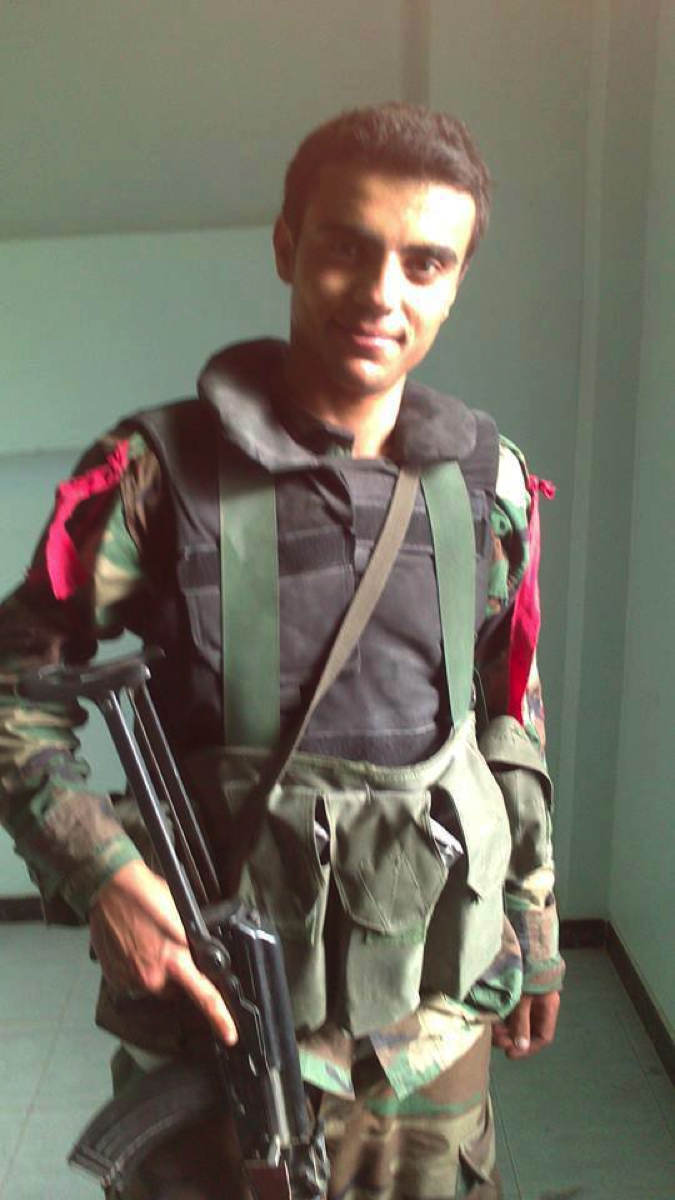
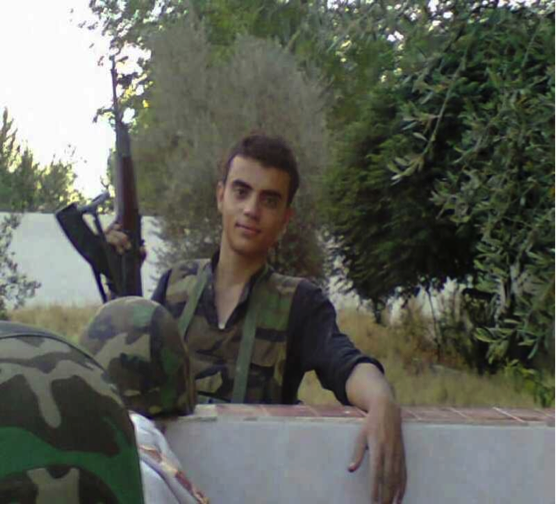
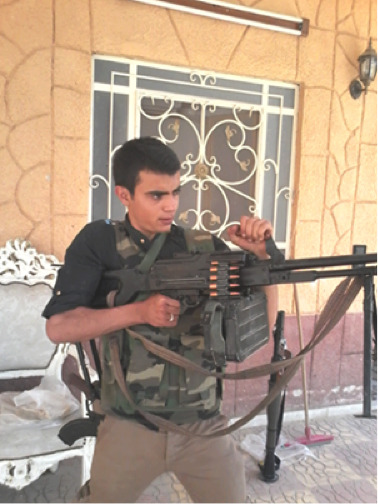
The Badr Organization’s Imagry For Syria
The Badr Organization Military Wing has created a number of provocative online photos dealing with events in Syria. When compared to other Iranian proxies, they have exhibited the most blatant links to Iran’s Supreme Leader. It is possible the group may be setting-up a religious pretext for their [future] involvement in Syria by continually showing pictures of Khamenei. Khamenei had already given religious sanction for Shia fighters to engage in battle in Syria.[9]
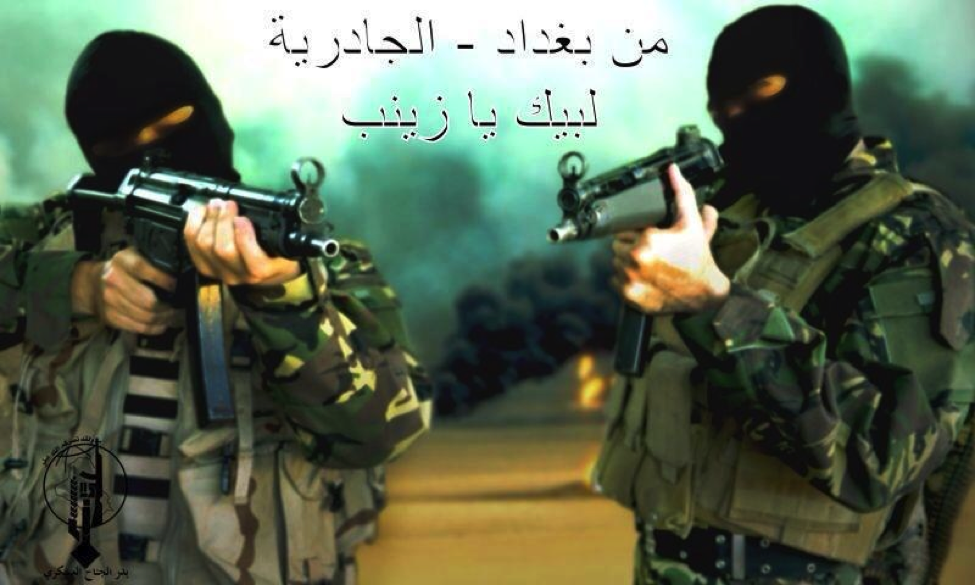
Figure 7: “Min Baghdad – al-Jadriat Labayk ya Zaynab” (“From Baghdad – al-Jadriya [a Baghdad neighborhood] We are here for you, O Zaynab”).
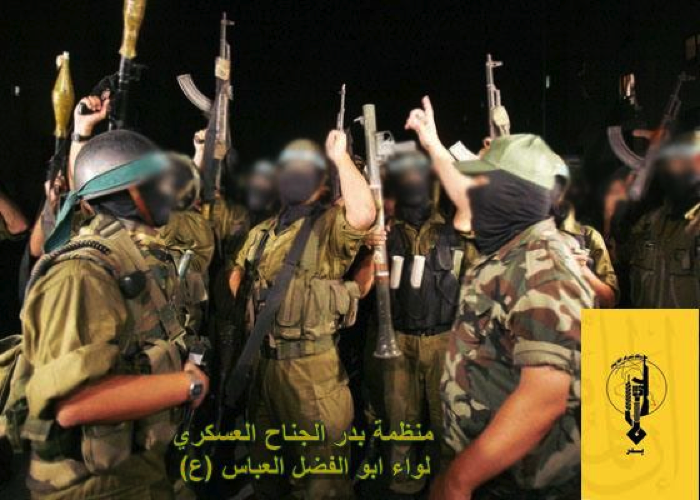
Figure 8: A photo published by the Badr Organization Military Wing showing members of Liwa’a Abu Fadl al-Abbas. The image is attempting to convey that the Badr Organization has members within LAFA.
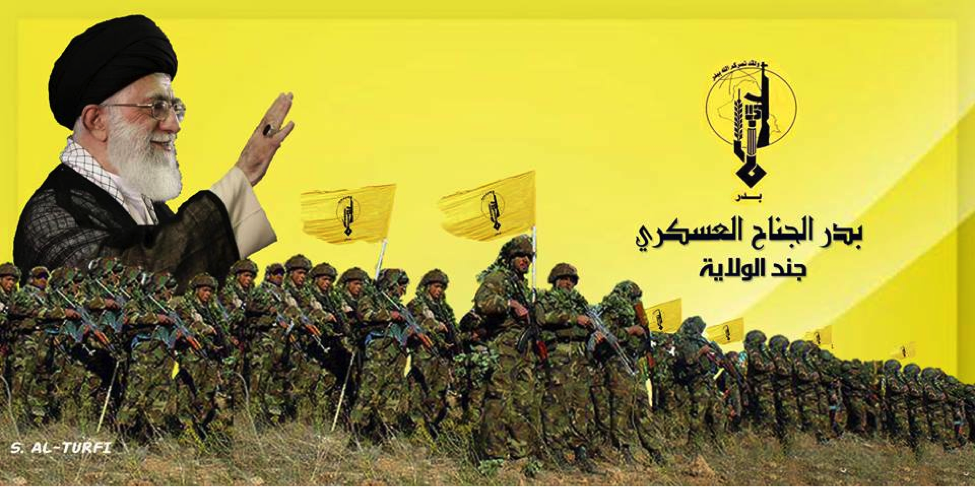
Figure 9: Iran’s Supreme Leader waves and smiles as Badr Organization militiamen stand below him.
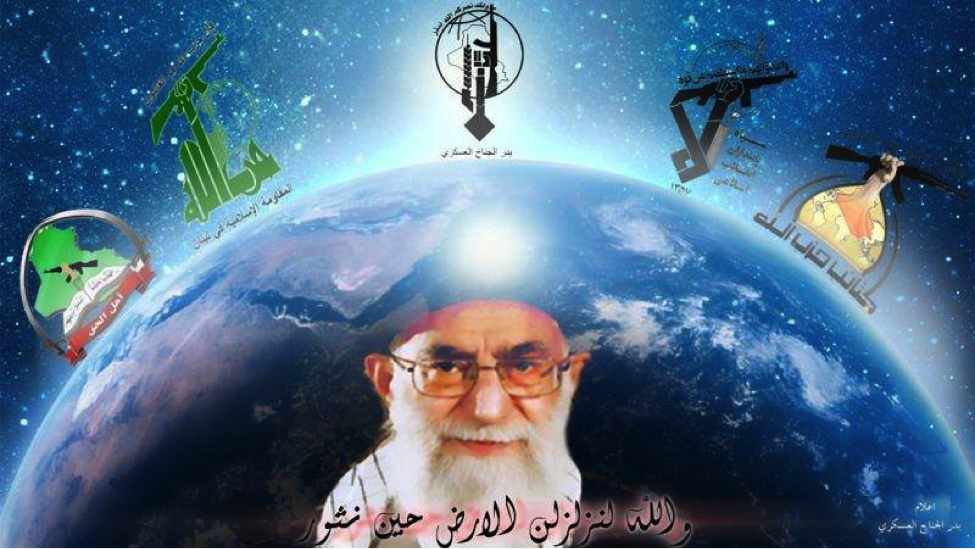
Figure 10: This photo appeared on two pro-Badr Organization Military Wing pages on Facebook. Intriguingly, the photo is extremely blatant about the connection (logos from left to right) Asaib Ahl al-Haq, Lebanese Hizballah, the Badr Organization, the Iranian Revolutionary Guard Corps, and Kata’ib Hizballah share. Iranian Supreme Leader Ayatollah Khamenei looks out from the globe.
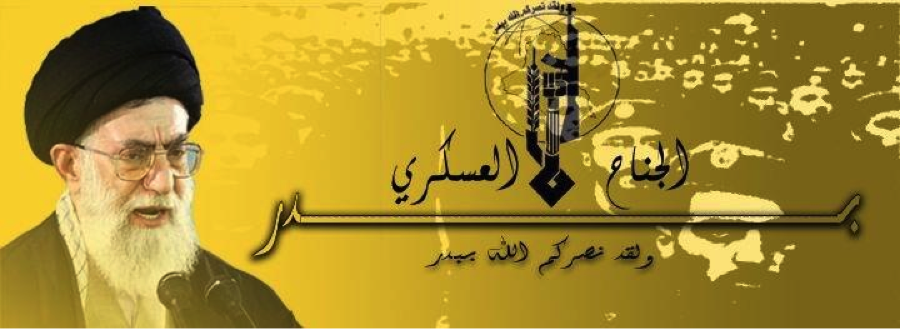
Figure 11: Another online poster featuring the Badr Organization Military Wing and Iranian Supreme Leader Ayatollah Khamenei. The background is a photo of Lebanese Hizballah marching with an added golden hue. [1] Michael Knights, “Syrian and Iraqi Conflicts Show Signs of Merging”, March 7, 2013, Policywatch 2042, Washington Institute For Near East Policy, https://www.washingtoninstitute.org/policy-analysis/view/syrian-and-iraqi-conflicts-show-signs-of-merging. [2] See: https://www.trust.org/item/20130621144421-omxch. [3] See: https://en.aswataliraq.info/(S(clhorg45ylfsgrrhg3vbwlmb))/Default1.aspx?page=article_page&id=147369&l=1. [4] See: https://www.cfr.org/iraq/iraqs-militia-groups/p11824#p6. [5] See: https://www.mcclatchydc.com/2005/12/12/v-print/13157/iran-gaining-influence-power-in.html. [6] See: https://now.mmedia.me/lb/en/mena/8-dead-in-iraq-bomb-attack-on-iran-pilgrims-officials-say. [7] Personal conversation with Michael Knights, June 24, 2013. [8] See: https://www.facebook.com/KlnaAlshhydAlmjahdYasynMhmwdAlzyn. [9] See:
